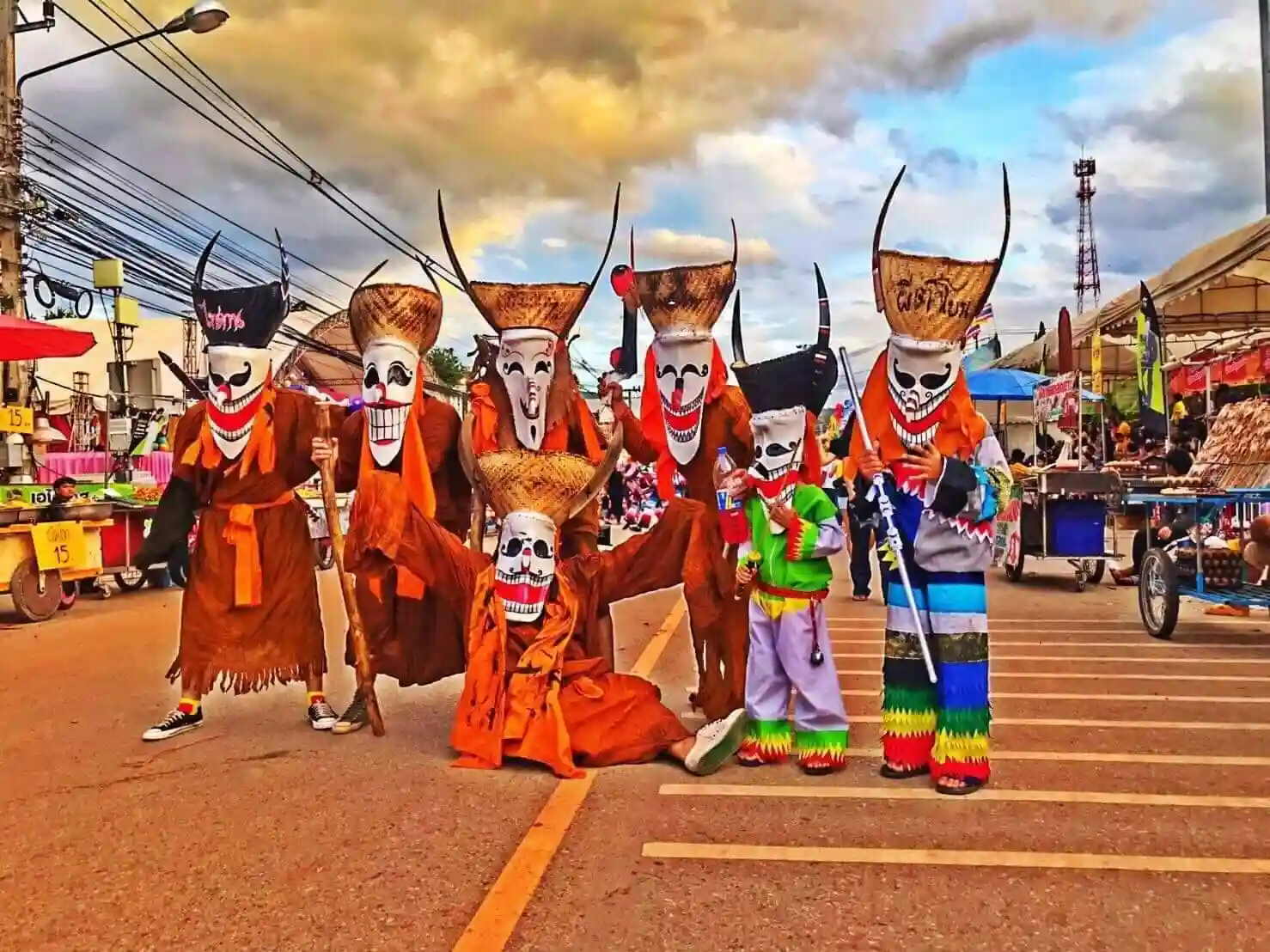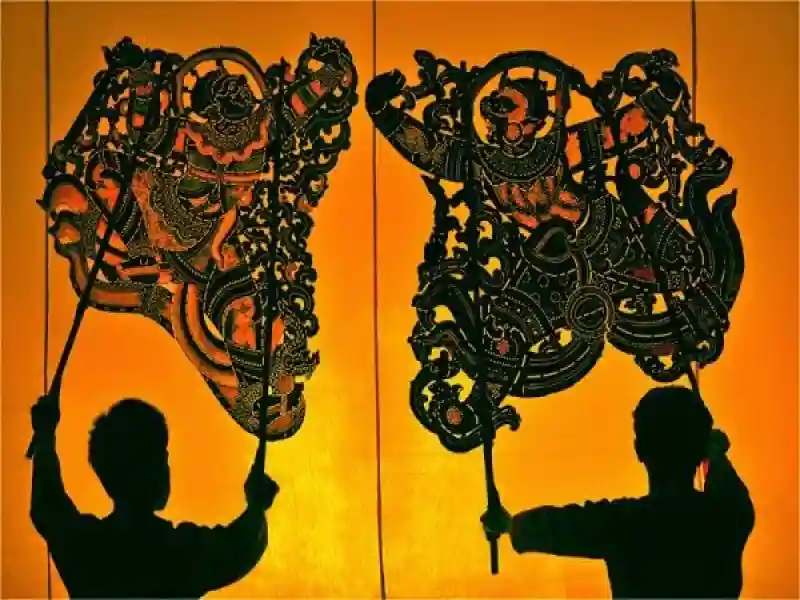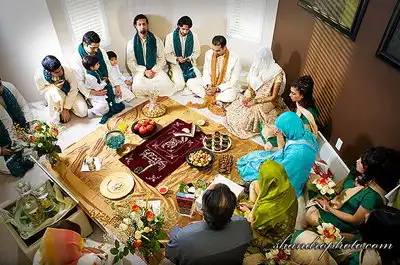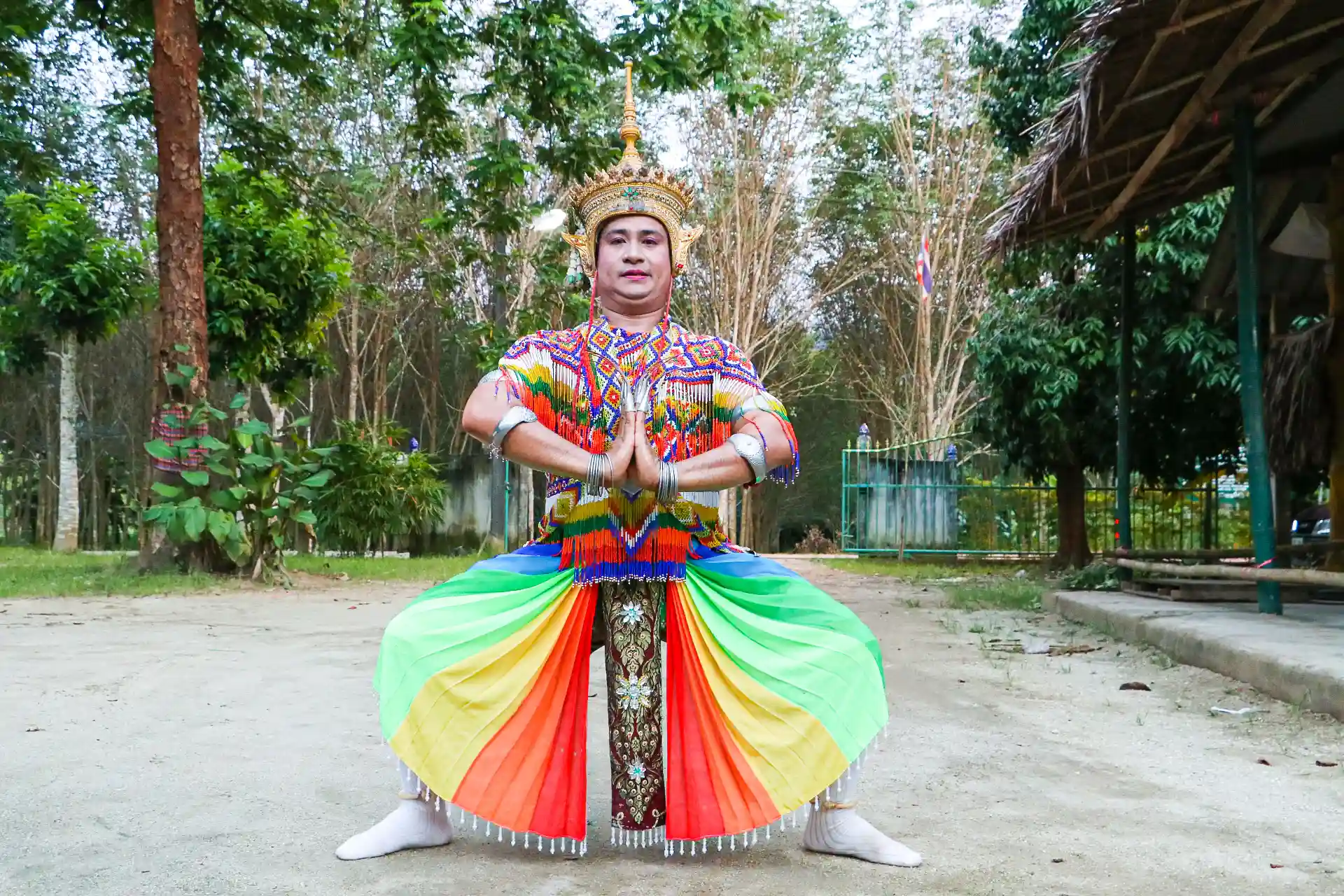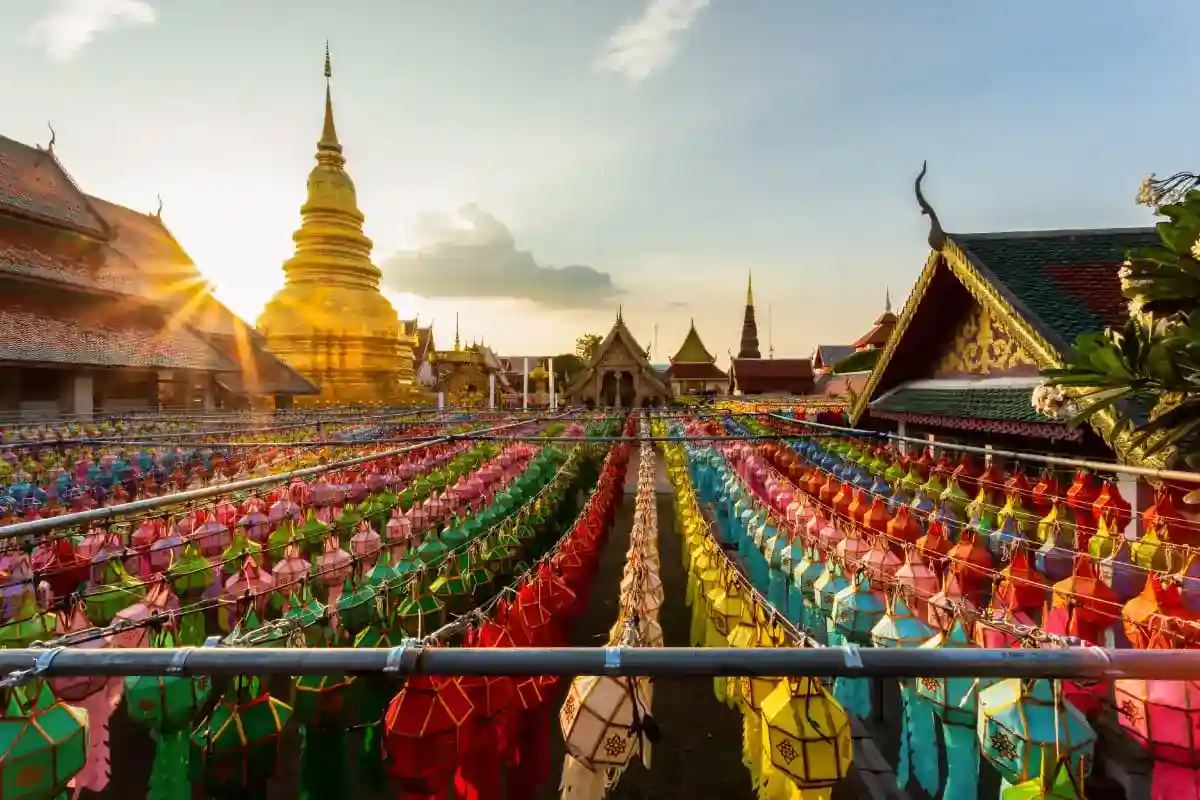
Thai Traditions
Culture It's what man created. established without acting on instinct To be used in their own society, and culture will appear in the form of a system of thoughts, actions and existence, which are all man-made and concocted.
Traditions are things that human beings have established for the welfare of human beings. Social life will not be peaceful. If there is no backing tradition, the tradition of the society is not It is a certain thing that is fixed or cannot be changed. contrary to tradition can occur and disintegrate when the social environment changes, knowledge and understanding of nature expands Scientific inventions expand. Having contact with other societies has different ways. needs and opportunities to make life comfortable must find a new way In accordance with the environment, when it is accepted, it will become a new tradition. Improvements to suit social conditions change the tradition.

Tradition is an activity that has been practiced continually. is unique and important to society, such as dress, language, culture, religion, arts, laws, morality, beliefs, etc., which are the origin of the culture of Various ethnic societies have become national traditions and are transmitted in succession. If the tradition is already good, keep it. keep it as a national culture, if not good, change according to the season Traditions are all influenced by external environment that enters society adopt a variety of practices to mix in life, traditions known as way of life of society Especially the religion which has the most influence on Thai traditions. Wat Wa The monasteries in Thailand reflect the influence of Buddhism on Thai society and show that the Thai people. The importance of nurturing Buddhism with beautiful arts for use in religious ceremonies since ancient times.
Thai culture, Wai Thai etiquette that is a greeting culture Time to meet or leave It represents a sense of reverence. and mutual respect There are 3 levels of wai, using the thumb and face as the position as follows:

- Wai level 1 is used for paying homage to the Three Jewels such as the Buddha, the Dharma and the monks, including ancient sites. Buddhist antiques by placing the thumb between the eyebrows The index finger touches the upper part of the forehead.
- Level 2 Wai is used for paying homage to father, mother, grandfather, grandmother, grandfather, grandmother, teacher, teacher and those who we have high respect for. by keeping the thumb touching the tip of the nose index finger touch between eyebrows
Level 3 Wai is used for paying respect to general people who are not much older than me. It can also be used to show respect to those who are equal or friends. by keeping the thumb touching the tip of the chin The index finger touches the tip of the nose.
But those who pay respects will receive respect in return. Those who respect will be respected in return. Is Thai etiquette.

Traditions originate from social conditions, nature, attitudes, identity, values by beliefs of people in society. To things that have superhuman powers, such as the power of the weather and events that occur for unknown reasons. Therefore, when disaster strikes, human beings must pray for what they think will help when the disaster has passed. Human beings show their gratitude to those things by performing rituals for their own good fortune according to their beliefs and knowledge. Behavior that people in society adhere to as customs or formalized and made it into print the same, continued until it became a tradition of that society, tradition and culture. The same thing is something that does not exist directly in nature, but is something that society or people collectively create to have. Up and then transmitted to each other in various manners and methods that are based on the contents of traditions and cultures that are in the mind of the public on matters of opinion feeling of belief which has been accumulated and continued together for a long time as a whole until. The habit is called social habits or customs.

Traditions are divided into three categories:
1. Customs, traditions or moral rules refer to what a particular society holds and practices continuously and stability is a matter of right and wrong There is also a matter of morality involved. So what members of society have to do? Violations are considered wrong and evil and must be reprimanded or punished by people in that society, such as children having to raise. See your parents when you are old. If anyone does not raise them, they are considered ungrateful or ungrateful. That society is not the same. Because there are values that are held differently. bringing their own traditions to compare. With other people's and judging whether it's better or worse than your own, it's wrong. because of social conditions. The environment and the beliefs of each society are different.
2. Traditions or institutions refer to the rules and regulations that the society has established and practiced from generation to generation. Direct and indirect: Direct, including traditions that have been defined as a systematic practice. clearly explain how a person must act, such as an indirect school. Definitely not regulated but act according to the narrative or an example from an adult or person in society practice, such as traditions related to birth, death, marriage, which are traditions related to life, or customs about the New Year festival, Sart, housewarming, etc.
3. Traditions refer to traditions about ordinary things that everyone should do. wrong as Traditions are guidelines for conduct that everyone generally practices until they become accustomed. and not feeling duty because it is something that has been around for a long time and is widely used, most of them are etiquette in various fields such as dress, talk, eat Being a guest to visit others, etc. We may classify the type of Thai traditions can be divided into four categories:
o Life traditions or family traditions including birth traditions ordination tradition wedding traditions funeral traditions.
o Local traditions of the community or collective traditions according to festivals. Tradition Songkran Festival, Bun Bang Fai Festival dining traditions.
o Local traditions include occupation-related traditions, for example, in the southern region, such as plunging bowls, making bowls and enamelware making batik cloth sarong making dress tradition dress tradition Traditions of playing in public events, such as playing Nang Talung, Manora, etc.
o government traditions is a tradition established by the government which can be classified into 2 types: state ceremony and royal ceremony.
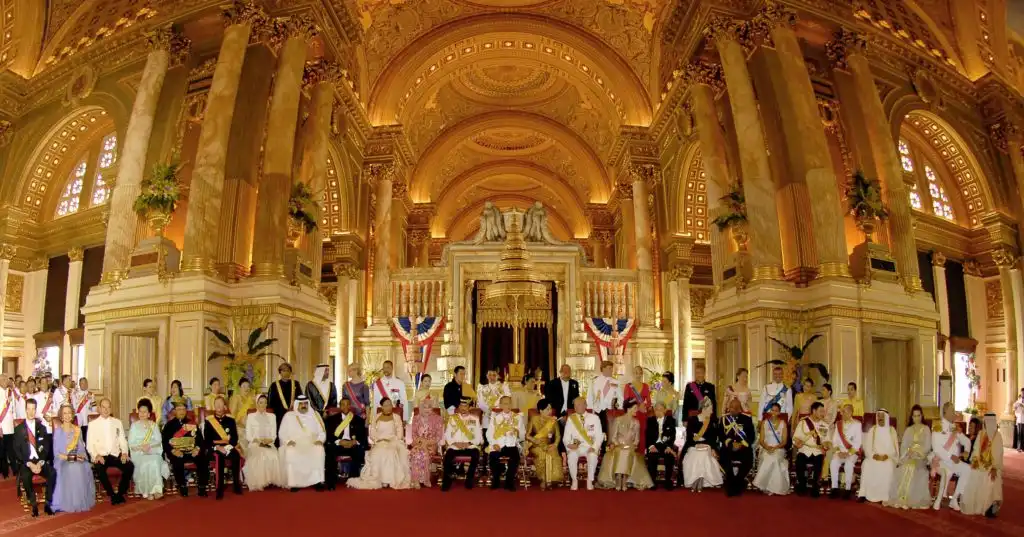
- State Ceremony is an annual ceremony set by the government. by His Majesty the King His Majesty proceeded to preside over or please let the royal family go instead His Highness, namely, the Chakri Day Memorial Ceremony, which falls on April 6 of every year, the Chakri Day Ceremony. The constitution is bestowed on December 10 of every year.
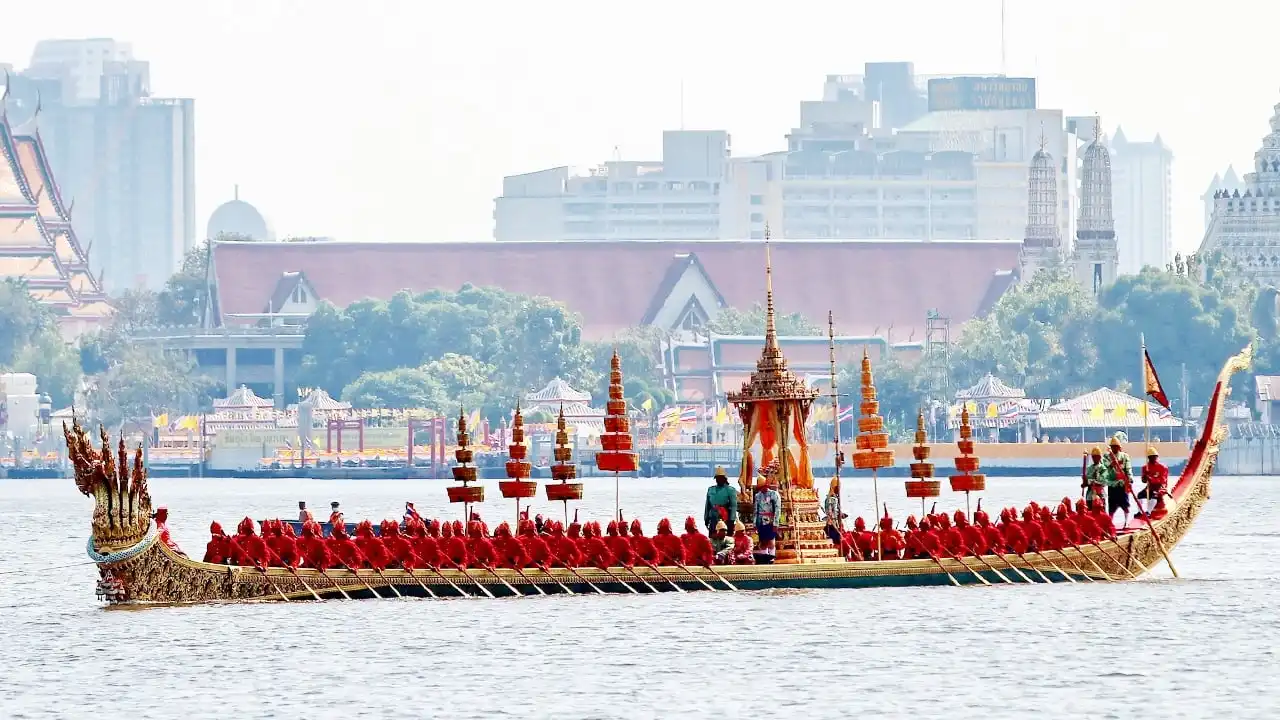
- Royal ceremonies means ceremonies that are held in connection with the King as royal ceremonies, including royal ceremony coronation ceremony Royal Plowing Ceremony Nangal Raek Nakwan Royal Jubilee.
Thai Traditions
Northern Traditions
Northern traditions and northern culture Original Lanna culture There is a center at Nopburi, Sri Nakhon Ping, Chiang Mai Province. According to the name of the kingdom that divides the city-state government which was established in the 18th century by Phaya Mengrai.
Most people call it Lanna. It is a land of many cultures and traditions that are charming to explore no less than other regions of Thailand because it is a city full of fascination. including tourist attractions, history, local language, costumes, folk games, local food, northern traditions and northern culture It is considered an activity that has been practiced continuously for a long time.
Northern Traditions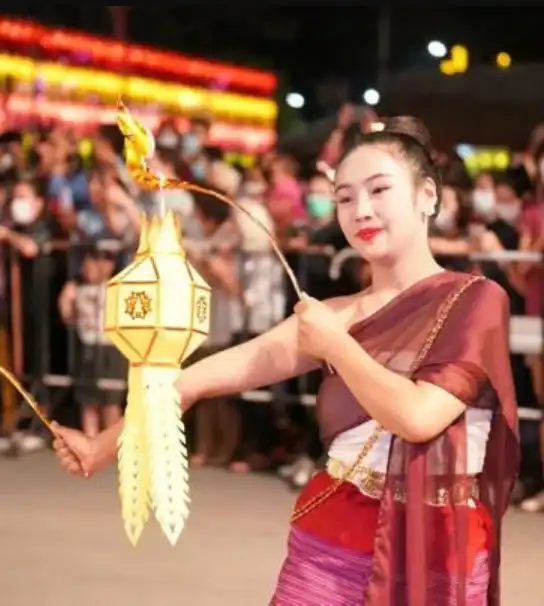
Traditions in the North
- Yi Peng Tradition
- Tradition of holding the Buddha image in the water
- Tradition of dancing grandparents' spirits
- Salak Phat Tradition
- Rice Tradition
- Poi Sang Long tradition
Tradition of the Twelve Months in the North
If referring to the Thai people living in the northern part of Thailand. Has origins in political and cultural history with Thailand. Laos and Thai people in the central region At present, the Thai people in the north, also known as "Thai Yuan" or "Khon Muang", have a long history of social integration, culture and tradition. They are characterized by their religious beliefs and their belief in traditions, including agriculture. As can be seen from each month, there will be different traditions, which in counting the days, months, and years of the Lanna Thai people.
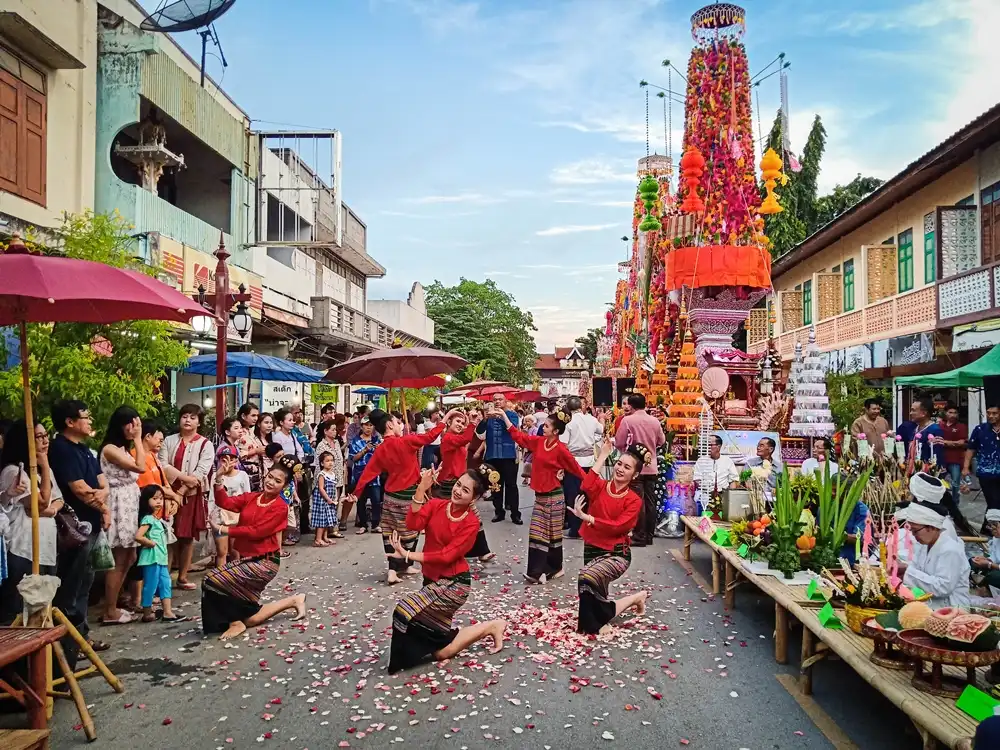
The first month of the Kian month (October) has a tradition of end of Buddhist Lent. It is a merit making for deceased relatives, and it is also an alms giving to the poor.
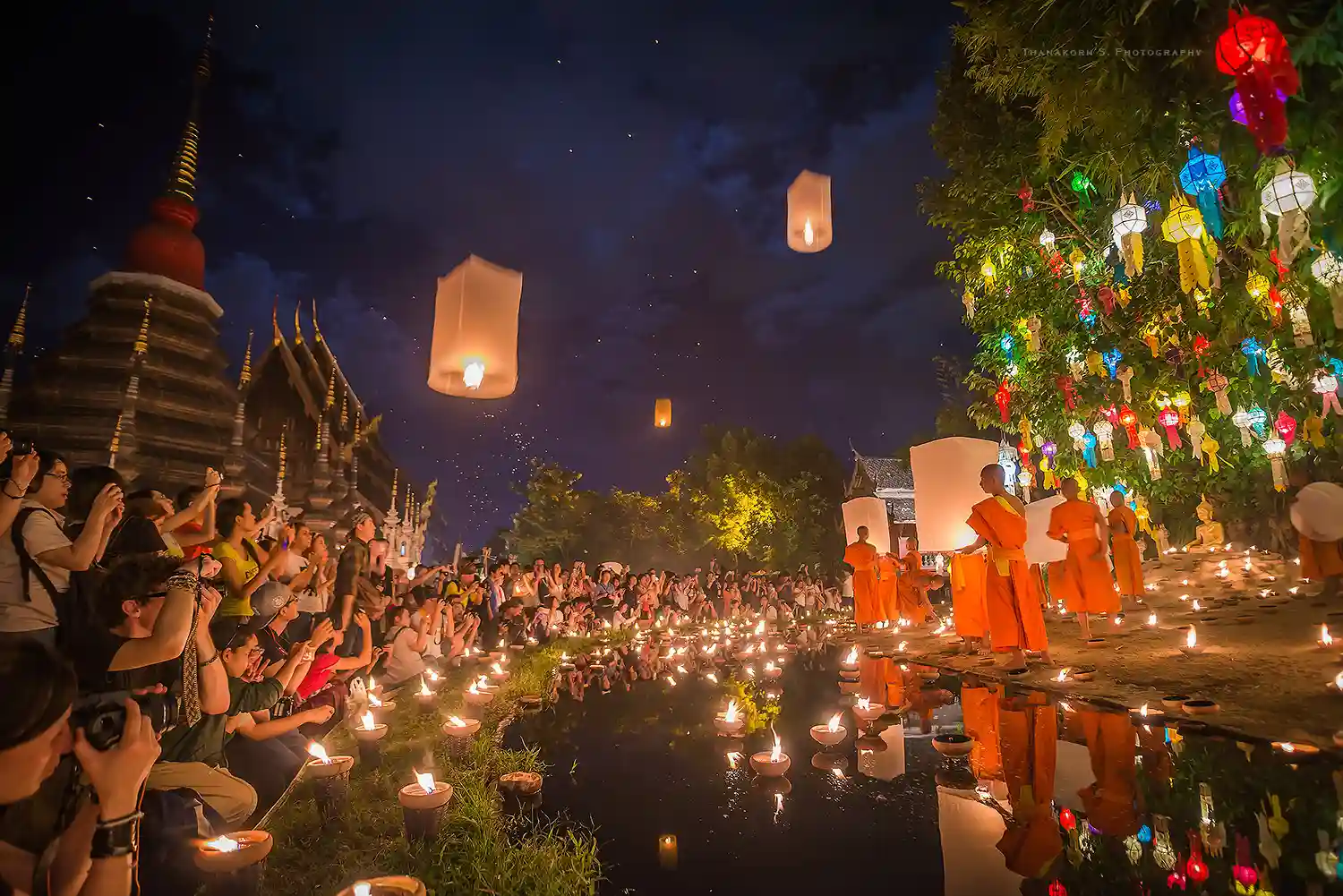
In the second month (November), there is a tradition of Loi Krathong (Yi Peng), throwing robes, setting up the Thamma Luang or the Great Chat Sermon. It is an old tradition dating back to the ancient Lanna Kingdom. Light a lantern at the festival to ward off bad luck. and bring good luck.
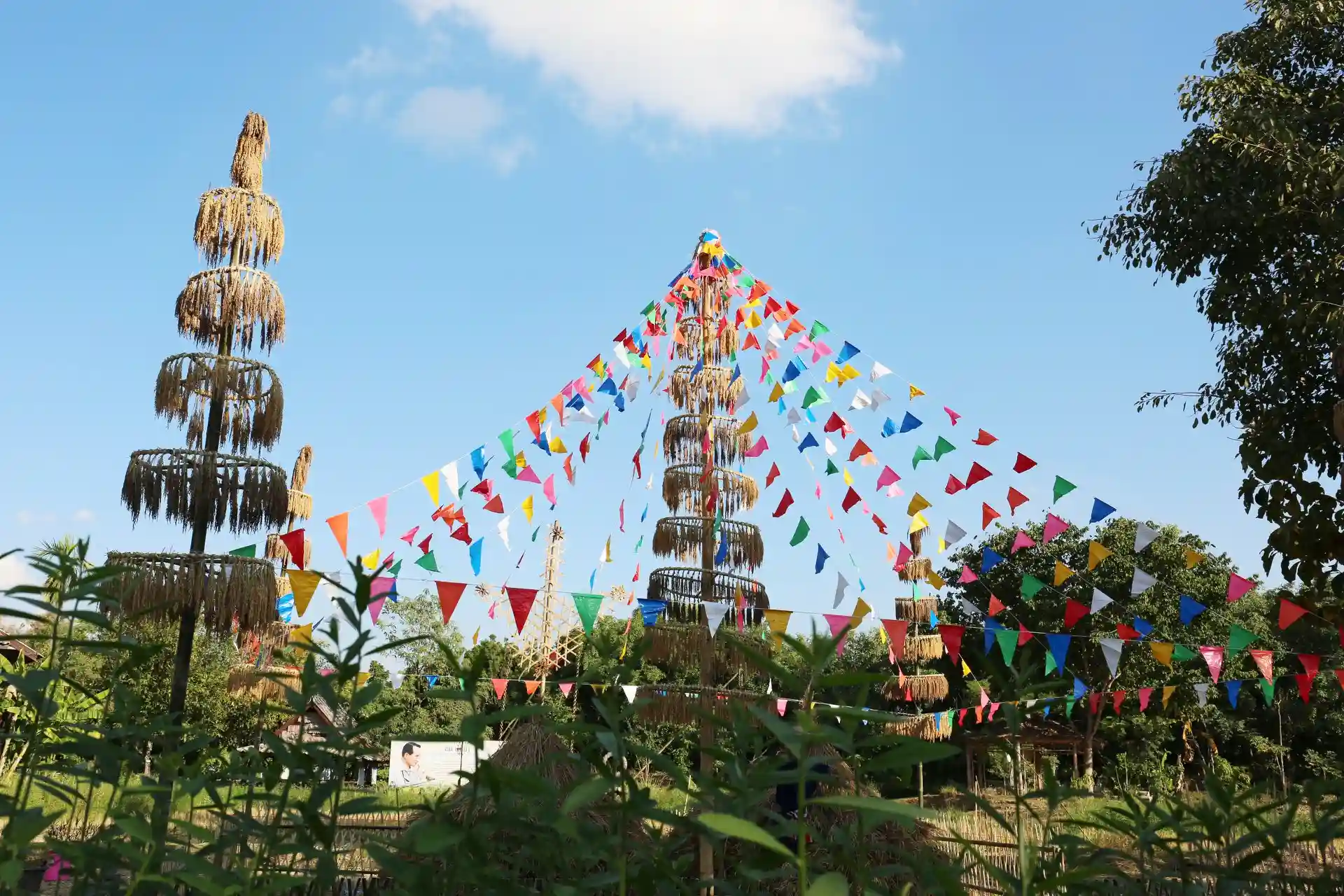
The 3rd month, Ai month (December) Hong Kwan Khao is a tradition of Northern Lanna people. As other regions call it "Bai Sri Su Kwan", it is a ritual that is made to raise the morale of the patient. Or incubate, recover from illness or on festivals and important days as a blessing to life Grandchildren have repaid their gratitude and join forces together in operations.
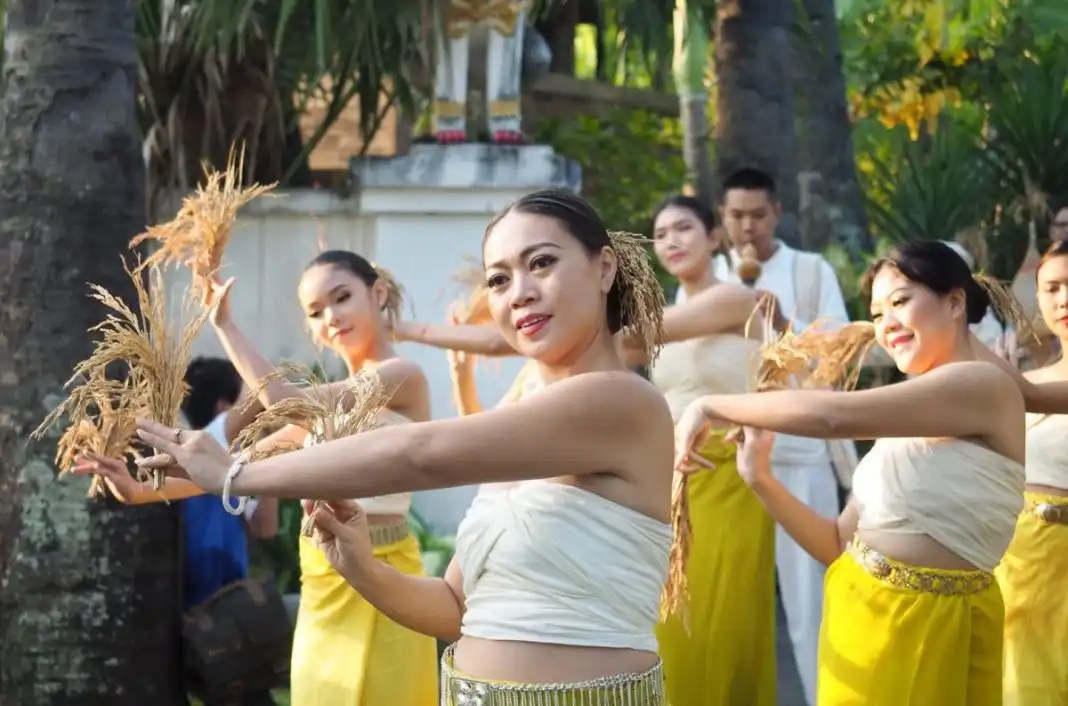
The 4th month, the fourth month (January), there is a tradition of having a new meal, building a new house, getting married, eating lua gods. It is a tradition that has been passed down for a long time. Villagers will bring the newly harvested rice and store it in the barn at home to be steamed until cooked for offering food to the monks, eating rice bowls, dedicating merit to deceased relatives and taking it as an apology to Phra Mae Phosop before eating.
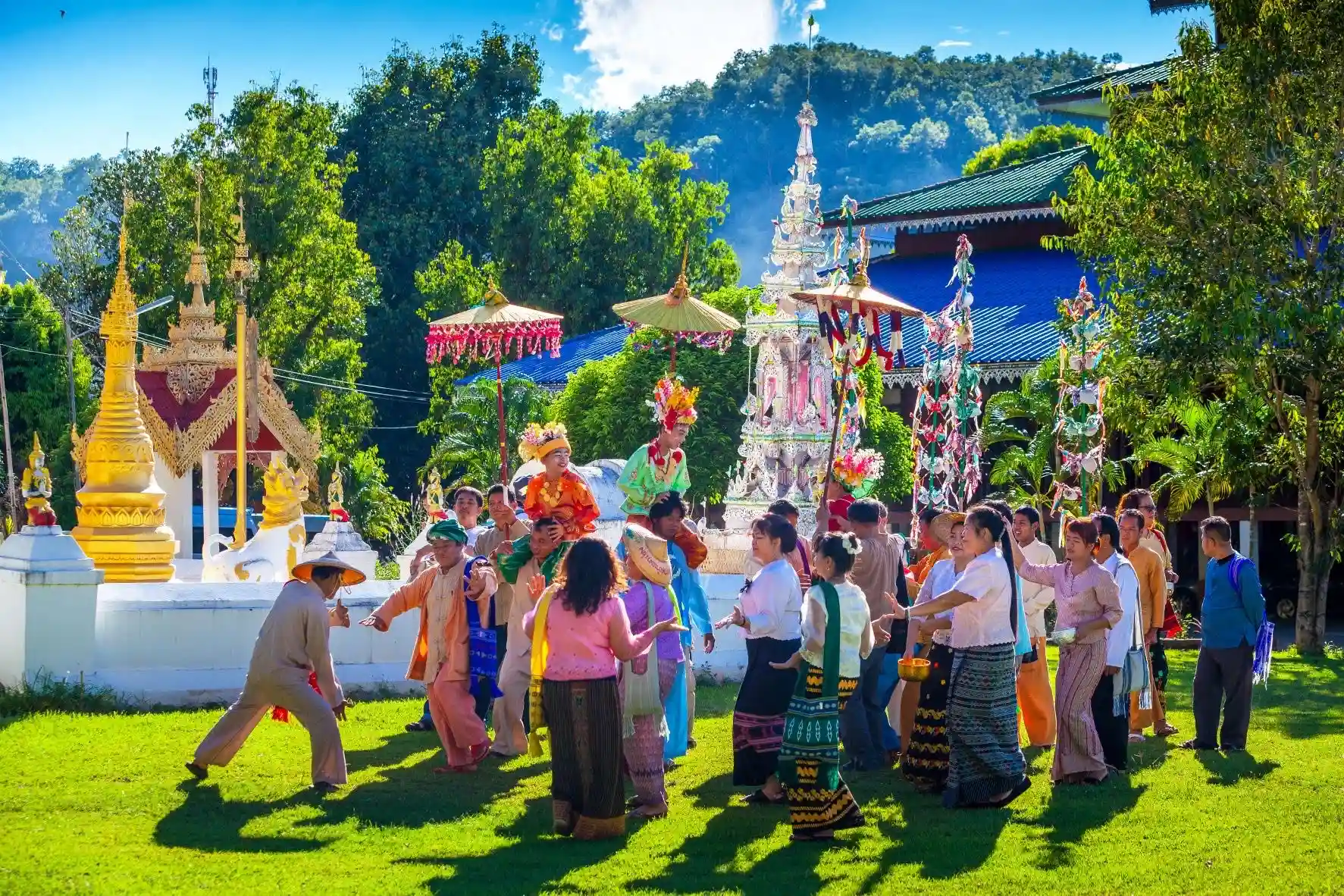
In the 5th month (February), there is a tradition of Poi Luang and Chan Luang. It is a congratulation that everyone in the village has jointly built a permanent object that is beneficial to the temple and the public. Including dedicating merit and charity to ancestors who have passed away It is a remembrance of their grace.
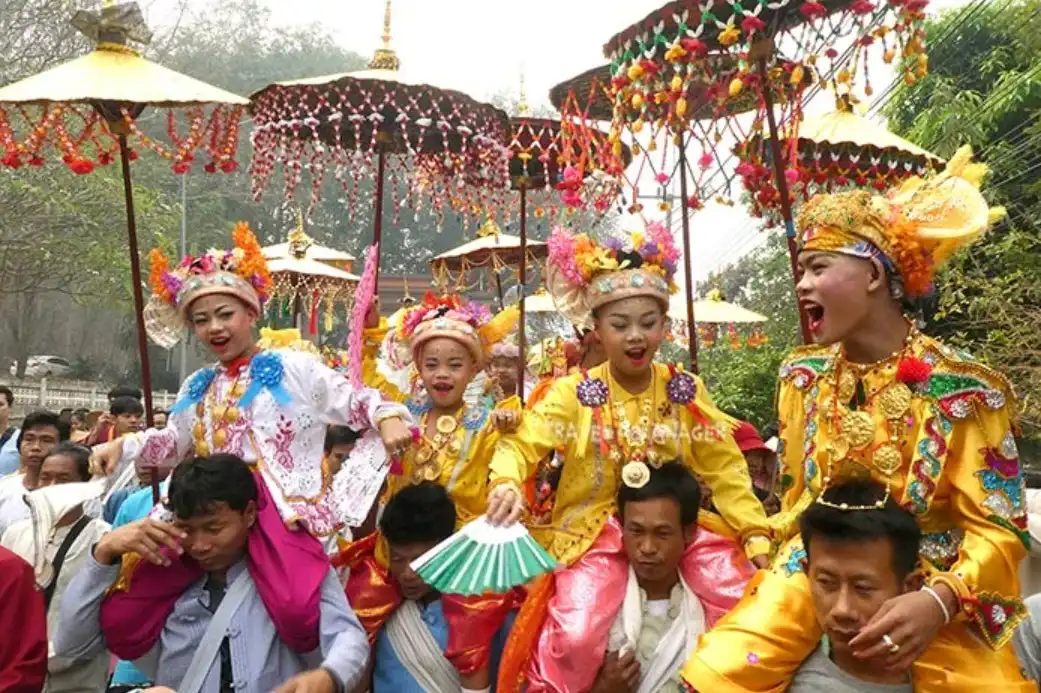
The 6th month, the sixth month (March) has a tradition. Men who are ordained must be from 7 years old up to 20 years old, called ordained monks because they are popularly called novices, monks, young novices called Phra Noi.
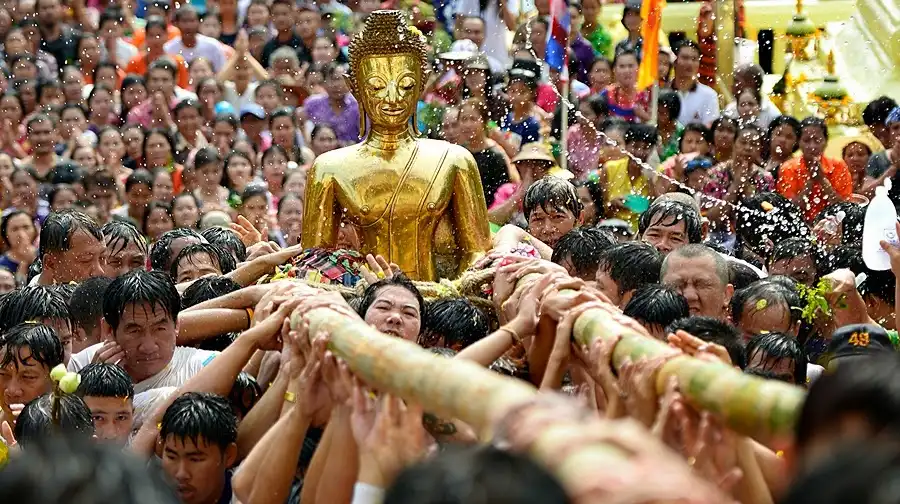
The 7th month (April) has a New Year's tradition in the city or Songkran.
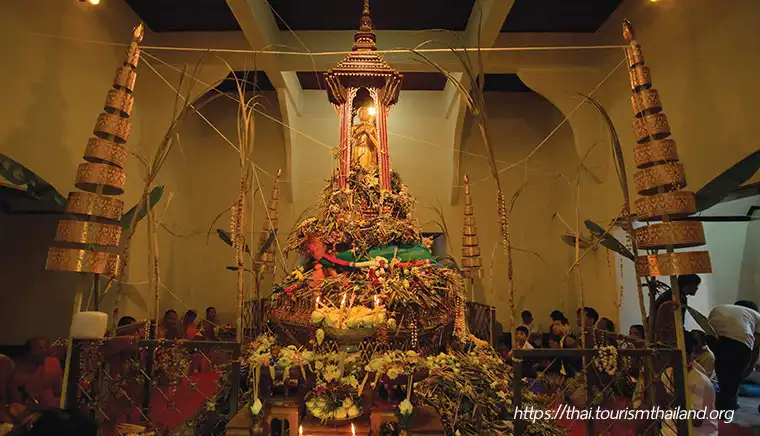
In the 8th month (May), there is a novice ordination ceremony, Visakha Bucha, paying homage to the relics, entering the Inthakhin, pillars or pillars in front of the city gate. or city pillar In the Chiang Mai legend book, it is called the city's navel or the Inthakhin pole.
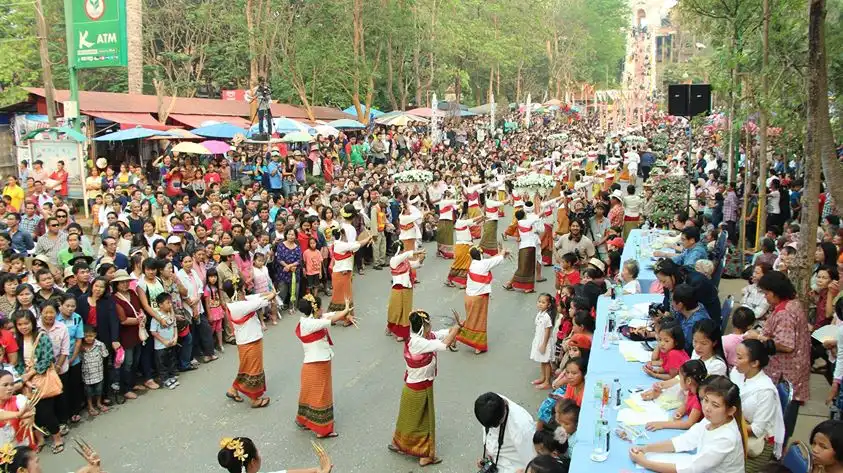
The 9th month (June) has a tradition of paying homage to the relics. It is a tradition that has been carried on for a long time by the Lanna people.
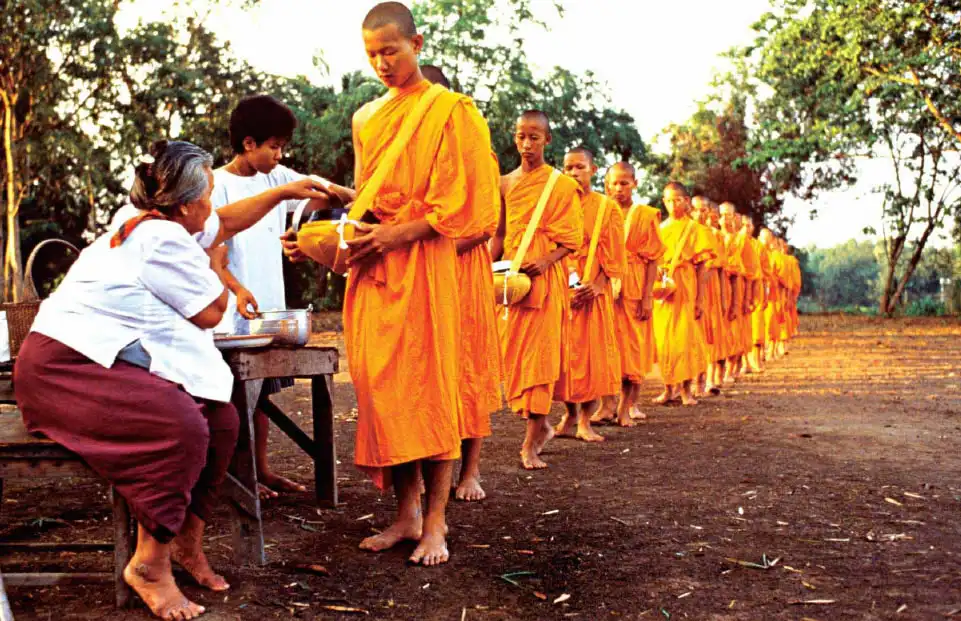
The 10th month (July) has a tradition of Buddhist Lent in the North. villagers made merit offering candles donate bath towel daily use to the Thera Achan that he respects.
In the 11th month (August), there is a tradition of eating rice. The old people hibernate. during the Lent season Elderly people who are exhausted from household chores going to sleep at the temple in order to observe the precepts throughout the day and that night until dawn to leave the chapel the next morning People of good standing prefer to make merit, provide meals and give alms to newcomers who have come out of the fasting period, believing that they will gain great merit. The rituals of the event are divided into main rituals and minor rituals. The main ritual focuses on giving alms to the elders. Secondary ceremonies It is an activity attached to it, for example, offering robes, making merit, listening to sermons, making merit, offering food to monks or making merit at home, etc., which have been practiced for a long time. It is a warm and satisfying alms giving for both the giver and the receiver.
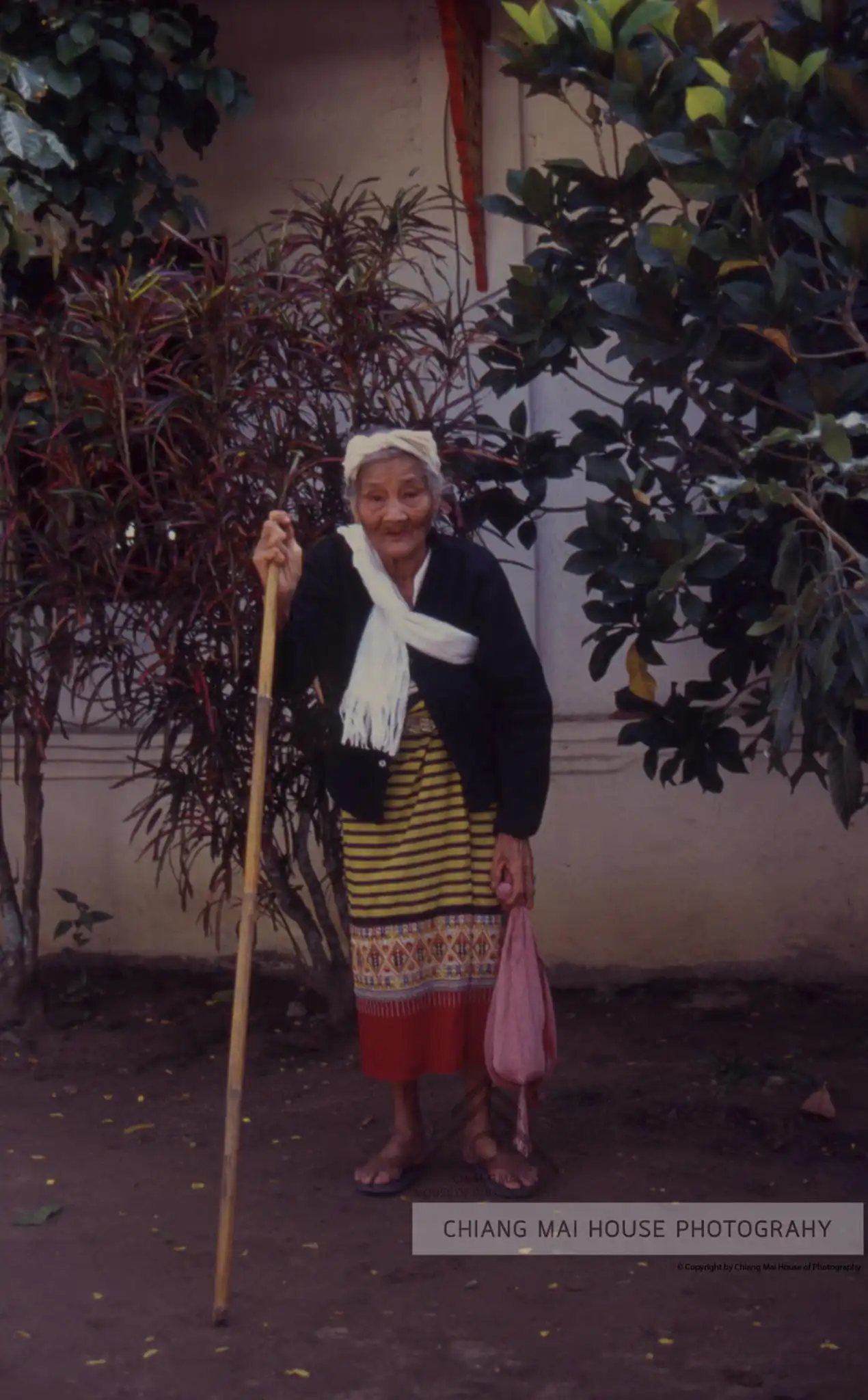
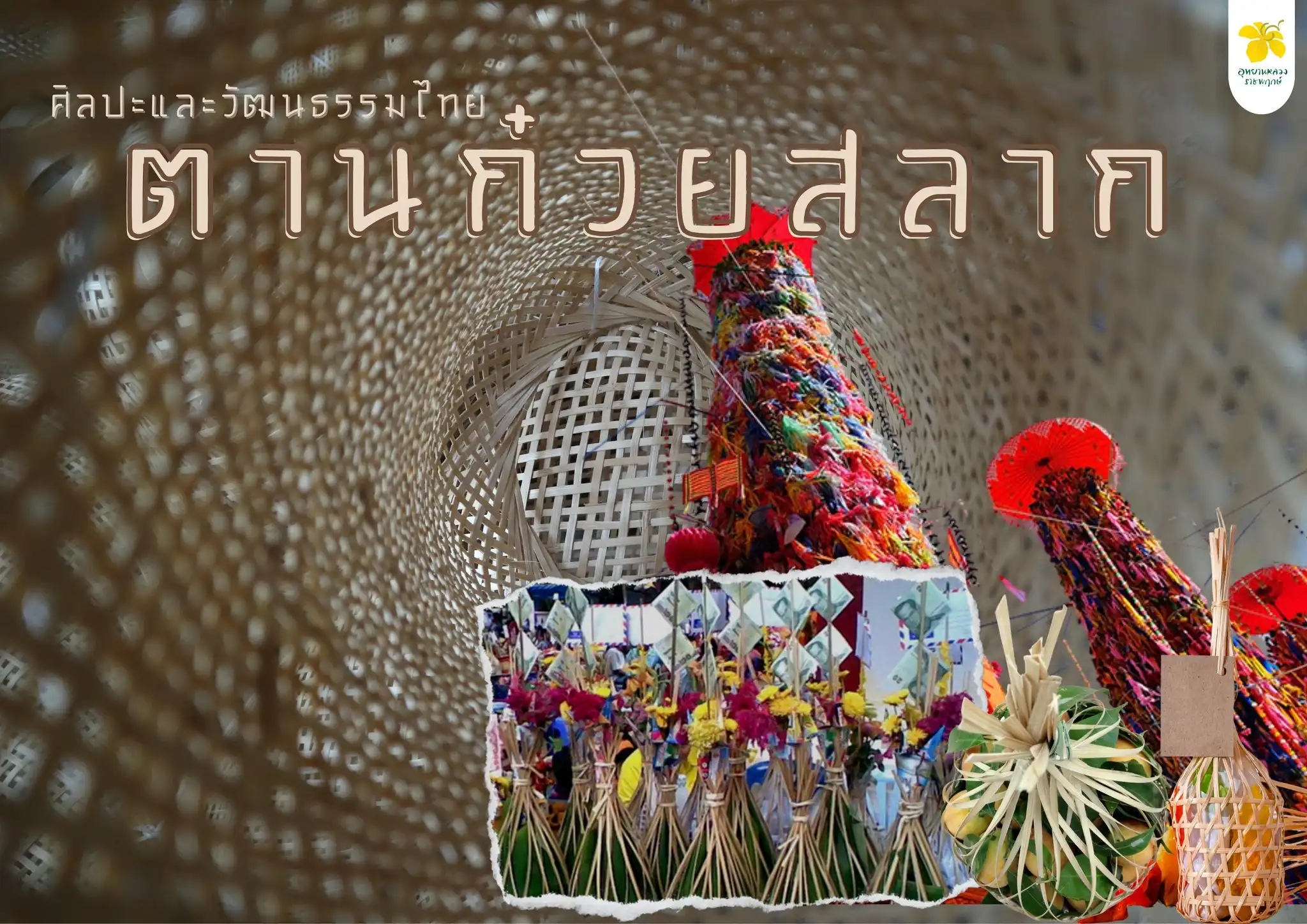
The 12th month (September) is a tradition that Lanna people commemorate their ancestors and relatives who have passed away. By making merit and dedicating merit through what is known as "Kay Salak", noodles are weaved from bamboo, inside which is wrapped with turmeric and banana leaves. in Buddhism that helps build a good relationship between the temple and the community and also create unity among relatives and friends as well.
Central Tradition
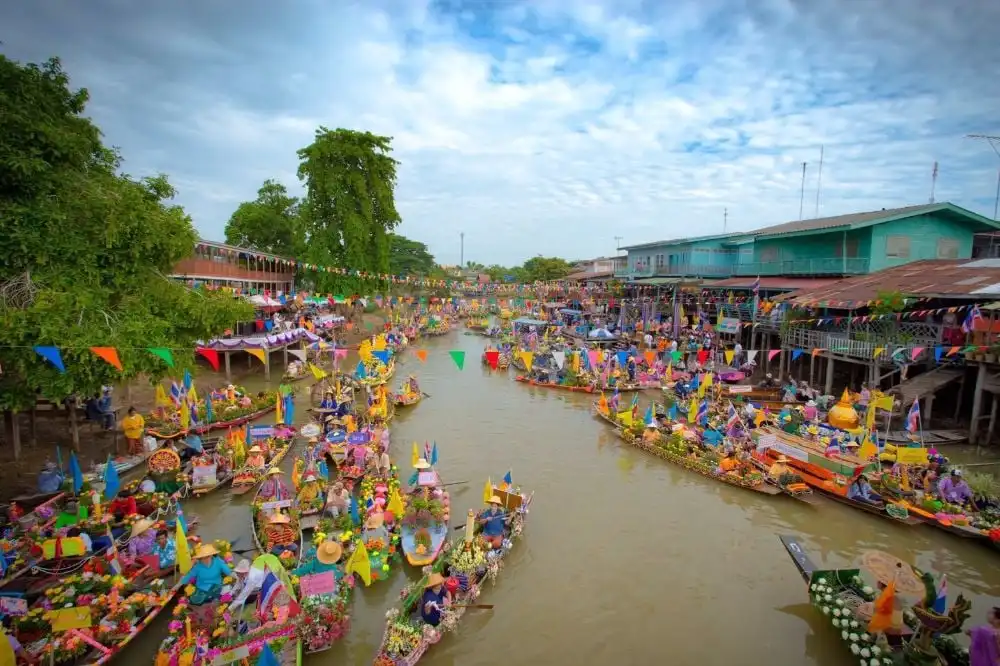
Central tradition Is outstanding, not losing other important traditions of the people in the central region It is still full of beliefs, stories and beliefs of people from the past to royal traditions and people's traditions. All have imitated and borrowed each other's cultures, with the royal traditions taking the examples of the Rat traditions and merging with foreign cultures until becoming a complete royal tradition. After that, the influence returned to the people's traditions again. Thus causing the people's traditions to gradually change according to the current royal traditions.
Various traditions in the central region such as the alms-bowl tradition, the Khwan Khao Tradition, the Kam Fah Tradition, the Yon Bua Tradition, the Kuan Khao Thip Tradition, the Tak Bat Devo Tradition and the tradition of burning candles and playing with fire.
10 Central traditions that have been passed down for a long time.
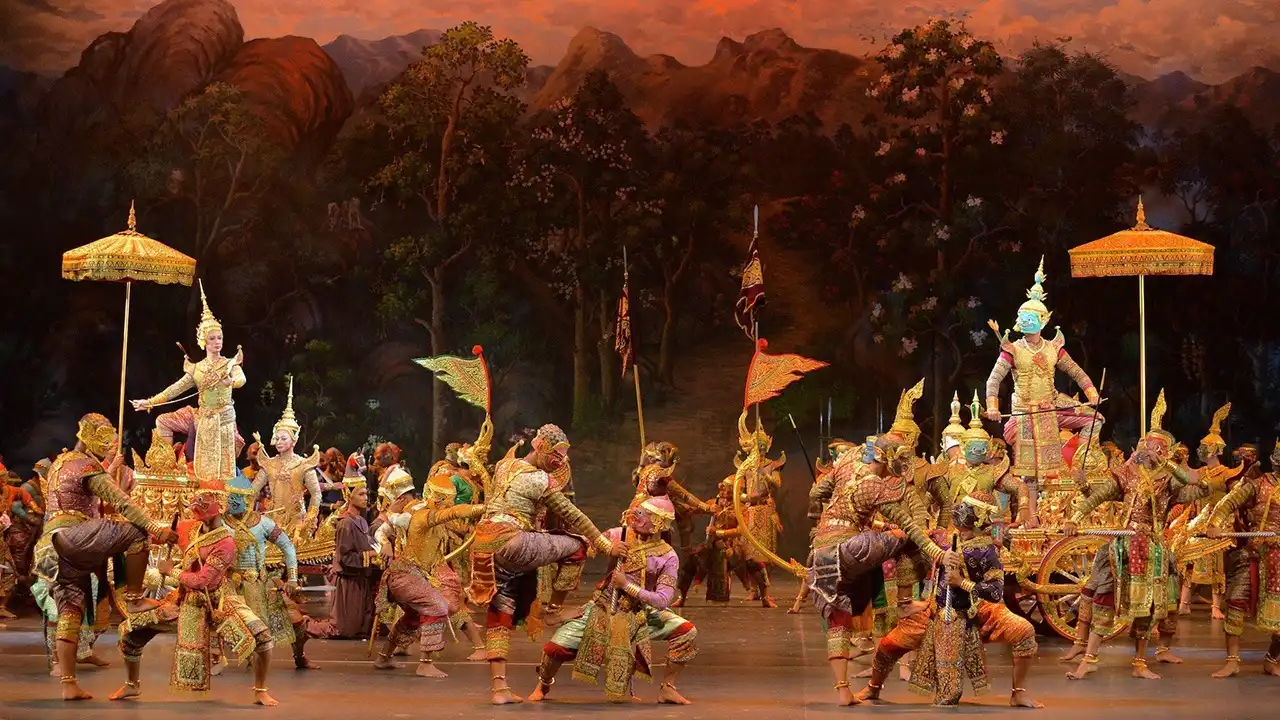
1. Khon Performance Tradition It is an ancient Thai performing arts that has been recognized around the world. originated from the Ayutthaya period It is a combination of many fields of art, namely Khon, the way of playing and how to dress. acrobatic fighting stance The dance moves are taken from Krabi Krabong. and pantomime brought the art of narration Music page.
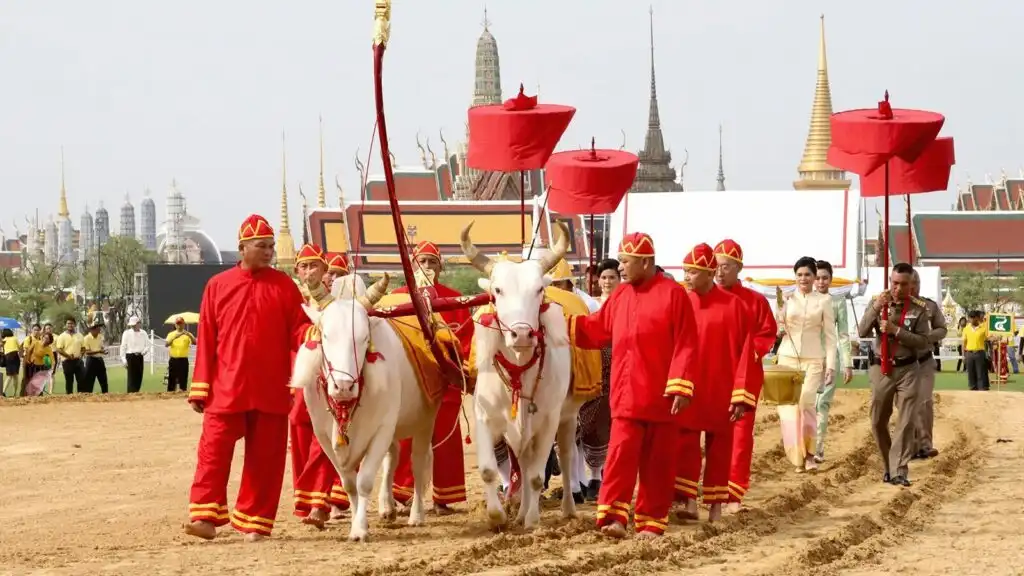
2. Rae Nakhwan Tradition In ancient times, it was probably a ceremony intended to raise morale and remind farmers to grow crops, especially farming. Because rice is the most important cereal in life. The king or the head of the country took the lead and started plowing and sowing crops as an example. to remind the people that it's time to cultivate.
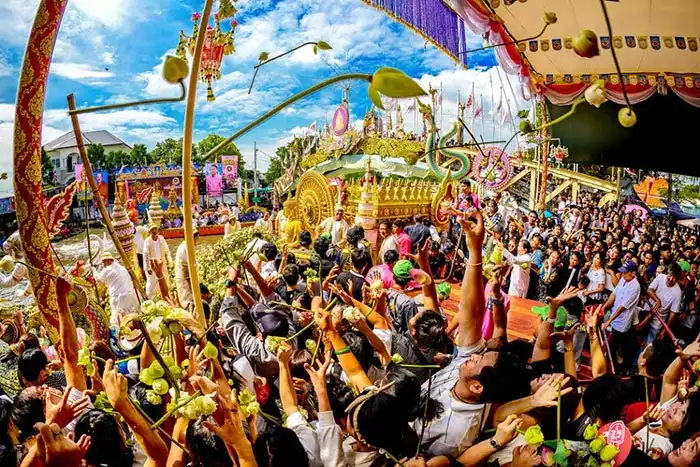
3. Lotus Receiving Tradition It is a local tradition of people in Bang Phli District, Samut Prakan Province. It is an old tradition that has been passed down since ancient times. It is a tradition that shows kindness. Generosity towards foreigners who immigrated to live in Bang Phli District and shows the way of life The relationship with the river of the people of Bang Phli District that existed from the past to the present.
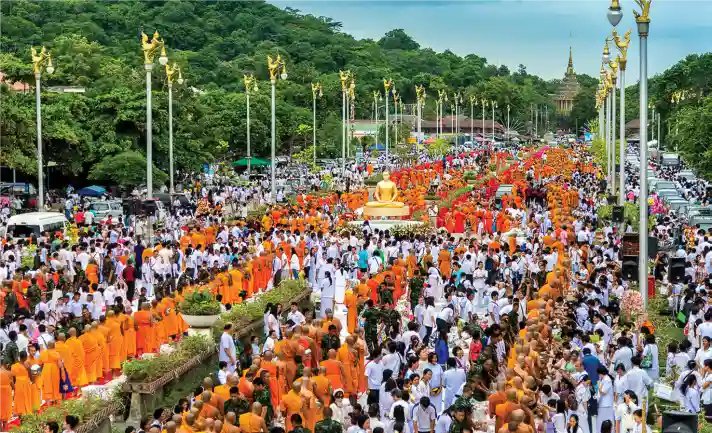
4. Dok Mai Tradition It is a Buddhist tradition with the belief in making merit. It is an annual tradition of Saraburi Province.
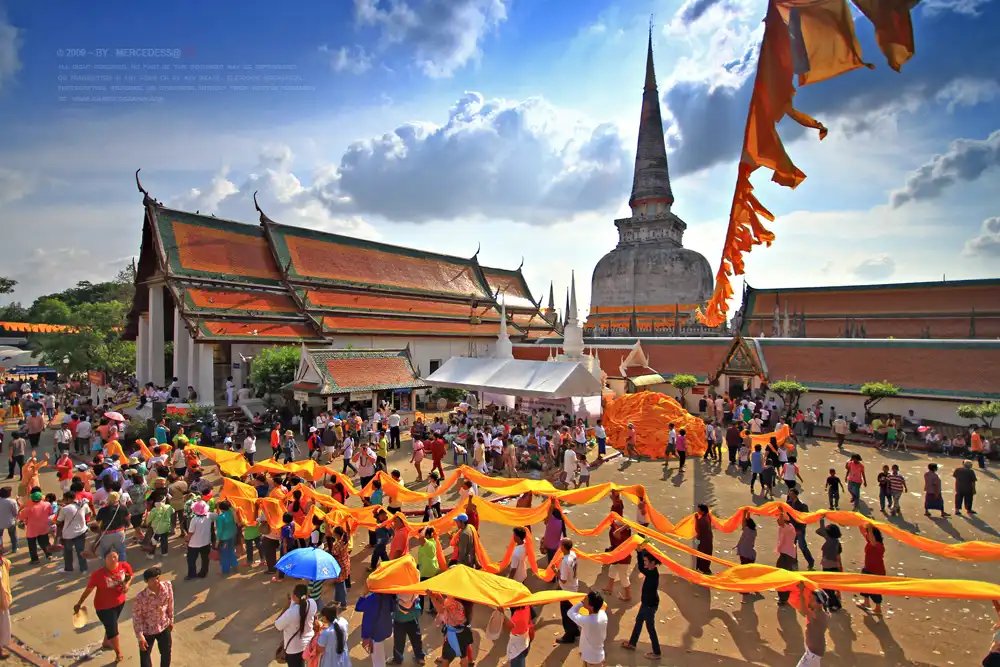
5. Phra Pathom Chedi Blanket Procession Tradition A ceremony that has been practiced continuously for hundreds of years of the people of Nakhon Pathom. Reflecting faith and unity, continuing traditions, preserving Buddhism, elders, young people and descendants, passing on the ceremonies from generation to generation to continue with the way of life.
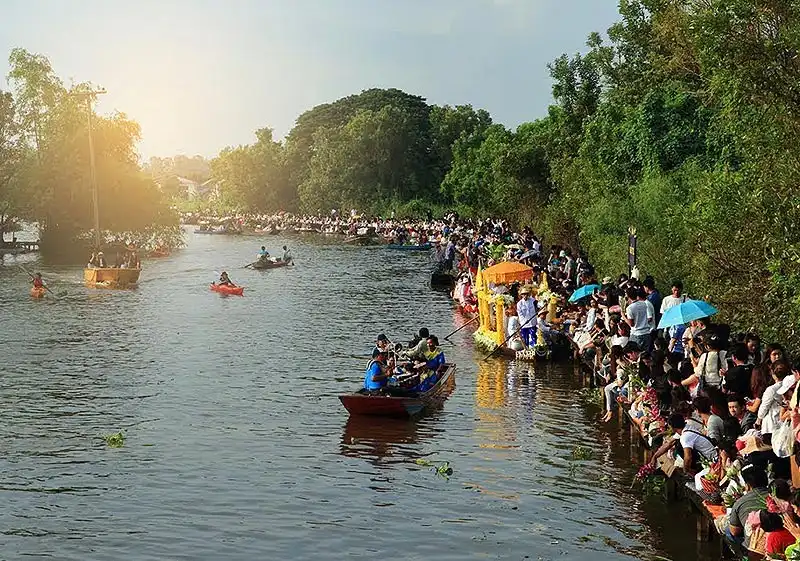
6. Tradition of Alms Giving to Monks It is a tradition to offer food to monks on the water during the end of the Buddhist Lent. at Pathum Thani people especially Thai people of Mon descent practiced for hundreds of years It is a tradition that reflects the way of life. and the cultural identity of Thai people who have faith in Buddhism by making merit and giving food to the monks since the past and present.
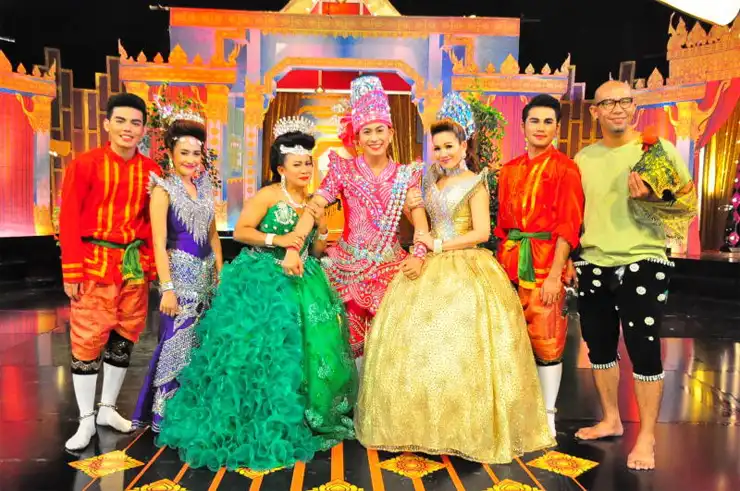
7. Likay Thai tradition Occurs in the Ayutthaya period or early Rattanakosin It is a traveling drama that the host hires to perform at the temple or at home at the annual ceremony, ordination ceremony and funeral or builds a fenced-in building to collect admission fees. The Likay factory is a slightly raised stage. There is a stool or wooden bed placed in the middle as a seat for the show. Behind the raised platform is the location of the Pi Phaat band, behind which there is a cloth scene depicting a scenery blocking the audience from seeing behind the theater where dressing is possible.
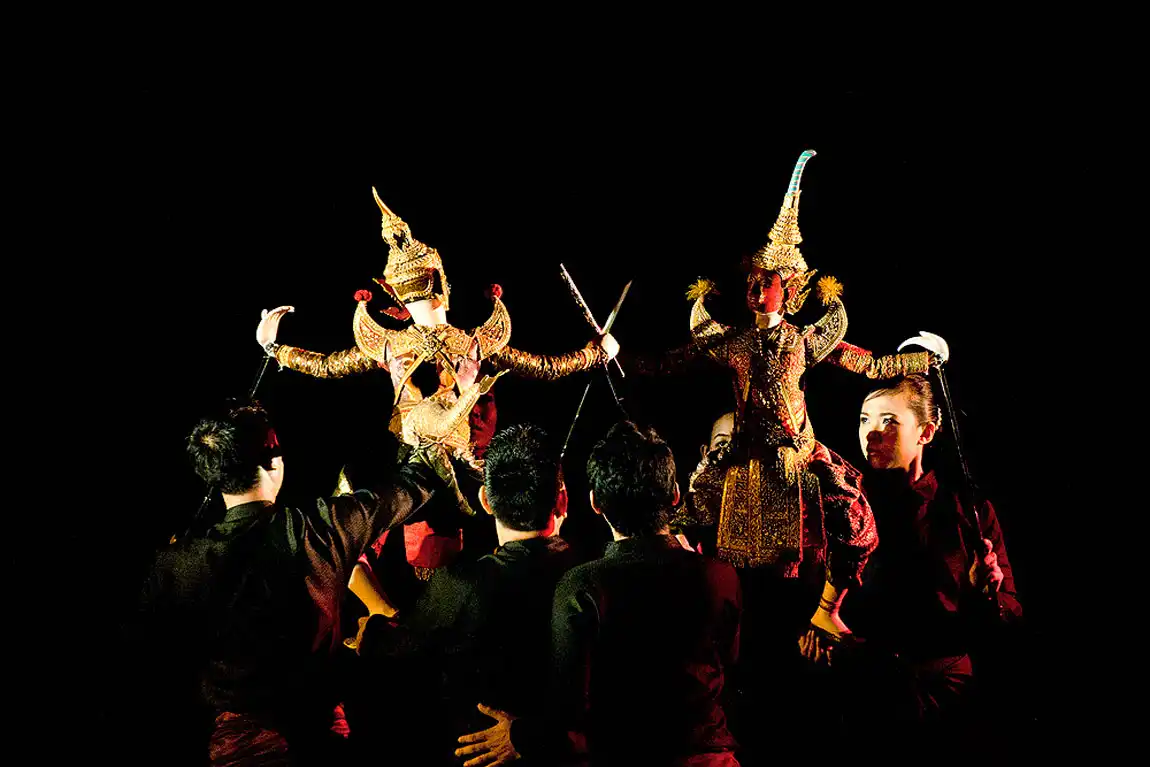
8. Puppet Show Tradition Thai puppetry originated in the reign of King Chulalongkorn. History of puppet show to be a musical instrument Thai puppet show in the past dedicated to the royal family.
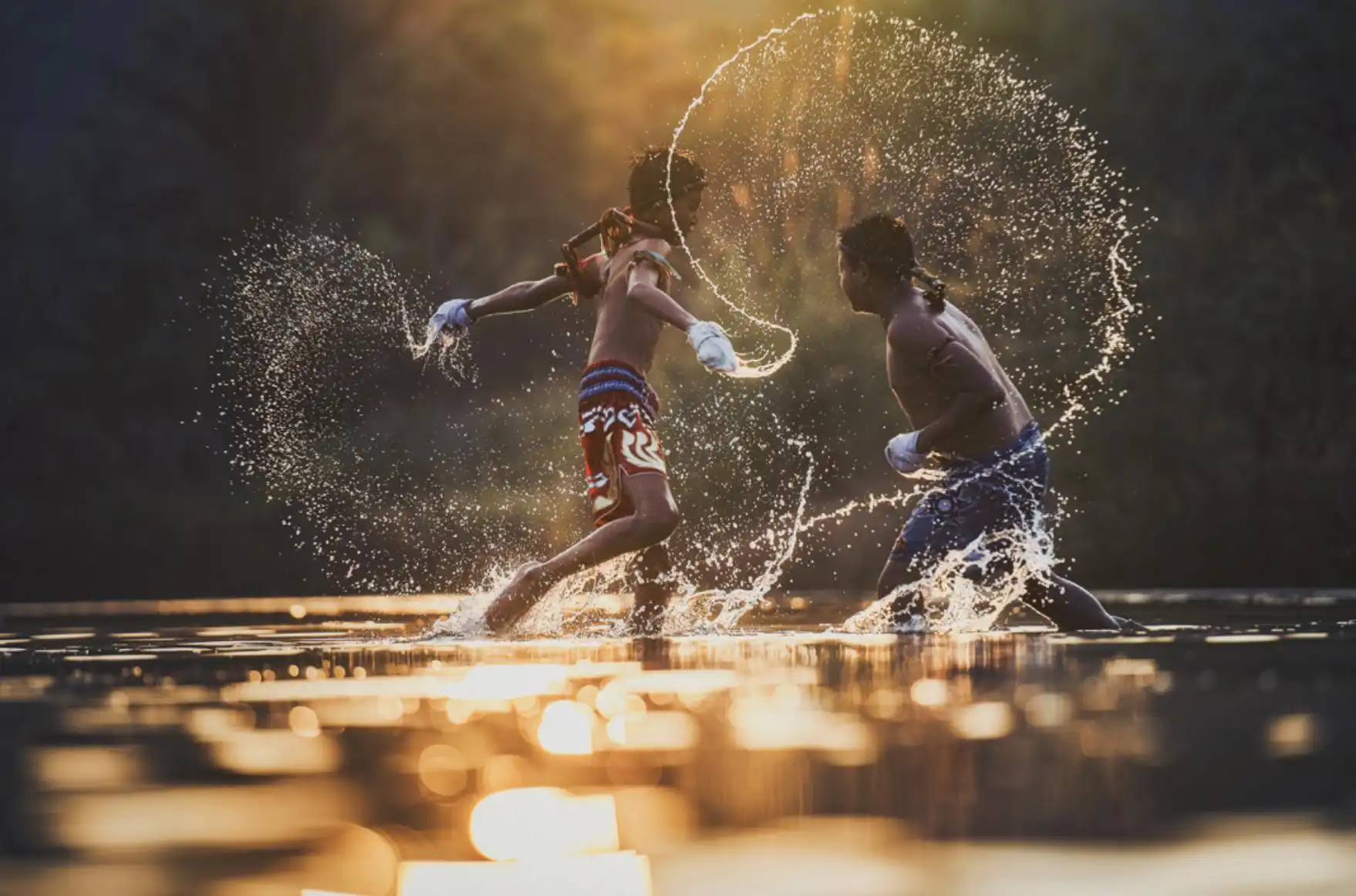
9. Muay Thai Tradition Muay Thai is a cultural heritage of the Thai people that has been passed down for a long time. It is both a defensive fight and a sport. and nowadays Thai teenagers Or even foreigners have turned their attention to the art of Muay Thai a lot more.
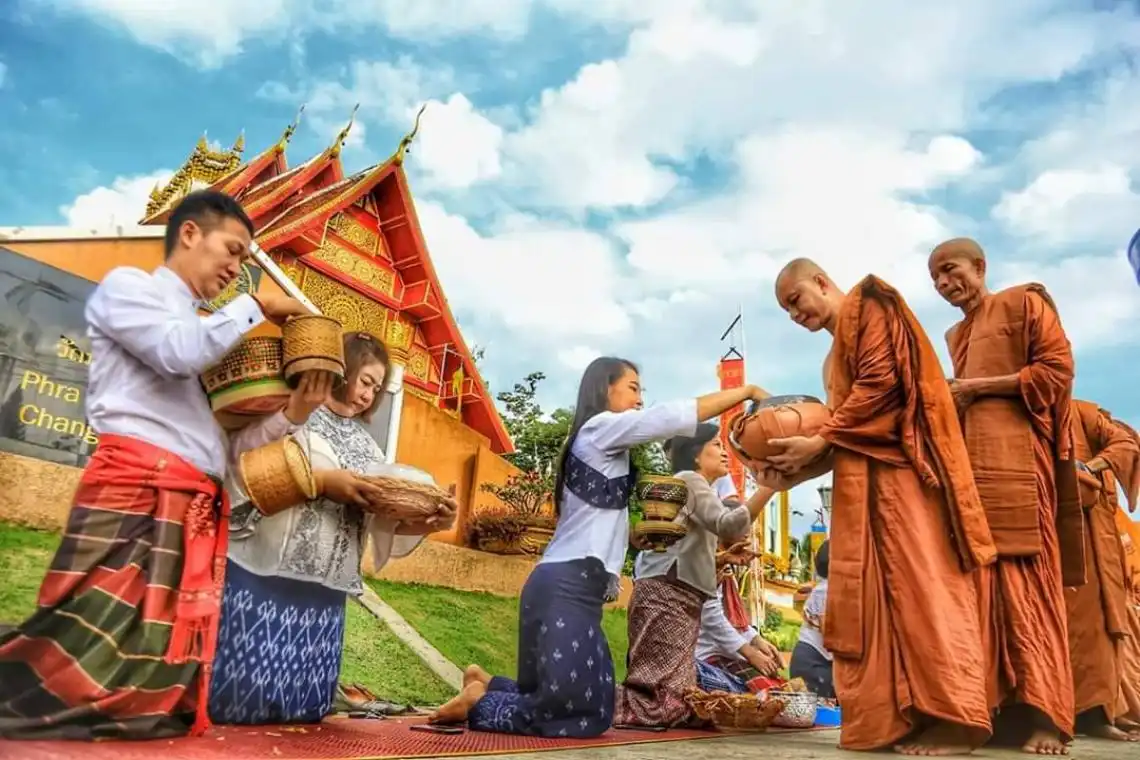
10. Tak Bat Devo Tradition It is the time when the monks perform religious activities on the end of the Buddhist Lent day in the early morning. People who believe in Buddhism make merit during this time. It is a tradition that continues to the present day.
Northeastern Traditions
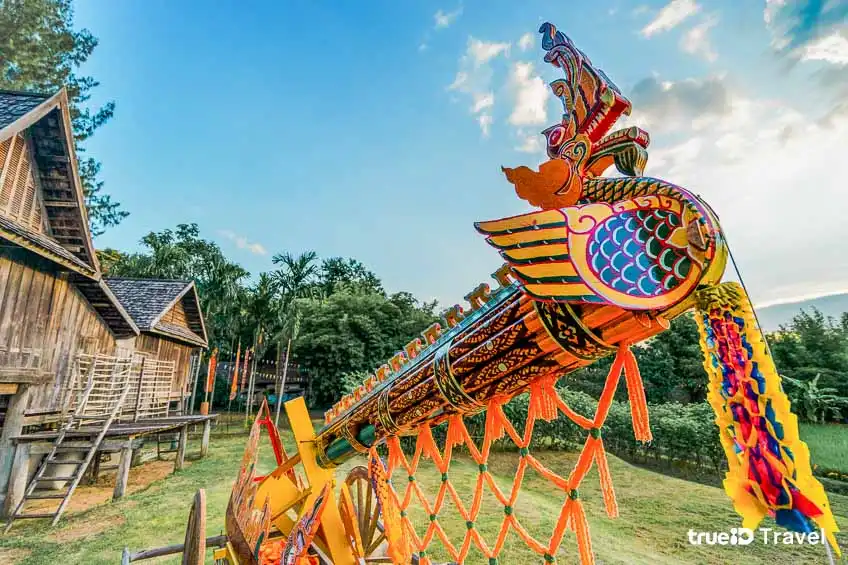
Isaan is limited in natural resources. from dry weather in the dry season The water will flood both sides of the river. Most of the population live on the hills not far from the river, reflecting the wisdom of the settlement. and adaptation to the environment The area in the Northeast used to be in the area influenced by Khmer civilization. And is the habitat of the Tai-Lao people, which make various groups. Mixing various cultures together and continually inherited from one another to become an Isan culture with characteristics Unique and interesting Isaan traditions and traditional rituals of Isan people It has to do with belief in supernatural powers. and Theravada Buddhism There are both traditional rituals that are practical. and traditions that have been passed down from generation to generation.

Tradition of the Twelve Months in the Northeast
The 12-month tradition called Heet Sib Song is regarded as a cultural heritage that has been handed down to the present. Beliefs in the way of life that are related to agriculture to build morale and encouragement for living. Isaan people therefore have so many local merit making events that it is known as the region with the most folk traditions in the country. The twelve-month heat or the twelve-month tradition Isan people join together to perform the ceremony since the beginning of the year, namely.
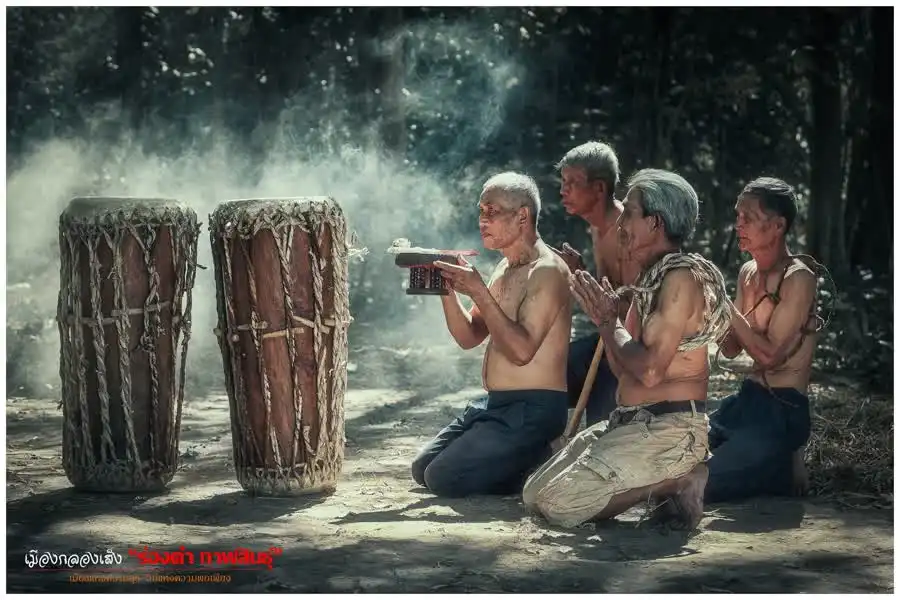
Seng Klong Festival making pla daek (making fermented fish for food), harvesting rice in the field, playing kites, blowing kites, inviting monks to enter the temple According to tradition, religious merits are made. for the monks to pay tribute to the ancestors The villagers raise Phi Tan, the ancestor's ghost, and prepare to collect rice and food to eat in times of drought.
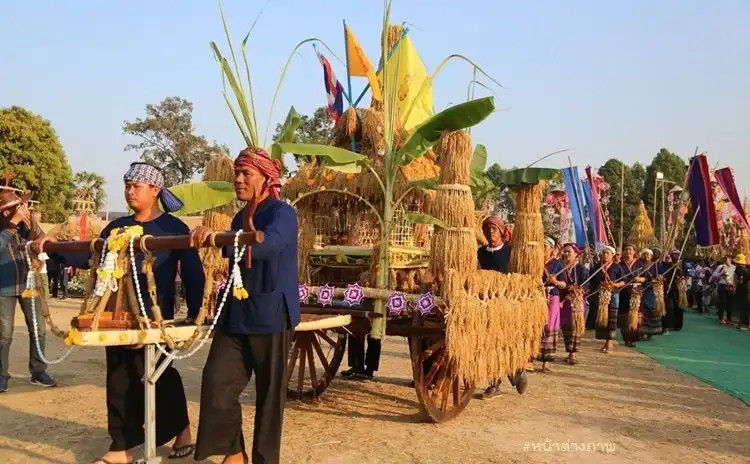
In the second month, the merit making ceremony at the temple, the monks gave a sermon about Mae Phosop. perform a ceremony to plant rice in the lom and thrash the rice in the courtyard Carrying leftover rice into the coop (barn) is believed to enhance morale and prosperity in agriculture. There are both making merit at the temple and sometimes making merit at the threshing floor. When carrying rice into the barn, they often make merit at the temple.
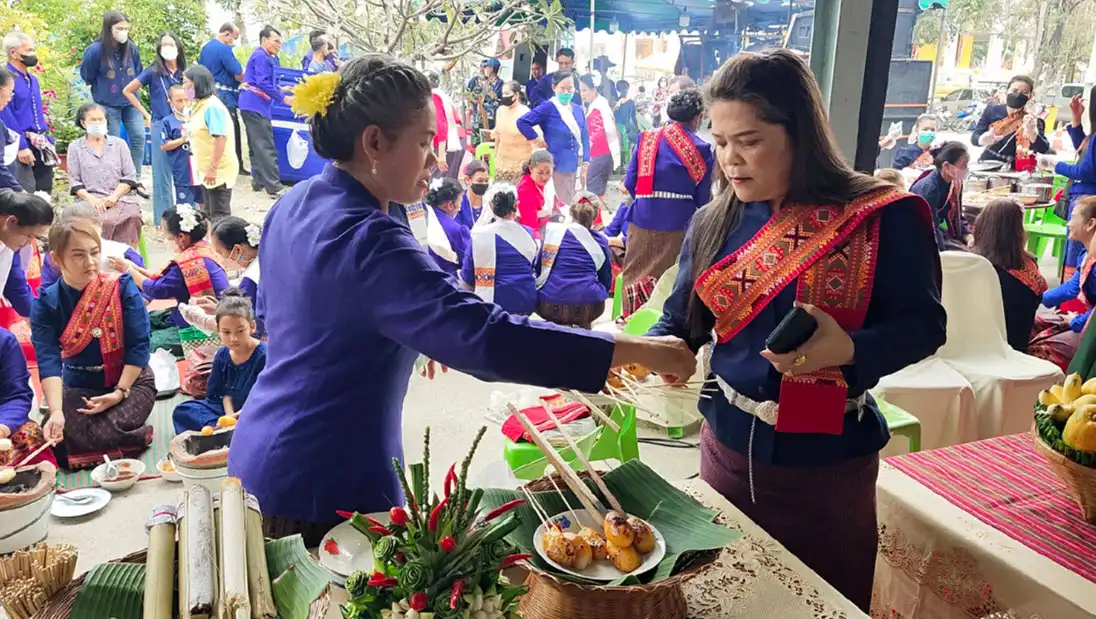
In the third month, Boon Khao Jee, there is a ceremony to feast on La Ta Hak (Phra Phumna) because the rice has already been loaded into the barn. Er Kwan Khao Festival or Ku Kwan Khao Festival The full moon of the third lunar month makes merit in the evening, making Makha Bucha in the evening. Go down to push cotton to find Luo Firewood. (Da Luo bamboo trunk fuel wood dry twigs-firewood). According to tradition, after harvesting the rice into the granary There is a merit making offering to worship the landlord. Which Isan people call Ta Hak and make merit and spread the merit to the ghosts of grandparents which shows gratitude to ancestors by making khao jee (sticky rice molded into cubes stuffed with sugar or molasses and dipped in egg toast until yellow) to offer to monks along with other savory dishes.
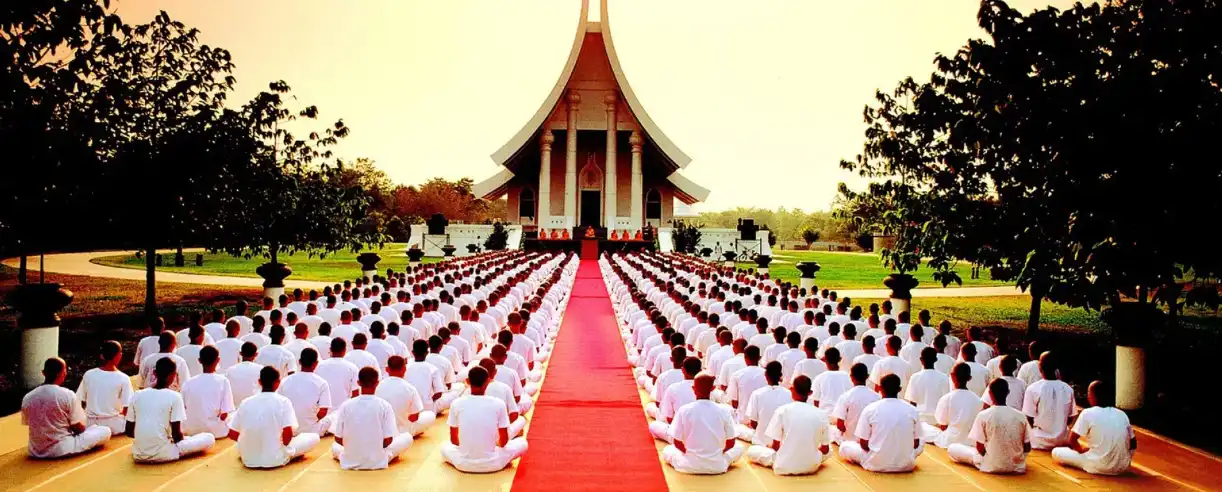
The fourth month, Boon Phra Wet (read Phra-Wet aloud), there is a Boon Phra Wet ceremony (Listen to the Mahachat sermon) parade Phra Upakhut to set up shrines Making merit, distributing rice to the deceased (Boonpet Phli), the Mahachat sermon tradition is the same as other traditions in other regions as well. Vessantara Allegory According to the temple tradition, it lasts 2-3 consecutive days, depending on the schedule. During the event, there is a parade of Phra Upakut to ask for rain to come.

The fifth month, Boonsong Nam, Boonsong Nam or Songkran Festival Isan people call it Sangkhan according to the Songkran festival tradition. Some of them are organized for 3 days, some for 7 days, depending on the schedule. or offer morning chan-pal throughout the festival In the afternoon there is a bathing Buddha image. pouring water on elders and building sand pagodas.
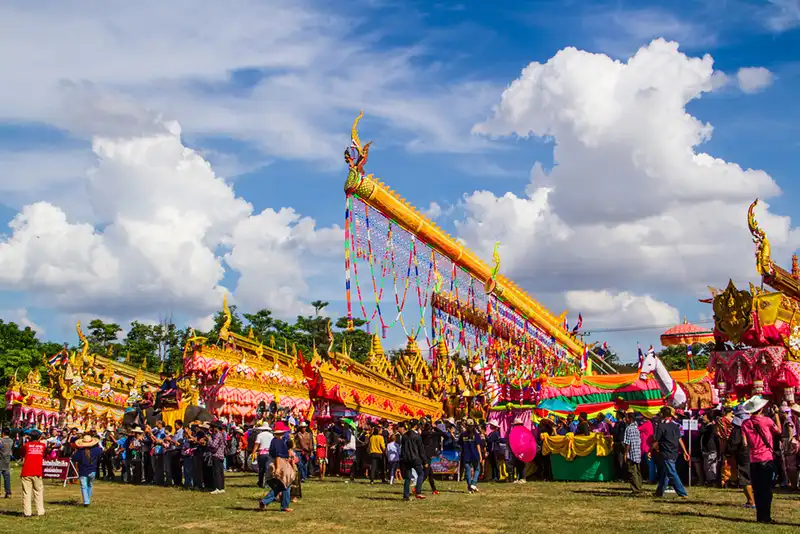
The sixth month, Bun Bang Fai, some people call it Bun Visakha Bucha, there is a Bun Bang Fai (Boon Khor Fon) festival, Bun Visakha Bucha, the full moon day of the sixth month. Almost throughout the sixth month Isaan people hold a Bun Bang Fai event Held on any day as determined by the village committee, it is considered to be an offering to the elves (gods) to ask for seasonal rain and abundance of food and food in the following year on the sixth full moon day. It is an important Buddhist tradition for the Vesak merit making ceremony. There is merit making, listening to sermons and walking around the candle for the benefit of the next life.

In the seventh month, Boonchamha has a ceremony to raise grandfathers, grandfathers, city pillars, Boon Berk Ban Berk Mueang ceremony. Naga entrance ceremony for Naga ordination. Beliefs after sowing seedlings There was a ceremony to make offerings to the landlord. For the prosperity of the rice seedlings in her germination The house where Kulputra has an ordination ceremony to replace the merit of parents and to prepare for the karma in the Buddhist Lent.
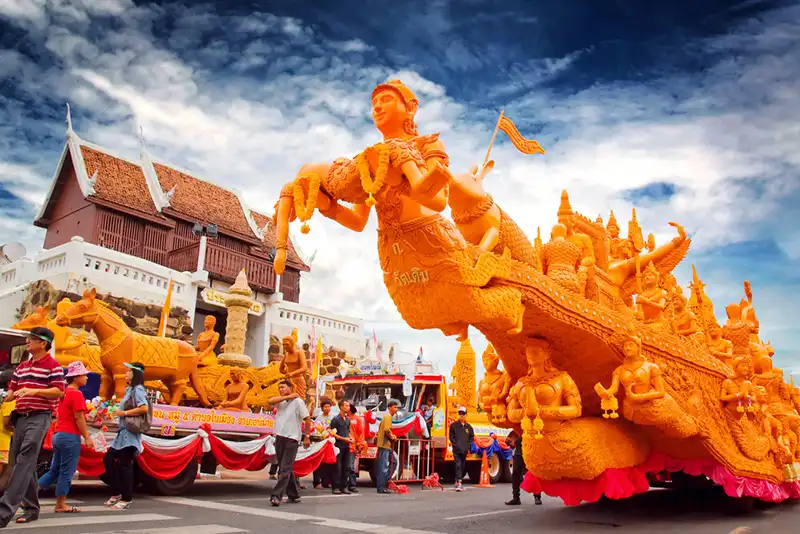
The eighth month, Buddhist Lent ceremony There is a candle casting ceremony for the Buddhist Lent festival. Each village helps cast candles. beautify Organize a parade of friends to offer as an offering to the Buddha Making merit by offering food to monks Thai food and rain cloth for monks to use throughout the Buddhist Lent festival.
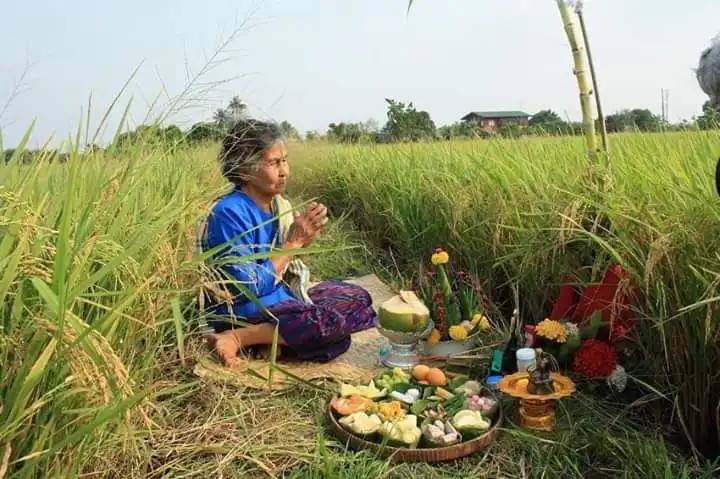
Boon Khao Pradab Din The ninth month, Boon Khao Pradap Din, organizes the event on the 14th day of the waning moon of the ninth month since dawn. The villagers arrange sweet and savory food. betel nuts, cigarettes, put in small krathongs placed in the courtyard of the house, under the tree, next to the ubosot In order to give alms to the jinn or spirits who are in trouble in the late morning, there is a merit making at the temple. Listening to sermons is a virtue.
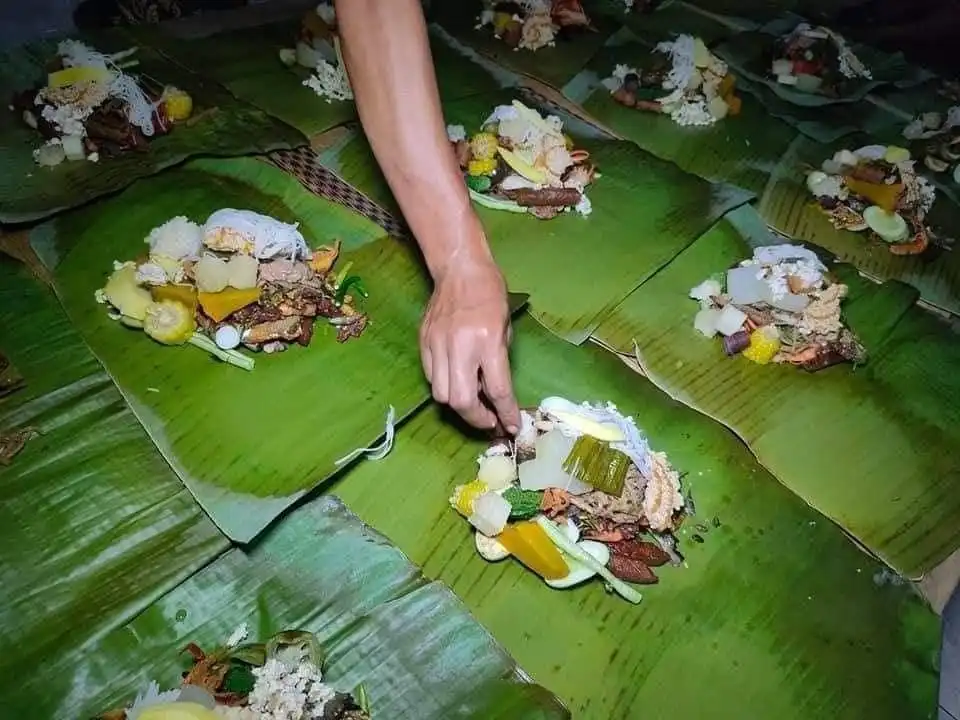
The tenth month, Boon Khao Sak Khao Sak means stirring Krayasart. similar to the merit-making festival in the central region Held a full moon event in the 10th lunar month, bringing sweet and savory dishes along with unsalted rice (Krayasart) to make merit at the temple, offering rain clothes and Thai alms. But before making offerings, they will make lotteries. Any monk who wins any lottery will accept it from the owner of that set. Listening to sermons in the afternoon is a virtue.
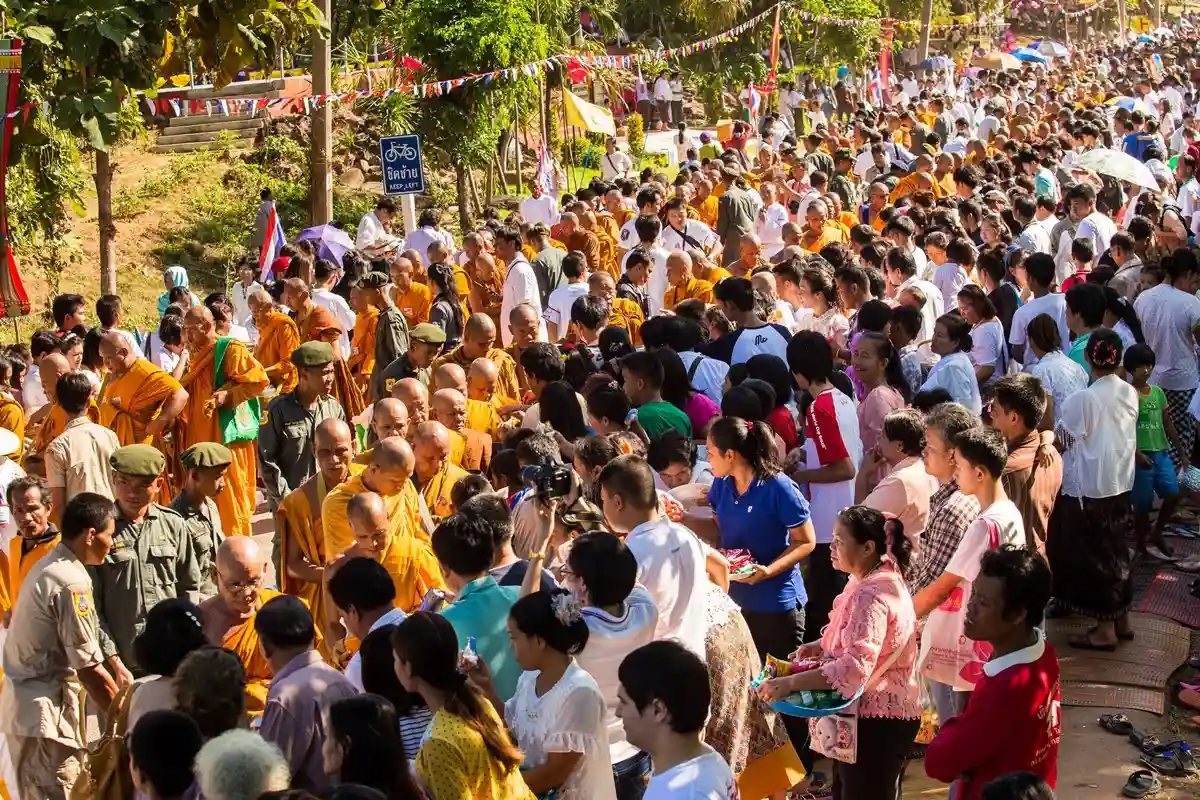
In the eleventh month, the end of the Buddhist Lent, there is a ceremony to offer winter blankets on the full moon day. There is a merit-making ceremony dedicated to Devo. Khao Thip stirring ceremony floating boat ceremony. This is the period where the big events are held almost throughout the month. since the full moon Winter blankets are offered to the monks on the 1st day of the waning moon. In the evening of the 14th day of the waxing moon, there is a rice stirring ceremony. There is a fair (boat race). On the full moon, there is a Prasat Pueng parade, a floating ceremony, a fire float (flowing a fire boat) to offer as an offering to the Lord Buddha. There are both merit making and fun.
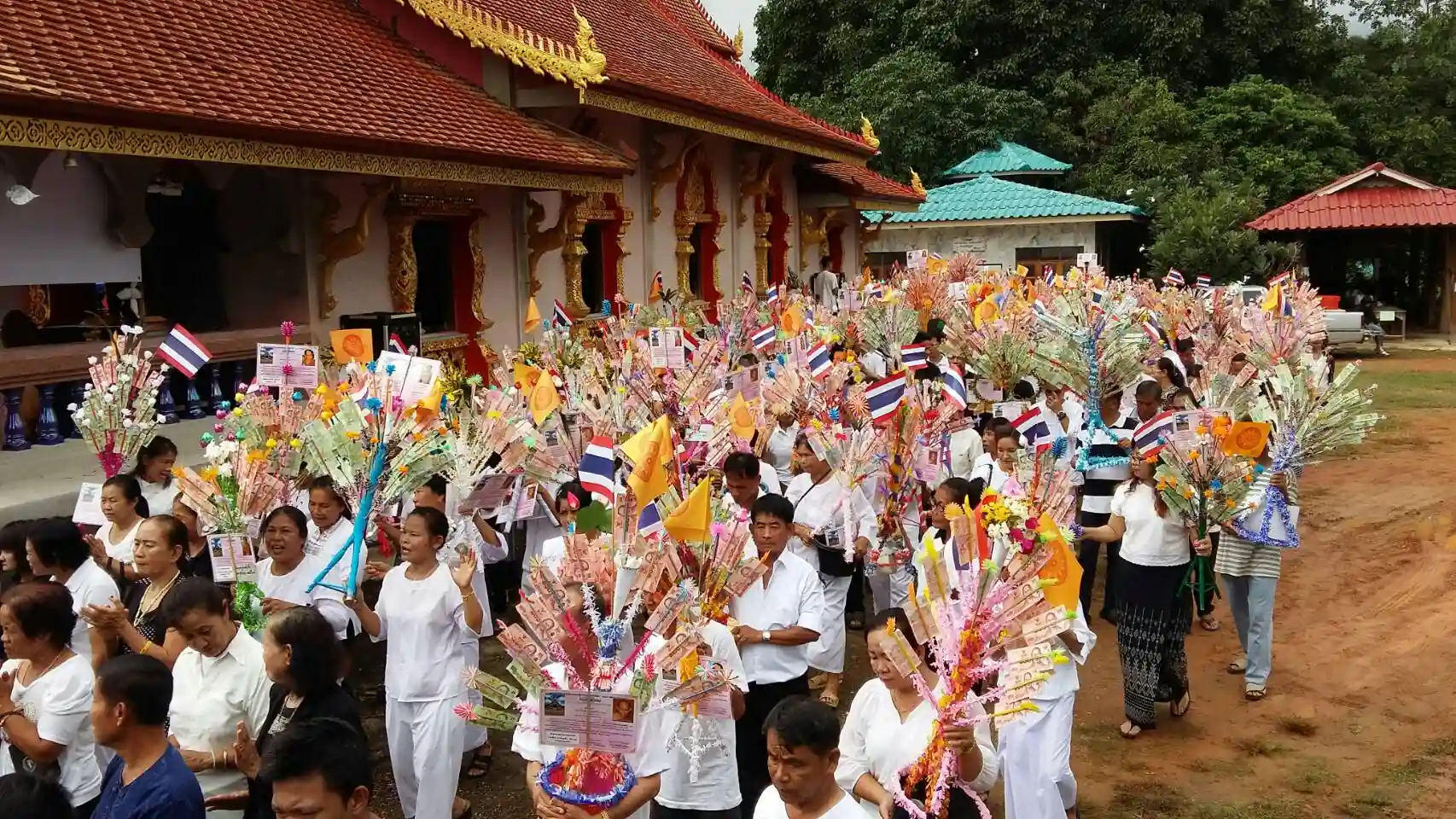
The twelfth month, merit-making, making merit on the Kathin ceremony, on the full moon day, making Khao Mao (Khao Mai) to offer to monks. with a sweet and savory deck in the afternoon preaching as a virtue The Kathin Ceremony at the temple where the Kathin has been reserved. According to the strict traditions still held in full, some held only the big merit ceremonies according to the village committee jointly organized. Some are big events of the year. Buddhist Lent candle parade The people of Ubon Ratchathani organize a big event every year, the Loi Hue Fai Festival. The people of Nakhon Phanom Province organize a big event on a regular basis. and the Prasat Phueng Parade of Sakon Nakhon people Organized as a regular big event, etc. Nowadays, there is a revival of the heat sipsong event as a big event for the conservation of cultural heritage assets and promoting tourism to the province as well.
Southern Tradition
Southern region is a land of islands with beautiful sea. There are many natural resources. There is also a culture And a way of life that is unique, charming, the southern region has different costumes according to nationalities Chinese descent will dress in Chinese style. If a Muslim will dress like a Malaysian At present, the original source of fabric is almost lost, can only be found in 4 sources: in Tambon Phum Riang Surat Thani Province, Mueang District, Nakhon Si Thammarat Province, Koh Yo, Songkhla Province and Na Muen Si Subdistrict, Trang Province.
Traditions in the south such as the alms-giving tradition, the Buddha rite tradition, the Suat Tang tradition, the Nang Dan procession tradition, the incense-candle alms-giving tradition, the Tenth Moon Festival tradition, the cloth procession tradition, the elderly bathing tradition, the Kuan tradition yaku rice and the Yok Khan Mak Phra Pathom tradition. Other interesting traditions are as follows:
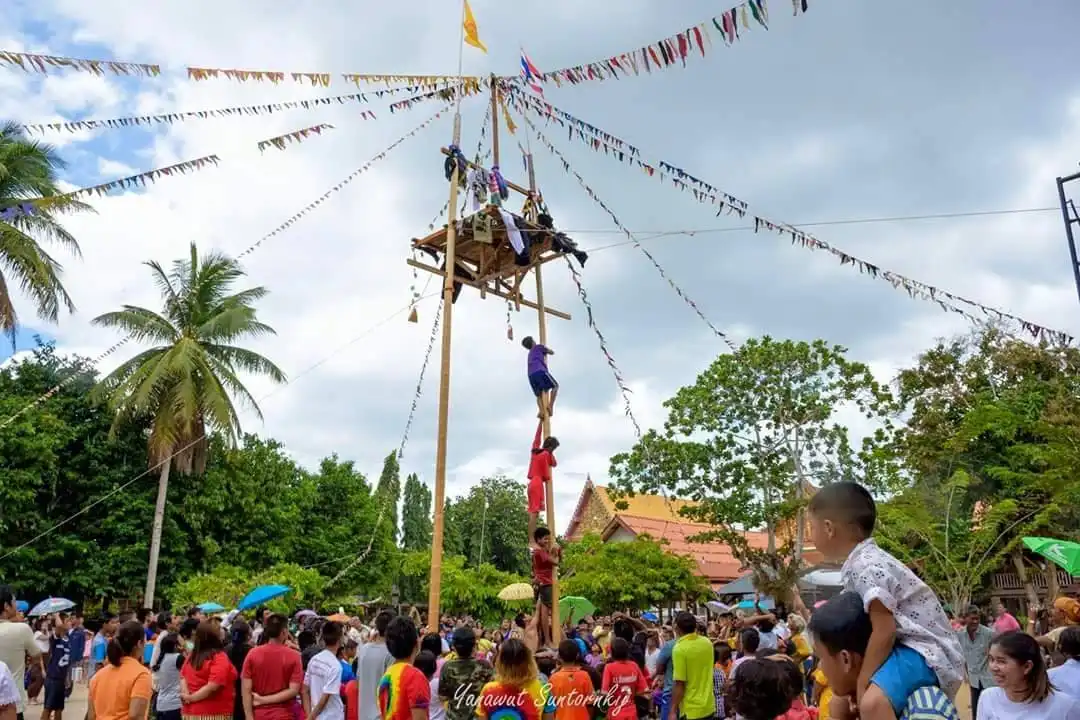
1. Ching Prat Tradition It's a southern tradition. Held to make merit and dedicate to the deceased ancestors.
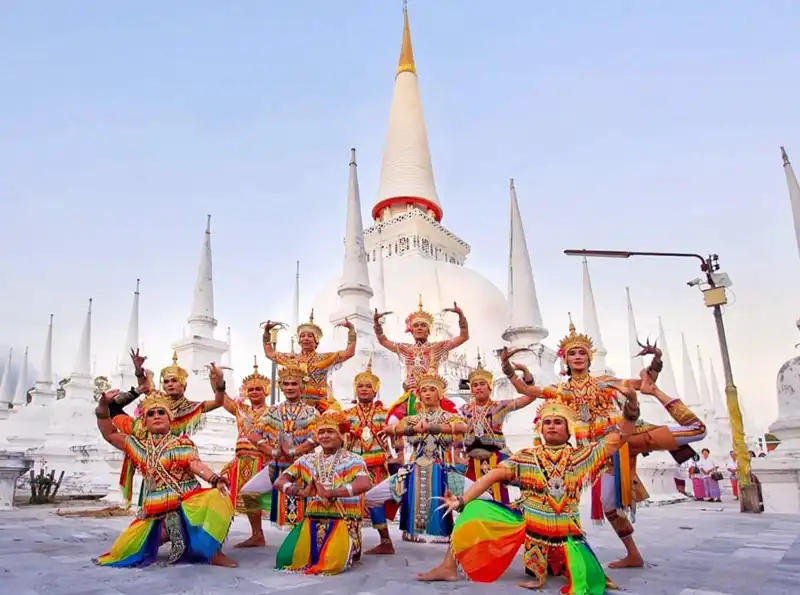
2. Manohra tradition This tradition is also a ritual of the Buddhist beliefs of the common people, which combines with Brahmanism and belief in animism. Including making offerings to ancestors.
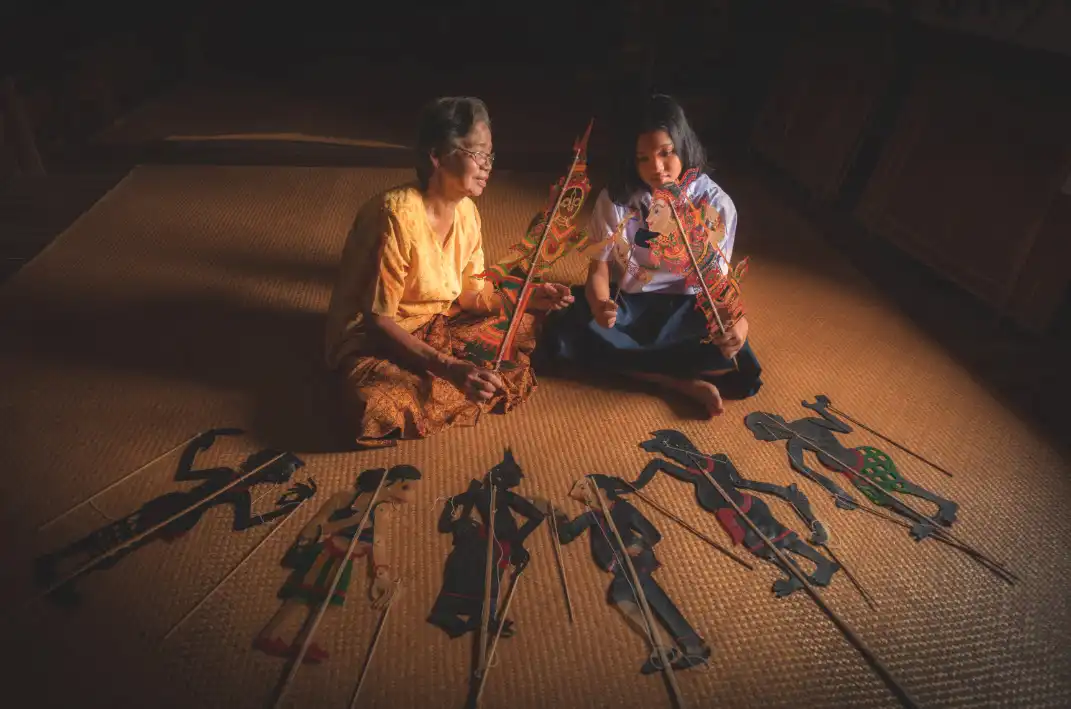
3. Nang Talung tradition It is a performing art of the southern Thai people that has been inherited since the ancestral period, religion, tradition, belief, architecture, economy, language, literature and politics, and so on reflected.
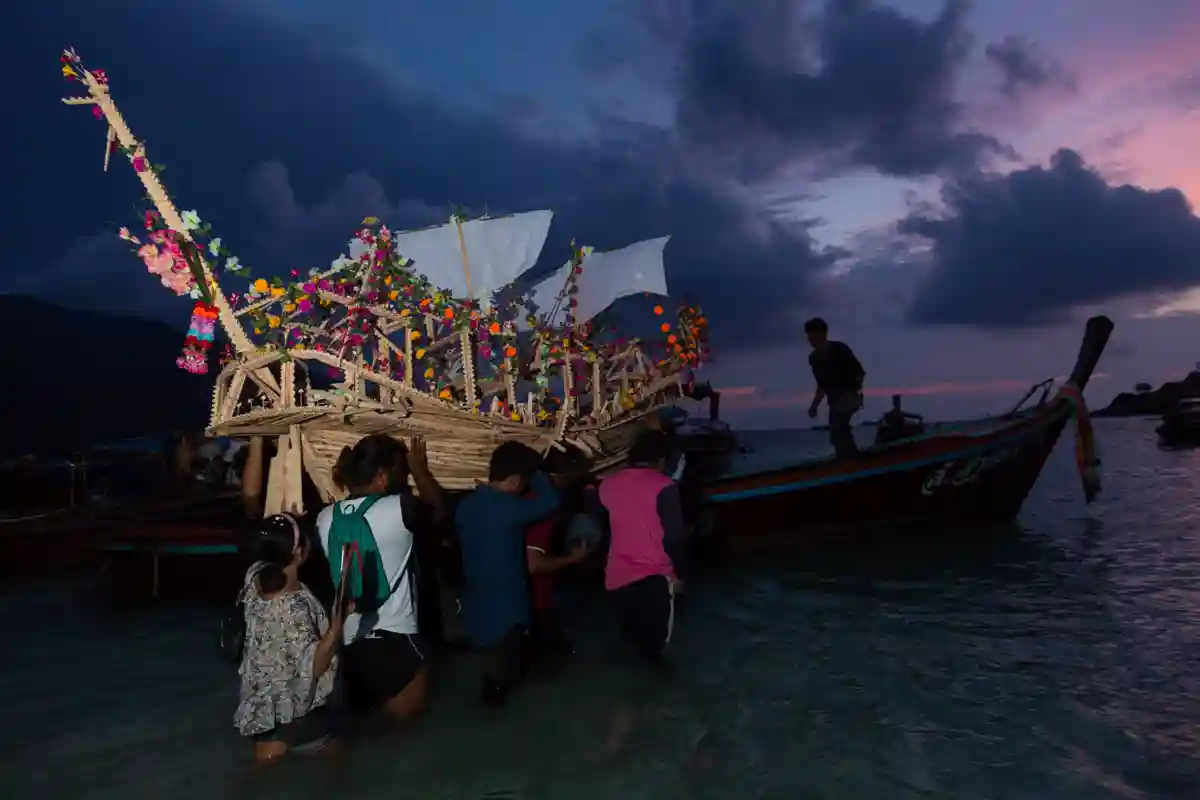
4. Boat Floating Tradition It is a tradition inherited from the original ancestors of the Urak Lawoi people. who live in Krabi and neighboring provinces The ceremony to celebrate the boat was to exorcise. Sending souls back to their homeland and the sending of animals to atone for sin.
Southern TraditionFood Culture in 4 Regions
The deliciousness of each locality is inevitably different according to culture and traditions such as
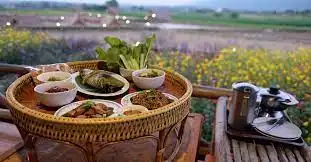
- Northern Food The diet consists of glutinous rice as the main diet. There are different types of chili paste. Local things such as chicken, pork, beef and fish are important local vegetables. which is an indispensable component There are many ways to cook food such as curing, curing, sautéing, yam, sautéing, piping, milking, roasting or stir-frying, simmering, and simmering, which in northern food tends to be very cooked.
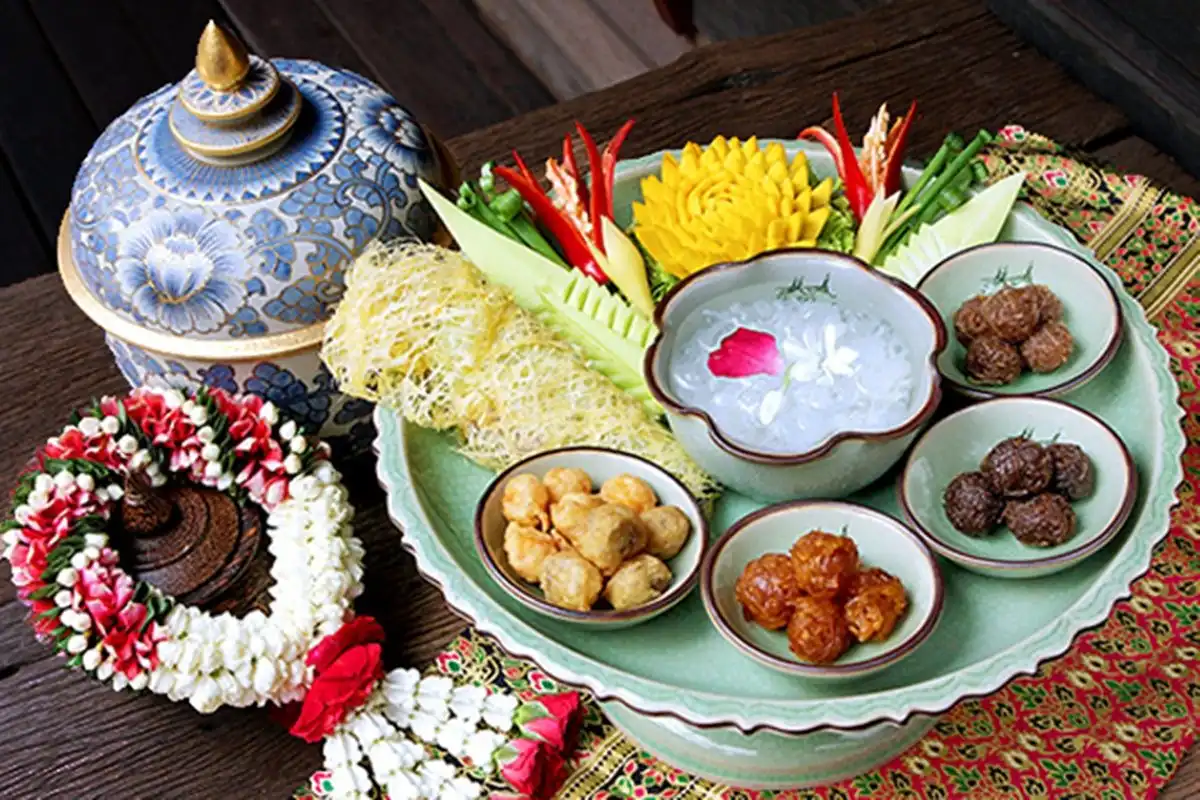
- Central Food It is a variety of food in terms of cooking, taste and decoration that is strange, appetizing, so it is exquisite and exquisite that has been conveyed from the food culture inside the palace. The central Thai people mainly eat rice. Eating at each meal is organized into a deck. There are many side dishes. The taste of food in the central region is considered to be more distinctive than other regions.
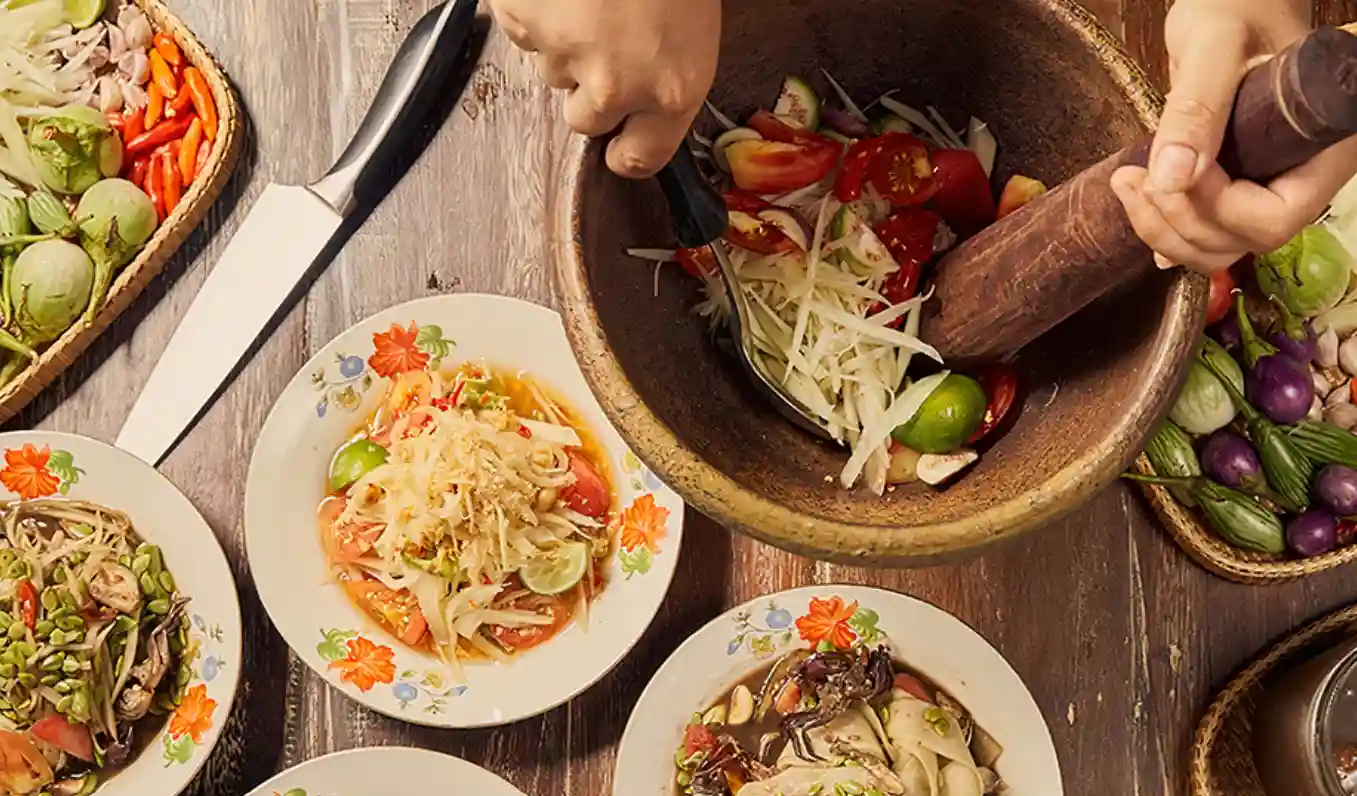
- Northeastern Food Isaan people are easy to eat food. usually can eat everything Because the Northeast Most of the areas are dry. plateau There is a big river and some high mountain ranges Lack of fertility than other regions for the existence of life in order to adapt in harmony with nature, people of the Northeast then know to seek things that can be eaten locally. be adapted to eat Or as a food, both vegetables from natural forests, fish from rivers and various insects. Most of the Northeastern food has a spicy, salty, sour taste. Northeastern people will eat sticky rice.
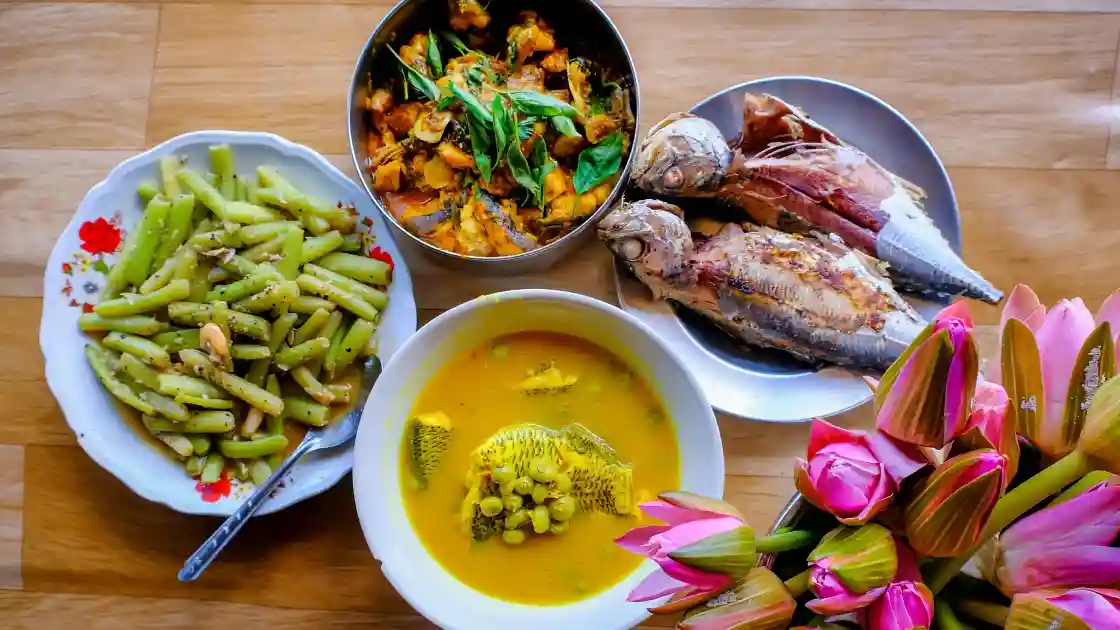
- Southern Food Southern local food has a unique flavor. Due to the fact that the southern region used to be a shipping center for merchants from India. Former China and Java thus making the culture of foreigners especially South India which is the origin of the use of spices in cooking has come to have a great influence as well as typical southern local food There is a mixture of local Thai food and South Indian food. The food of the South is more spicy than other regions, and due to the geography being close to the sea on both sides, there are plenty of seafood. But the weather is hot and humid, raining all year round. Curry foods and the dipping sauce is so spicy to keep the body warm can prevent illness.
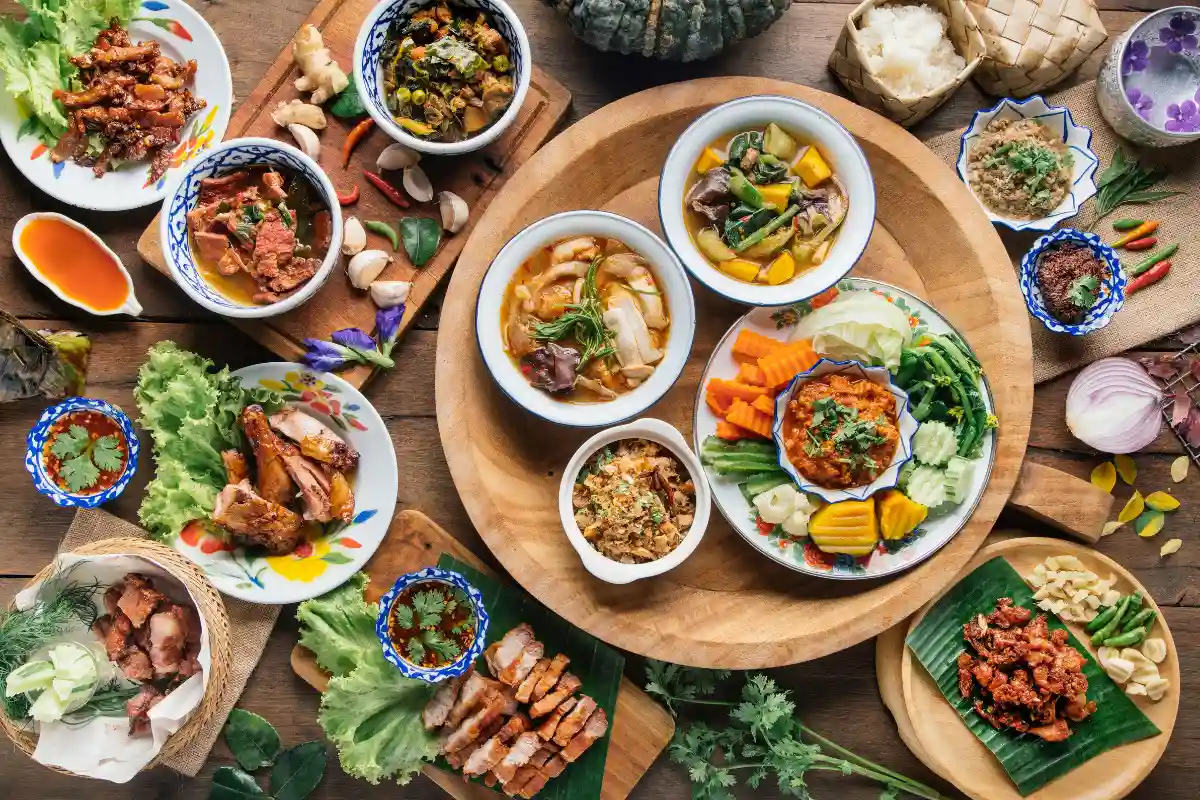
Thai Food Most of the cooking is ton, curry, salad, and salad, which has a simple cooking method. It doesn't take much time. but is meticulous Use quite a bit of oil in cooking. Not much meat is used. The protein sources are fish, eggs, pork and other animals. some local species Various seasonings use herbs obtained from nature. Most importantly, there are many types of local food that can be found. will be cooked as food Or use it as a dipping sauce for food such as chili paste. Or various types of simmered food. Thai traditional food is low in fat but high in dietary fiber. Has nutritional value such as vitamins, minerals, enzymes, fatty acids. It is safe from chemicals. It also provides medicinal value. The top 10 Thai foods from the 4 most popular regions of all time have won world-class awards, including:
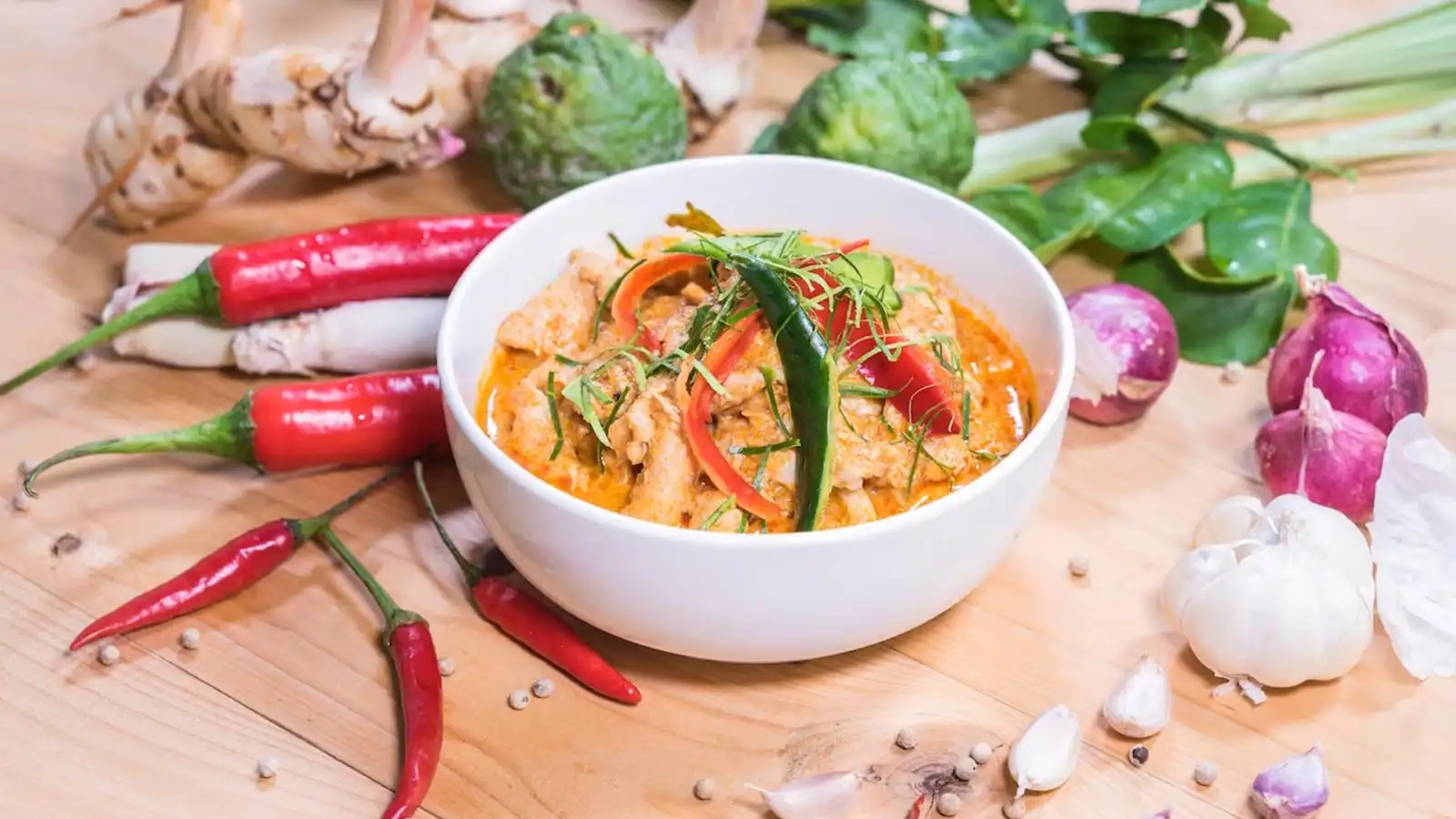
Number 1: Panang Curry Stew type food The Best Taste in the World from Taste Atlas is a thick Thai curry that emphasizes salty and sweet flavors. The main ingredients of the curry are chili, galangal, lemongrass, coriander roots, coriander seeds, cumin seeds, garlic, cinnamon and salt. Can be added to meat. Including beef, pork, chicken, and more.
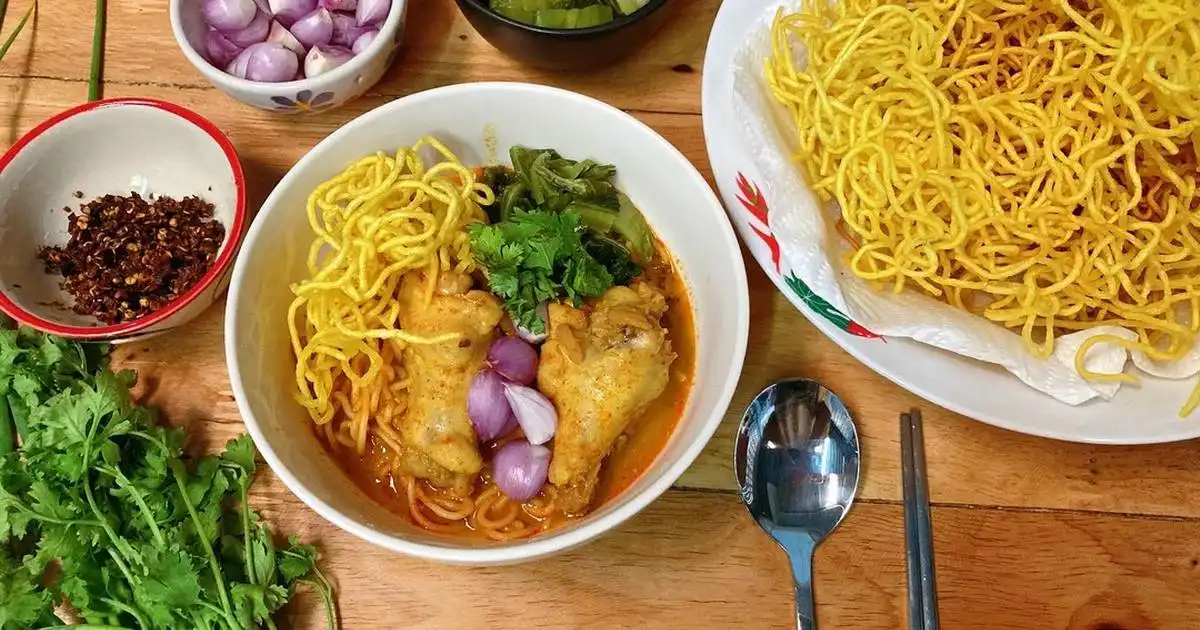
Number 2: Khao Soi Voted by foodies around the world Ranked No. 1 Best Soup of 2022 TasteAtlas, a website that collects recipes and reviews from food critics, presenting an interactive map of food around the world, ranks the 50 Best Soups, the best soups according to reviewers. Around the world Votes from foodies sent the menu "Khao Soi", a famous menu from northern Thailand, to take first place.
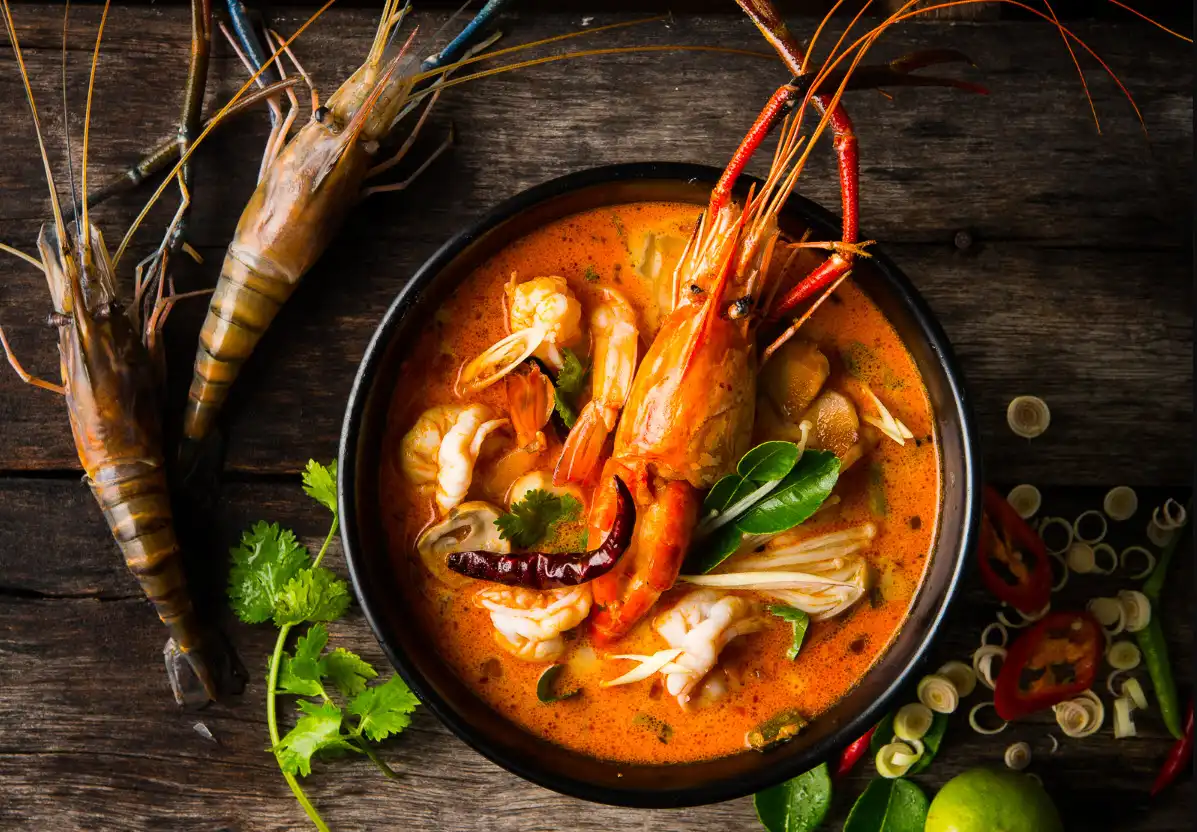
Number 3: Tom Yum Goong The website CNN Travel has selected soups from different countries around the world to classify as the top 20 best soups in the world, one of which is "Tom Yum Kung", the most famous menu in Thailand. It is a central Thai food, a type of tom yum. which is popularly eaten in every region in Thailand, both Thais and foreigners, it is a food that is eaten with rice. and has a main taste of sour and spicy mixed with a little salty and sweet. Divided into 2 types: Tom Yum Nam Sai and Tom Yum Nam Kon.
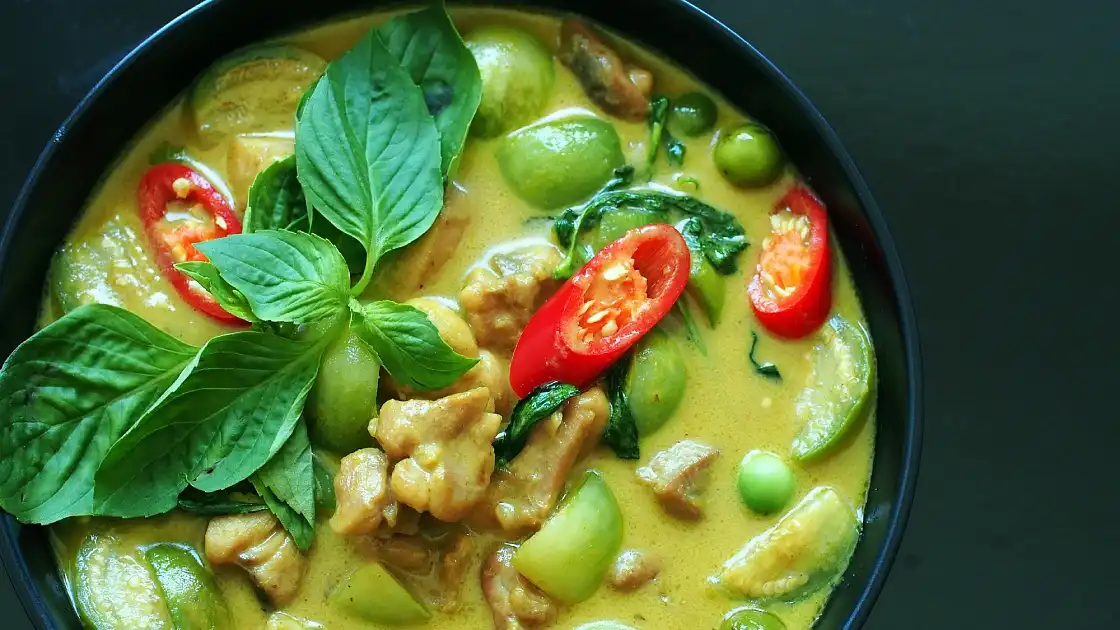
Number 4 Green Curry Voted by foodies around the world in 2023, TasteAtlas ranked 8th among the 100 best stews and curries around the world. It is a type of Thai curry food. It consists of meat, fish, chicken or pork and vegetables, seasoned with coconut milk, eggplant, sugar, fish sauce, kaffir lime leaves and basil leaves. It is often eaten with steamed rice or Khanom Jeen. Curry paste has a green color because it uses fresh green bird's eye chilies. In some areas, chili leaves are also added to the pounding. In Cambodia, green curry is served, called som lo kati, which has the appearance of clear coconut milk. Green curry is generally eaten as a side dish with other foods in a meal or eaten with khanom jeen as a single dish.
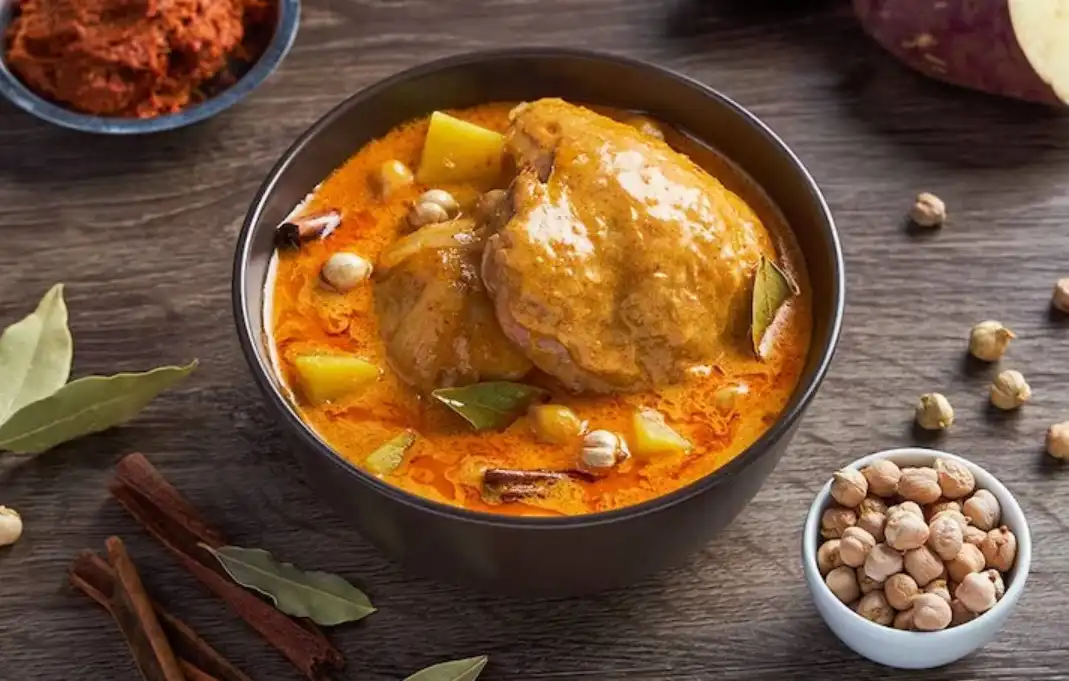
Number 5 Massaman Curry Cnn Travel's website has ranked the 50 best foods in the world. In 2021, "Massaman curry" of Thailand was ranked number 1. Previously, Cnn Travel ranked food in 2011 and 2017, which was the champion. The world is "Massaman Curry", the king of curries. And probably the king of all foods. This dish is spicy. Coconut milk's oiliness Savory and sweet.
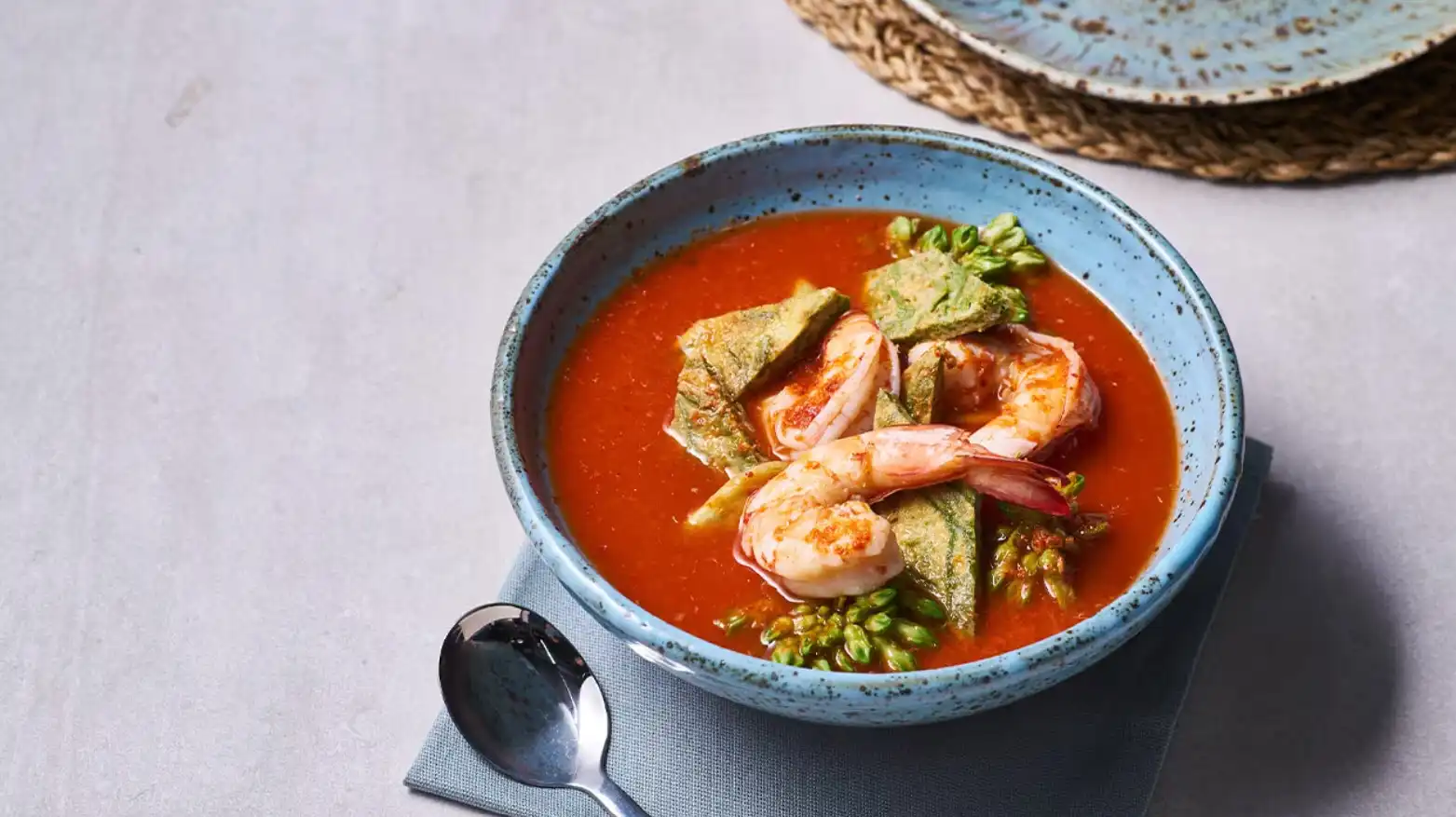
Number 6 Sour Soup Thai curry dishes are often prepared using fresh herbs. and fragrant leaves instead of mixing spices The most popular type of curry is Kaeng Som, which is prepared with meat and fish. It has a sour taste from tamarind juice. Voted by foodies around the world, 2023 TasteAtlas is ranked 10th.
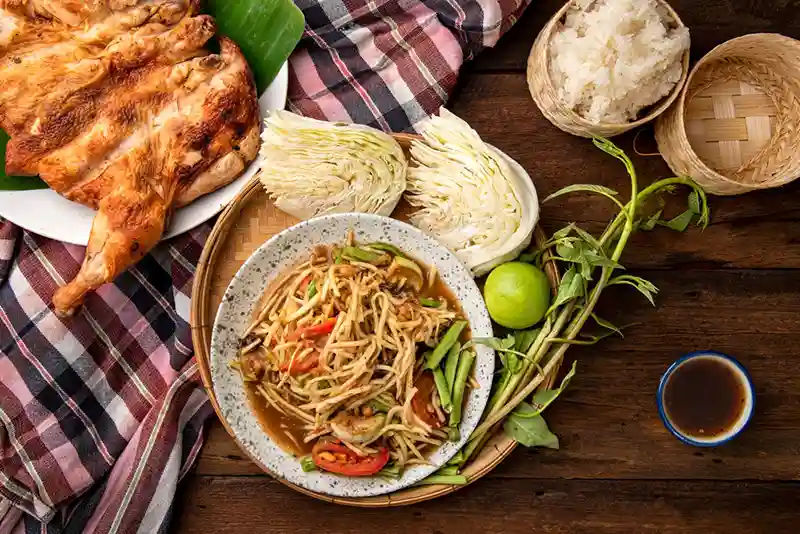
Number 7 Papaya Salad Ranked 6th in the world in the best salad category in the world, ranked by tasteatlas, for the spiciness of Somtam, the most delicious Thai street food menu. Eventually it became famous all over the world. It is a food prepared from making orange salad. is to make sour In Laos it is called Tam Mak Hung. It is prepared mainly by pounding raw papaya that has been chopped, sliced or grated into strips in a mortar. Along with other ingredients are small tomatoes, bitter eggplant, brinjal, fresh or dried chilies, yardlong beans, garlic and seasoned with palm sugar, fish sauce and lime. It is a Thai food that is very popular among Thais and foreigners.
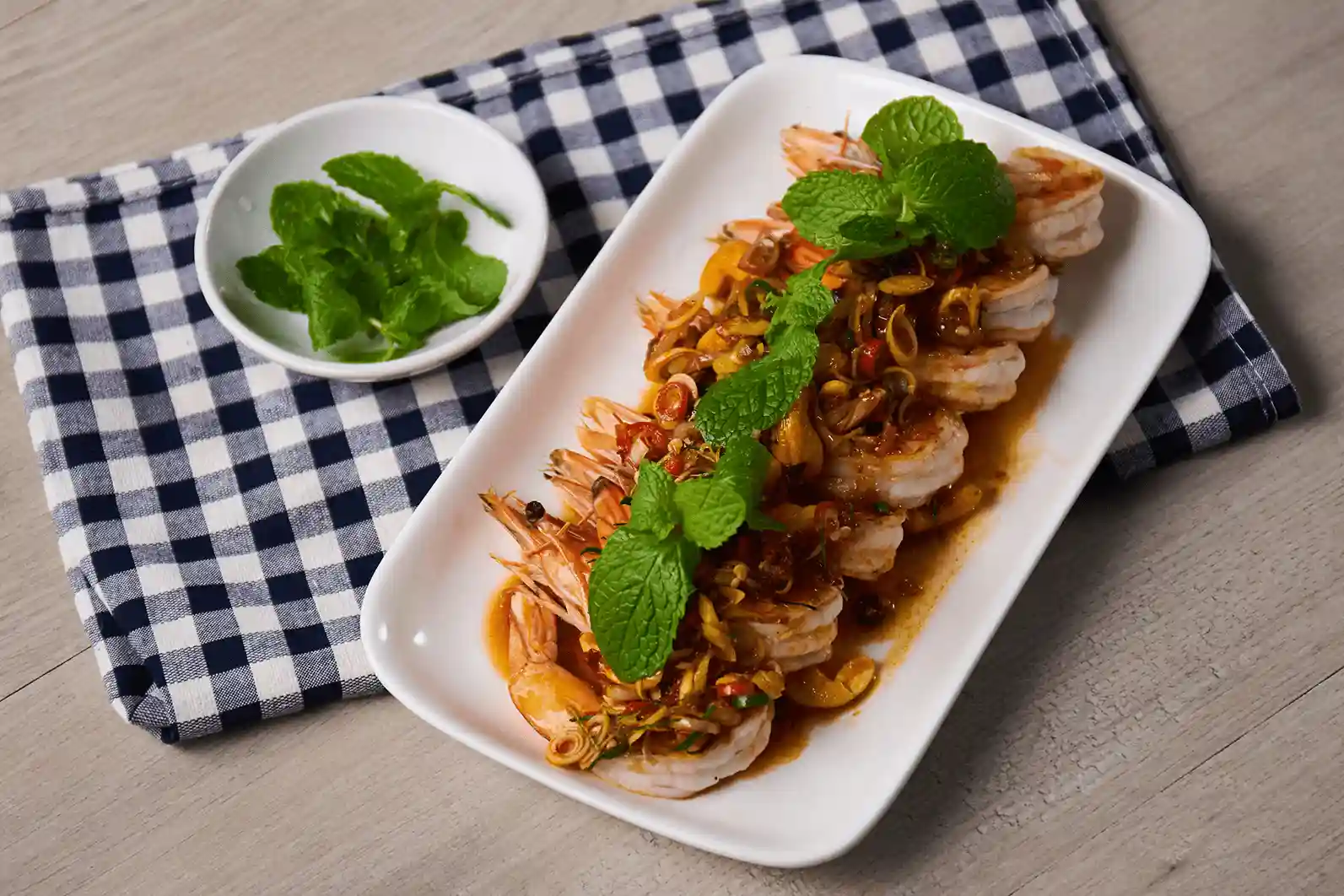
Number 8 Shrimp Salad Grabbed 9th place in the world in the best salad category in the world, ranked by tasteatlas. Royal Thai food menu. Phala means a salad menu that uses fresh meat to make, seasoned with lime juice, fish sauce, chili, shredded lemongrass and mint leaves, etc. It is one of the ancient Thai foods that is popular nowadays. The popularity of eating raw food is decreasing. Because people are more concerned with hygiene. Phla has therefore adapted to use more cooked meat, such as this dish, "Pla Kung", fresh shrimp with firm flesh. Mixed with spicy salad sauce If you try it once, you will definitely like it.
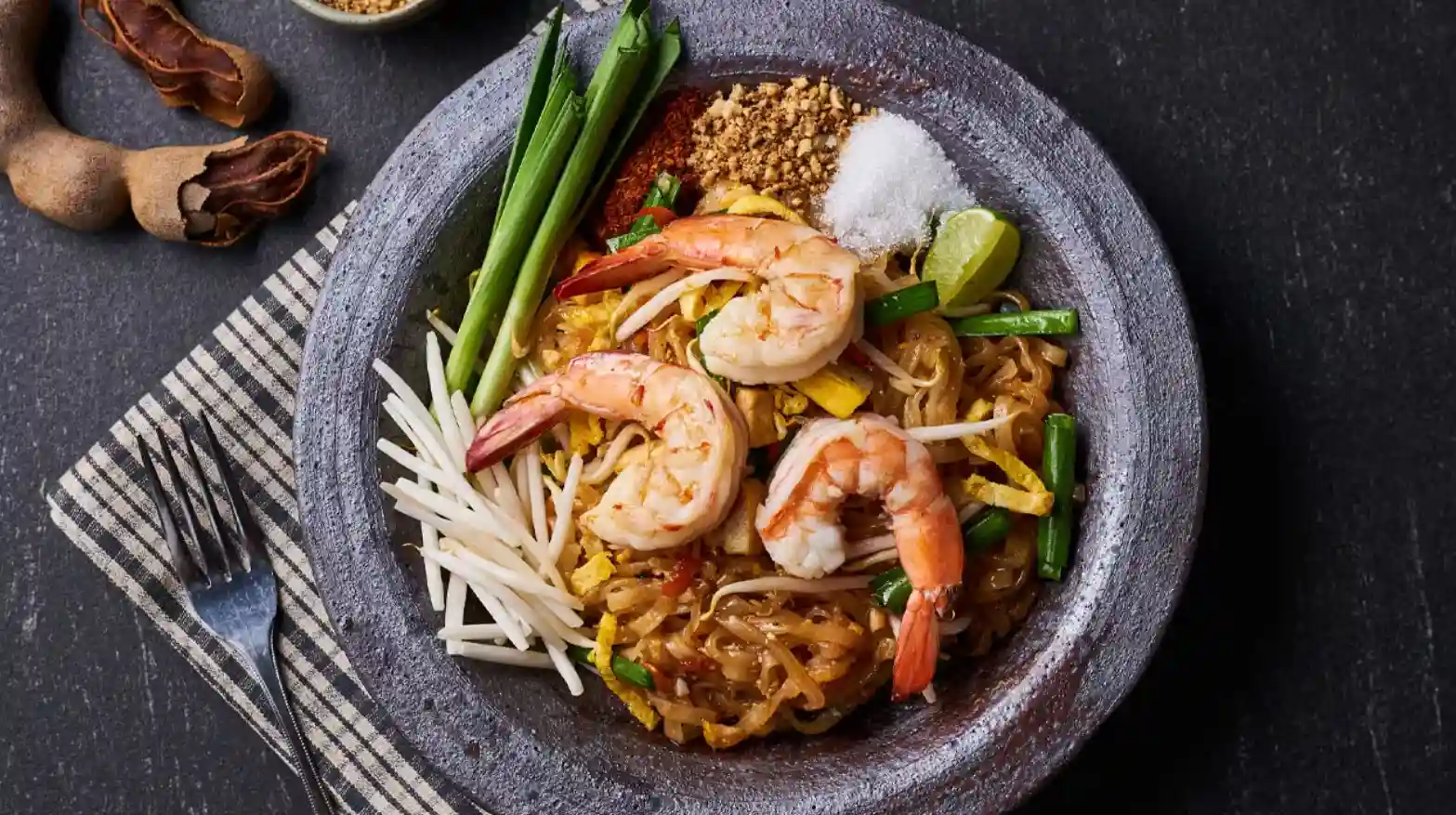
Number 9 Pad Thai Not least, it was ranked 4th in the most popular food menus ordered via food delivery in the United States in 2023. Noodles are the national food of Thailand. It is a menu that Thai people eat regularly. And it's a menu that foreigners give a thumbs up for its deliciousness. Its easy-to-eat flavor makes it easy for people from all over the world to enjoy. Delicious Thai style that is outstanding and unique. Make those who have tried it fall in love with it. and raised it to be a favorite menu that must be eaten.
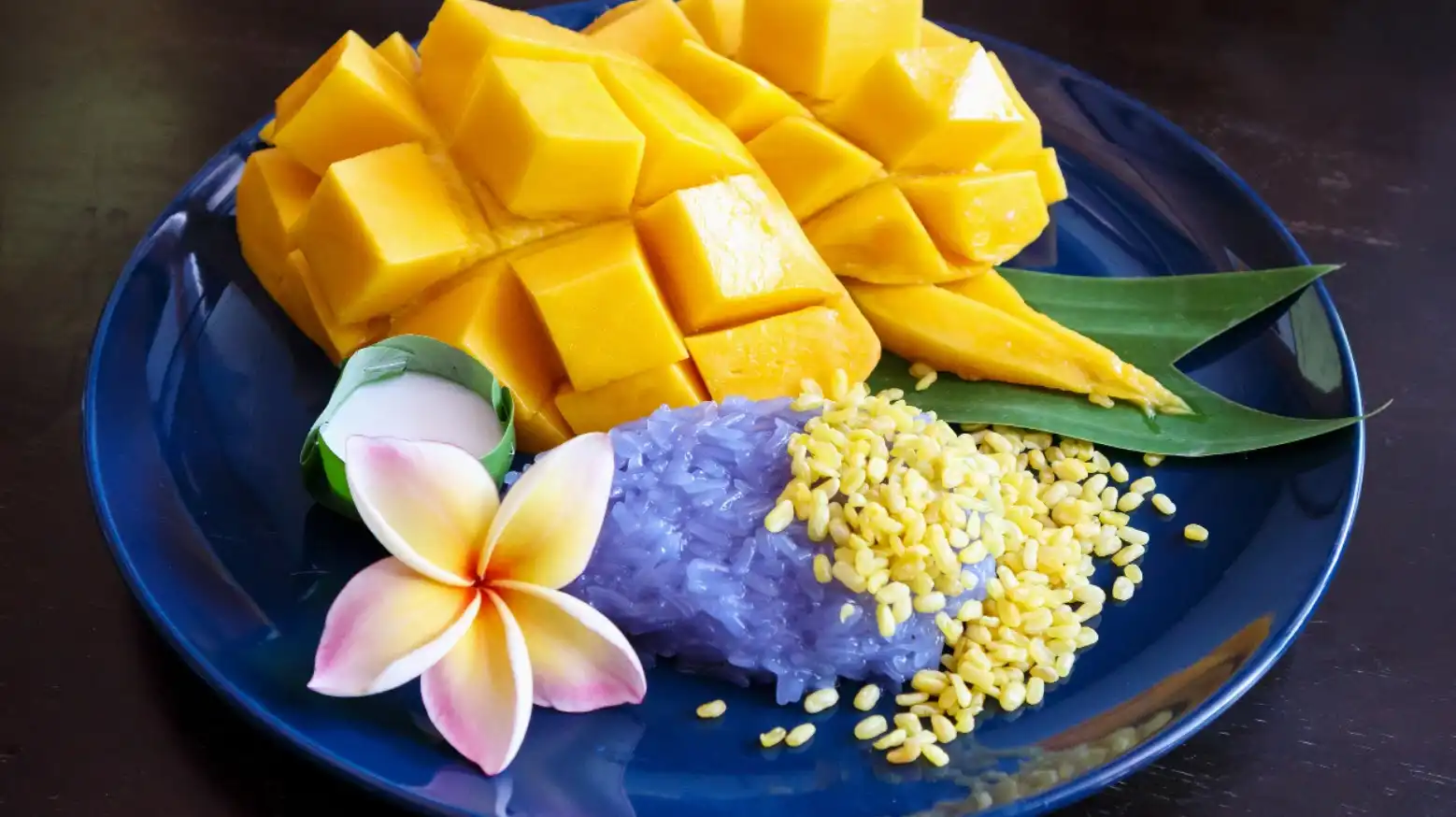
Number 10 Mango Sticky Rice CNN International food rankings and the world's most popular dessert, praised for its mango sticky rice It is a Thai dessert menu that has been accepted internationally. And it's the reason that It is often served on the table with Thai food menus. Until it has become a menu that many people think of ordering to eat with their loved ones. family and friends It is a local dessert in many Southeast Asian countries. It is popular to eat during the summer because it is the mango harvest season. Mango sticky rice basically consists of moon sticky rice sweetened using palm sugar or coconut sugar. Moon goes with coconut milk and salt. The style eaten in Thailand uses ripe mango, which has a sweet taste.
4 Sectors of Dress Culture
Thailand consists of 4 different regions: the North, the Northeast, the Central and the South. and climates that are different in each region Make traditions Art and culture, such as the cultural dress of each group of people Therefore, it has its own identity. The North does not dress like the South. Culture therefore refers to what human beings change, improve or produce. Created for the prosperity of the community group or their own country, so they have passed on to each other. set aside Including products that have been learned from the ancients inherited as a tradition according to the way of life lifestyle, geography, beliefs, religion.
Northern Dress Culture
The indigenous dress of the North has different characteristics depending on the ethnicity of urban people Because people of various ethnicities live in areas where indicate the uniqueness of each local area For northern women, they will wear sarongs or sarongs whose length is almost to the ankle. Which is popular to wear both young and old, sarongs are exquisite and beautiful, the skirt feet are beautifully patterned, while the clothes are round-necked shirts, colorful, beautiful patterns, may be worn over a sarong and hairpins.
For men, they prefer to wear trousers that look like 3-part trousers. called "Tiao", "Tiao Sador" or "Tiao Ki", made of cotton, dyed blue or black, and wears a cotton shirt with a round neck, short sleeves, chest cut, 5 buttons, blue or black, called the Morhom shirt.
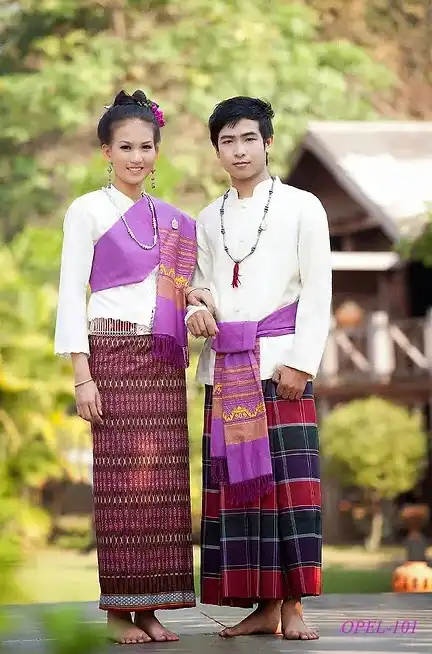
Central Region Dress Culture
Man In the past, the change of regime Popular to wear joong. Stingray wore a white shirt, fastened with 5 buttons called "Ratchapataen", short hair on the side, cropped to the scalp above, combed through the middle part.
Women. In the past, the change of regime. Popular to wear a sarong Half-knee length, covering obliquely according to the Ayutthaya period Hair style is knotted. and wear jewelry for beauty.
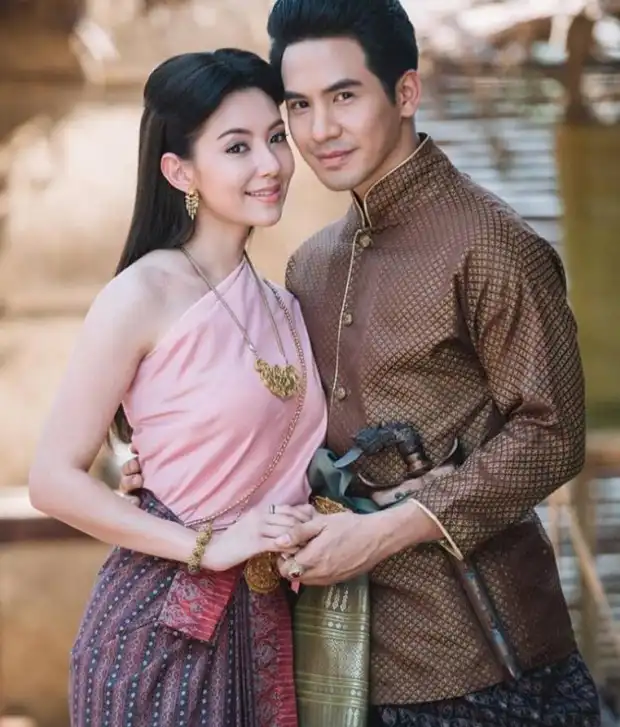
Northeastern Clothing Culture
Most men prefer to wear a dark short-sleeved shirt called "Mah Hom" and wear pants in the same color as the knee-length shirt. It is commonly used to girdle with a loincloth.
For women, most of the dress is popular to wear a sarong that is woven all over the body. Wearing a colorful open neck shirt sabai oblique blanket Wear jewelry on your wrists, ankles, and neck.
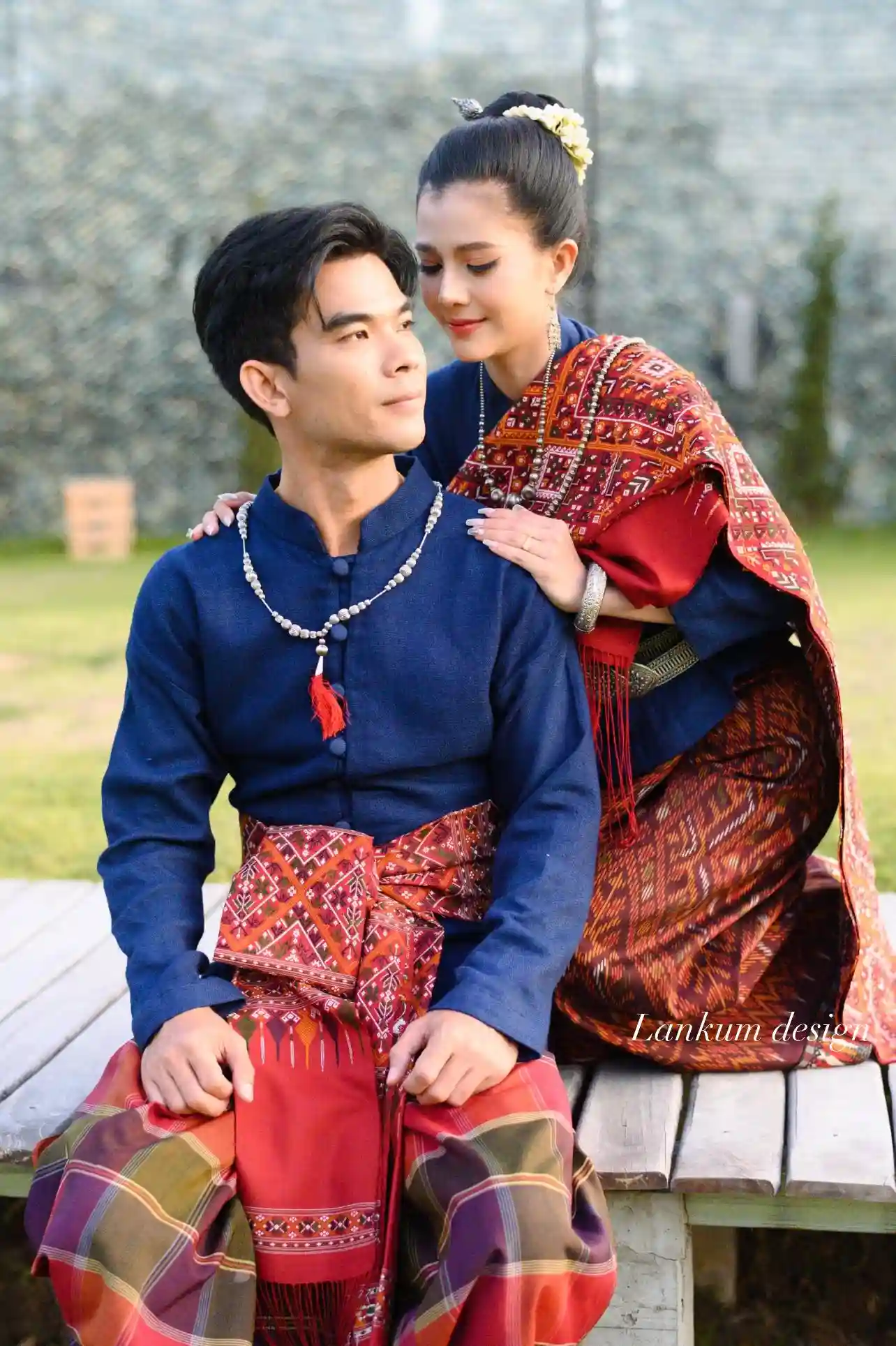
Southern Dress Culture
The dress of the southern people is not the same as the dress. Other regions, because Southerners dress in many styles of fabric, including cotton, crepe, candle-patterned fabric, tie-dye fabric, but the most famous fabric in the South is Yok fabric. It is a fabric that is very famous but common people. original style wearing clothes like a loincloth that is red wearing batik cloth with various colorful patterns It was popular after being influenced by Malaysian fabrics. and Indonesia.
Southern Thai Muslims like to wear sarongs that are similar to Loincloth of the Northeast Most men would like to wear a sarong, but women. Will wear batik or batik The famous fabric of the south is Nakhon Si Thammarat Yok Muang fabric, Koh Yo weaving fabric Ten thousand color woven fabric Phum Riang woven cloth, Squirrel tail cloth, Batik cloth, Pattani woven cloth, etc. The dress is different. in the use of materials and patterns with uniqueness according to the ethnicity of the people A variety of people who come to live in this ancient land.

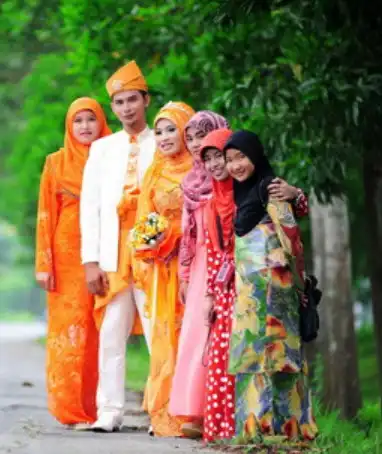
4 Regional Dialects
Dialects are the Thai language that is used in various regions of Thailand as native languages. or traditional language of local people who speak and communicate Which shows the specific characteristics or identity of the local people. The dialect is different from Thai language. sound standard both tonal sounds, vowel sounds, and consonant sounds.
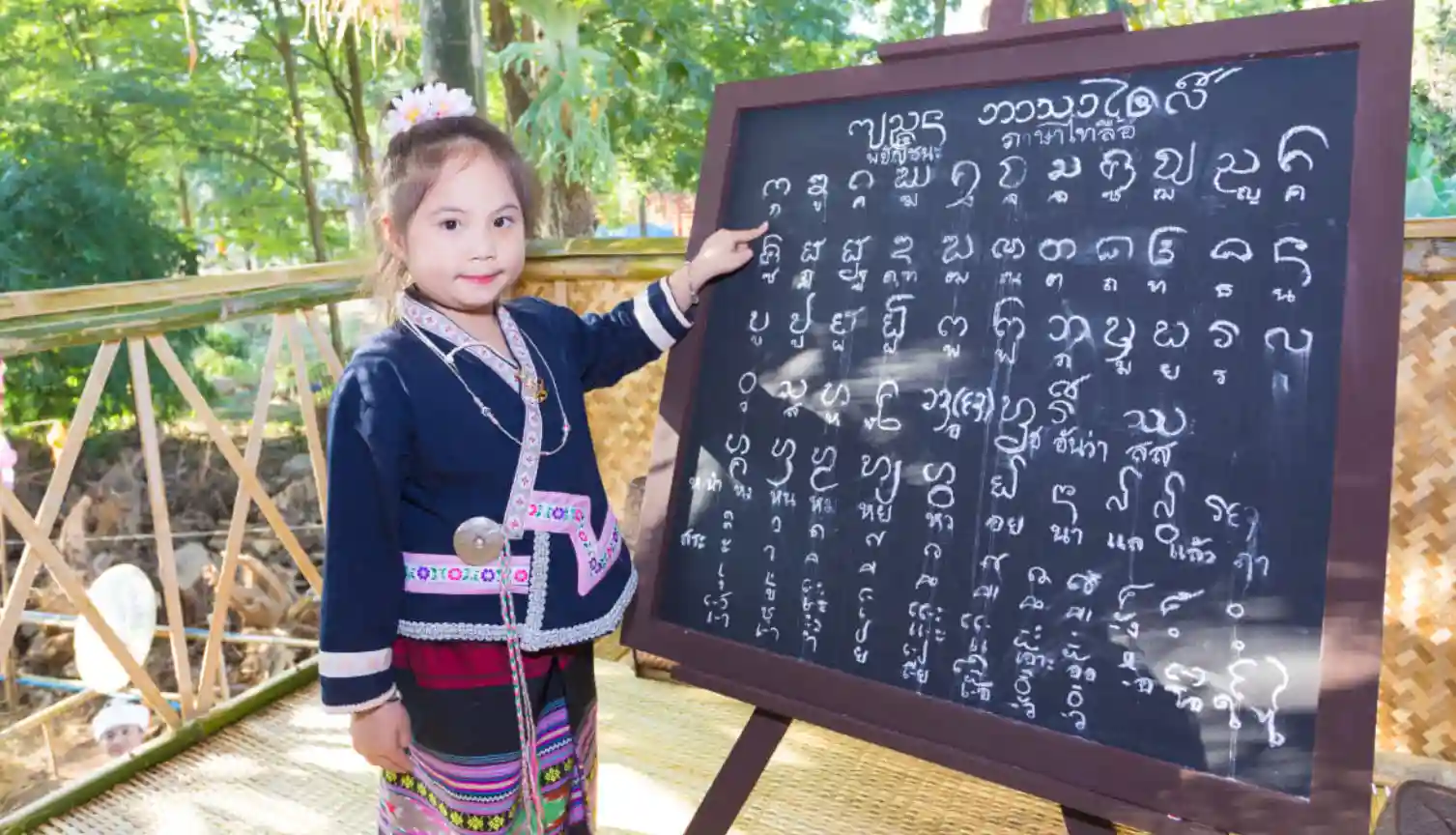
- Northern dialect, the sound of the word will drag a long, slow and sweet sound.
- Isan dialect, pronounced quite fast, firm, most words have a high pitched sound.
- Southern dialects use short words, pronounced succinctly and quickly, such as crocodile as ke, road as nhon.
- Central language, dialect used to communicate only locally which are different in sound, word usage and meaning so there must be Standard Thai to be used as a common language for communication.
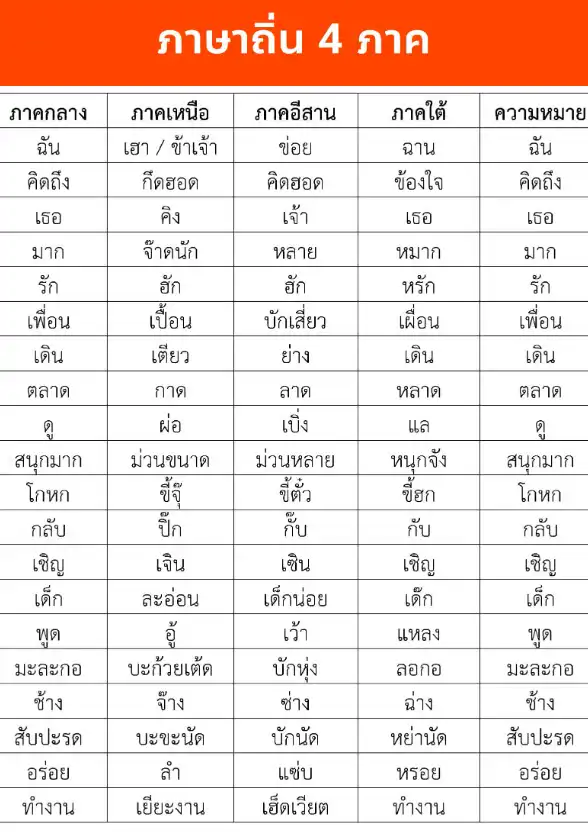
Thai musical instruments in 4 regions

1. Northern folk music The musical instruments of the North are divided into the early periods, which are percussion instruments, such as hollow logs used in rituals. In the story of the devil and the forest king, then it has been developed by using animal skins to stretch at the mouth of a hollow log to become a musical instrument that is learned as "drums". According to the activities or ceremonies used, such as the tambourine drum, the long drum, the Mong Seng drum, the two-faced drum and the Taphon Mon drum, etc.
by being charming And the distinctive feature of northern folk music is that the pluck, color, beat and blow instruments are mixed together to make it complete and melodious. Especially in terms of accents and melodies that flutter according to the atmosphere. The gentle softness of nature combined with the culture in the royal court resulting in a transfer and playing music in both the court style of Khum and the palace and folk style with local identity.
2. Central folk music The instruments of the central region usually consist of plucked, colored, beating, and blowing instruments, which can be classified as follows:
- Plucked instruments, including the zither and the jong-nong
- Si instruments, including sow duang and sow ou
- The percussion instruments are Ranat Ek, Ranat Tum, Ranat Thong, gong, cymbal, cymbals and Krab.
- Woodwind instruments include the flute and the oboe.
by being charming And the distinctive feature of the central folk music is that the central region's pipat ensemble will develop in a way that combines with the royal music. It has developed mainly from the bagpipes and drums to xylophones and gongs, as well as adding more musical instruments. more until it is a large band Including a chorus that is similar to the Pi Phat of Luang which is the result of the cultural transfer between the royal and royal cultures.
3. Folk music in the northeastern region (Isaan) has evolved for thousands of years. starting from the beginning Local materials are used to imitate natural sounds. Most of which are short, unresonant sounds. In the later periods, natural indigenous materials were used to blow, such as leaves, wood skin, and bamboo joint grass. make the sound flutter longer
Later, it was developed to use animal skins and leather to be used as materials to create musical instruments that are more beautiful and beautiful, such as Krab, Armor, Xylophone, Gong, Drum, Pong Vot, Pee, Phin, Pong Lang and Khaen, etc.
By being charming and the uniqueness of Isan musical instruments is The combination is a Northeastern folk band that has 3 specific characteristics in the area, namely the Northeastern group. and in the middle of the Northeast will be popular with Mo Lam music with Khaen playing and play the harp in harmony with the singing As for the South Isaan group, it is popular with Kantrum music, which is a beautiful instrumental music of the South Isaan people who are of Khmer descent. There is also a Pinphat band and a Mahori band. Each group of villagers will play these songs together for fun Used for plays, performances and various ceremonies.
4. Southern folk music Southern musical instruments are simple. There is a fabrication of musical instruments from nearby materials which assume that the traditional folk music of the south should be will come from the rambutan Sakai that use bamboo trunks of different sizes, cut into short pieces, some long Then cut the mouth of the bamboo tube straight or oblique and cover it with the leaf or sheath of the plant. Used for singing and dancing.
Later, it was developed into instruments such as trumpets, krubs, drums such as drums, tambourines that were influenced by the Malay people. Chatree drums or Tuk drums used in Manora performances Which was influenced by India, etc.
By being charming and the outstanding characteristics of southern folk music will be influenced by many nationalities nearby lands. Until the combination is unique, different from other sectors, especially in the emphasis on rhythm and style that is fast, intense and lively, etc.
Popular Thai festivals in 4 regions
A festival is a type of event (an event or activity) usually organized by a local community. focusing and celebrate some of the uniqueness of that community and that festival Festivals are often associated with a community's traditions, beliefs or religion. Most festivals are held once a year. by taking the anniversary of the previous festival to set up the next one.
Thailand has one of the most public holidays in the world. Festivals are important, and celebrations can be combined with local traditions. In addition, it is very attractive because it is fun. be unique and exciting As a result, tourists nowadays are very interested in the various festivals of Thailand. The important festivals that have received attention and popularity are as follows:
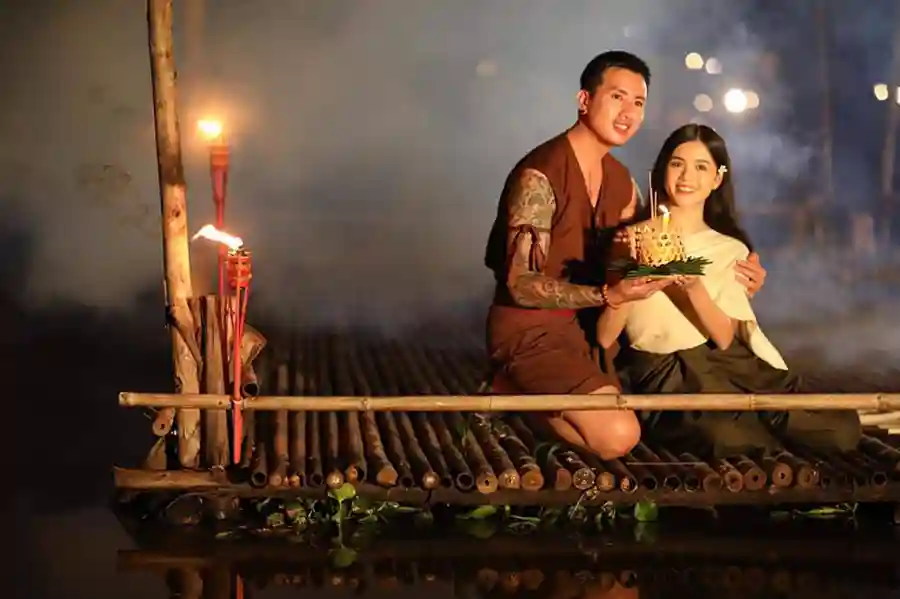
1. Loy Krathong Festival It is a ceremony that usually takes place on the night of the full moon of the 12th lunar month, where flowers, joss sticks, candles or objects are placed into various artifacts that do not drown, such as krathongs, boats, rafts and lotus flowers, etc., and then float along the river. to express gratitude to Phra Mae Ganga which is a source of water for humans to take advantage of, including asking for forgiveness for throwing waste down.
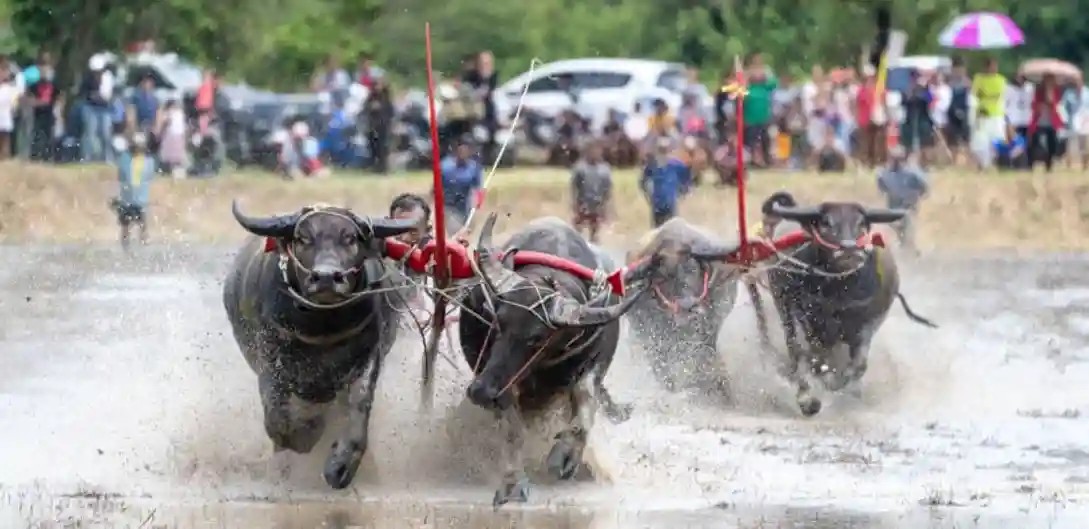
2. Buffalo Running Festival It is a festival in Chonburi province. The purpose is for the villagers to prepare things to offer to the temple, relax and socialize among the villagers who are tired from work. and giving the buffalo a rest due to the hard work of farming At present, the buffalo running tradition is a tradition of Chonburi Province. It is famous and well-known among Thais and foreigners.
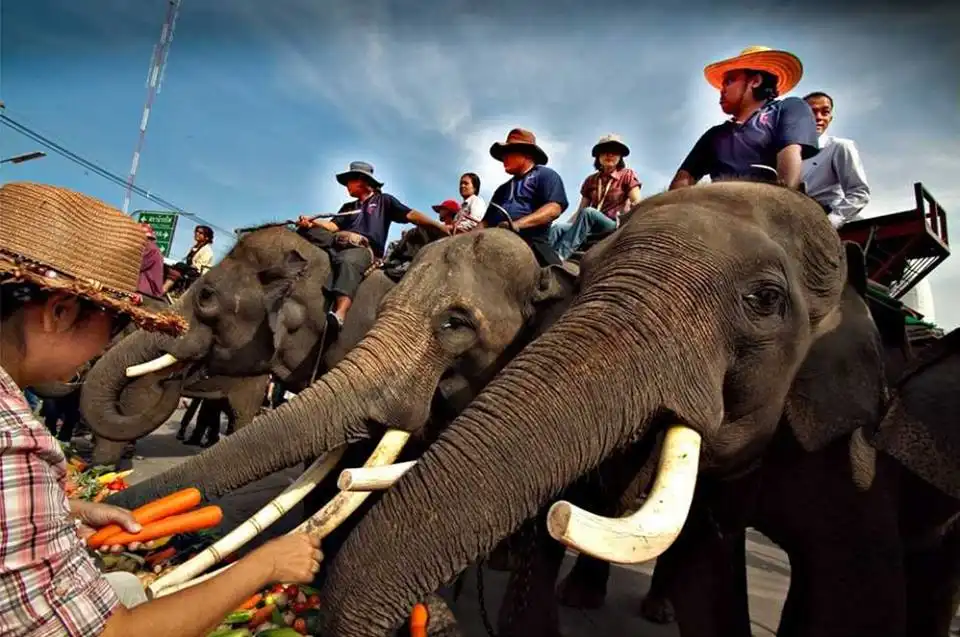
3. Elephant Festival Festival of Surin Province Elephants are regarded as invaluable animals. and is an important animal of Thailand in order to absorb the good history presented by the new generation To persuade the new generation to pay attention to arts, culture, traditions and local history.
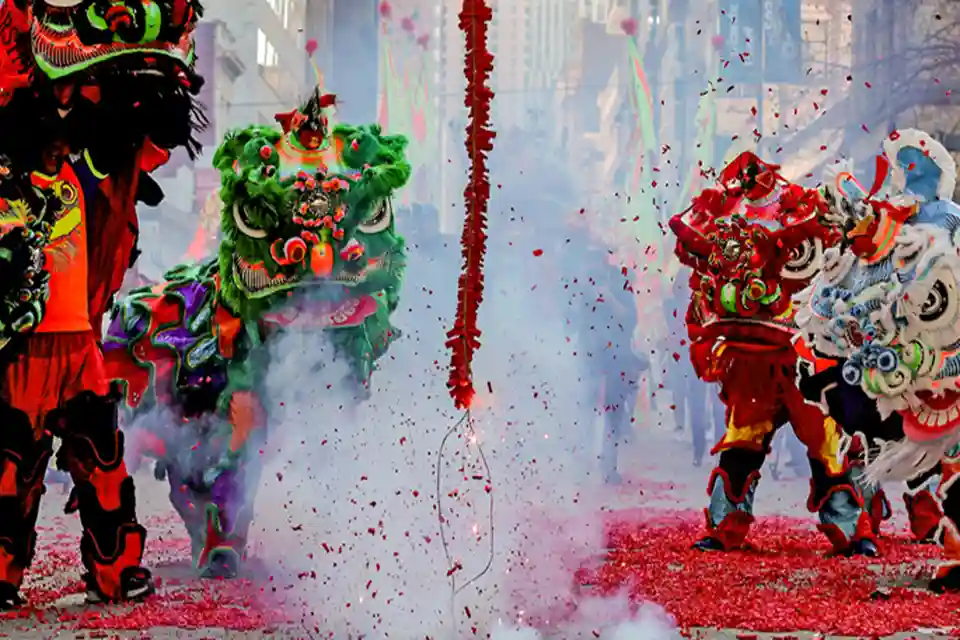
4. Chinese New Year Festival In Thailand, there are 3 days of traditions, namely the day of paying respect, the day of worship, and the day of travel. especially in Chinatown in Bangkok.
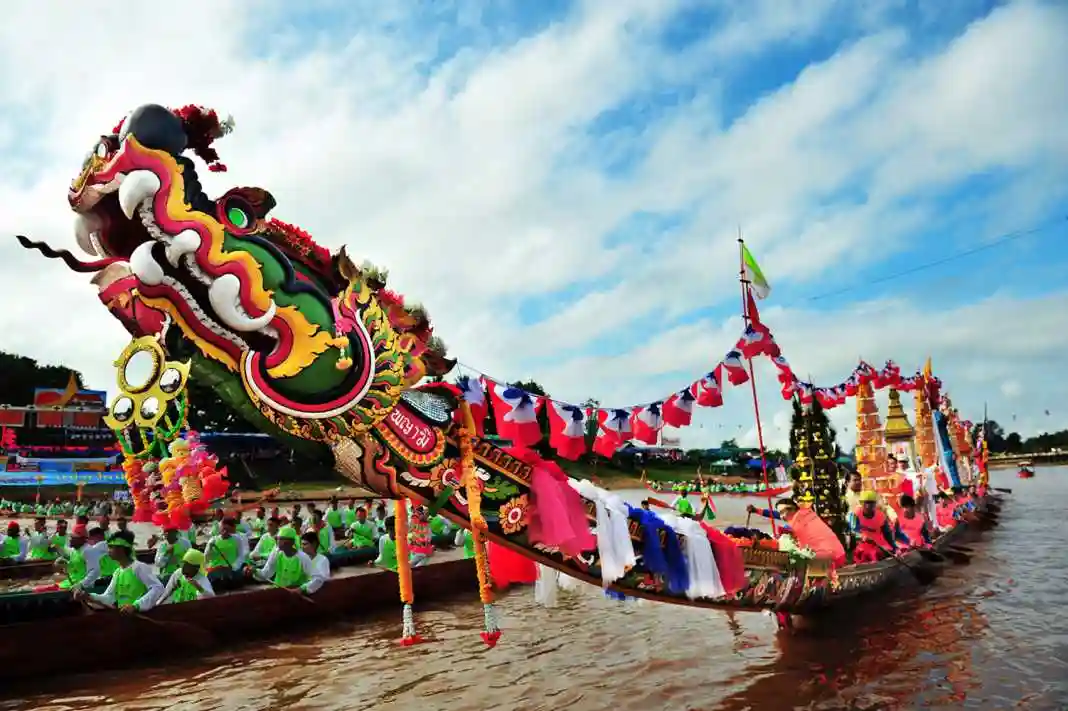
5. Fegatta Festival upstream community which is like the web of life, water has been important to the way of life and well-being of the Nan people since the past From a simple, beautiful life and the relationship with the Nan River in the past Nan people therefore hold a boat race every year to build unity. The body is made of a whole log. There is a prow made in the shape of a serpent. Freshly painted hull and has a beautiful pattern.
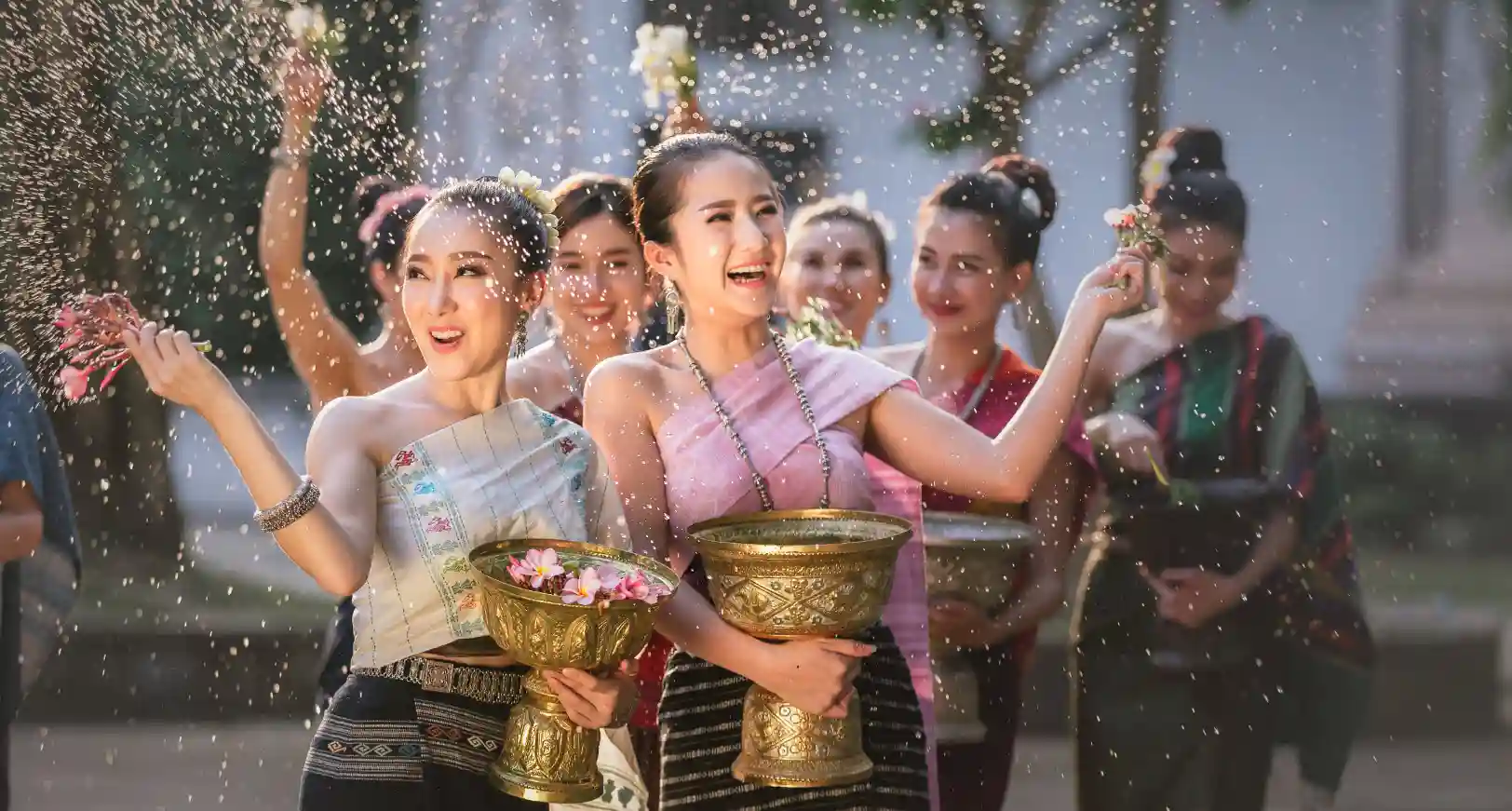
6. Songkran Festival That is the day of the Thai New Year. which adhered to the practice of continuity since ancient times And it is a beautiful national culture deeply embedded in the lives of Thai people. Songkran Day falls on April 13-15 every year. Thai people like to play in the water. Pouring water on elders' heads, offering alms to monks and bathing Buddha images on Songkran Day.
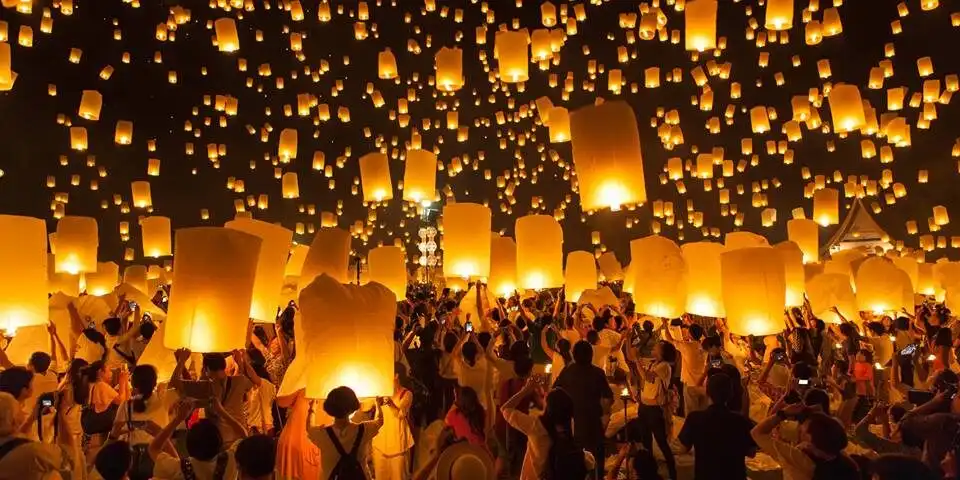
7. Lantern Festival Yi Peng is a traditional Lanna Loi Krathong festival held on the full moon day of the 2nd lunar month of the Lanna people. The lighting of lanterns soaring up to light up the sky with the belief that to worship Phra Ket Kaew Chulamanee that is on heaven or some believe that it is a misfortune or exorcise bring auspiciousness to life.
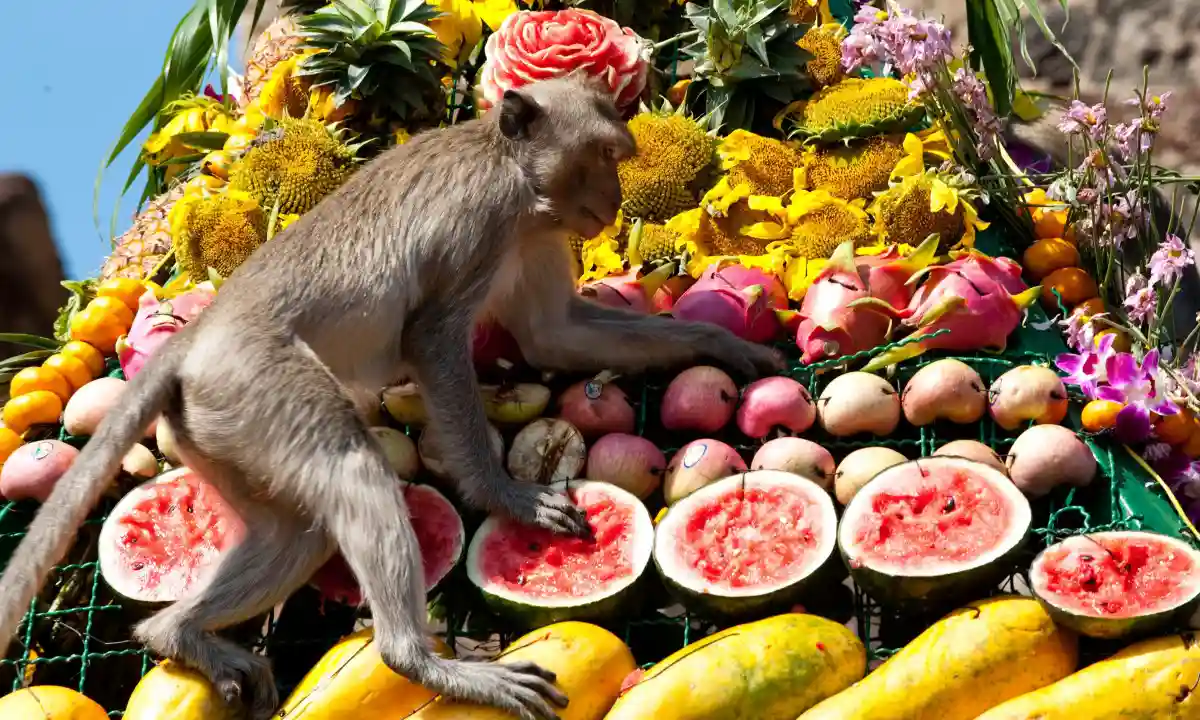
8. Monkey Festival Held at Phra Prang Sam Yod, Muang District, Lop Buri Province Food parade of different types of sweet and savory dishes, Chinese table-style monkey feasting and cultural performances.

9. Vegetarian Festival or in the name of the festival of eating vegetables very famous In terms of a long-standing tradition The Vegetarian Festival in Phuket is held only once a year. For those who have never had a chance to watch the horse parade It's called having to come at once.
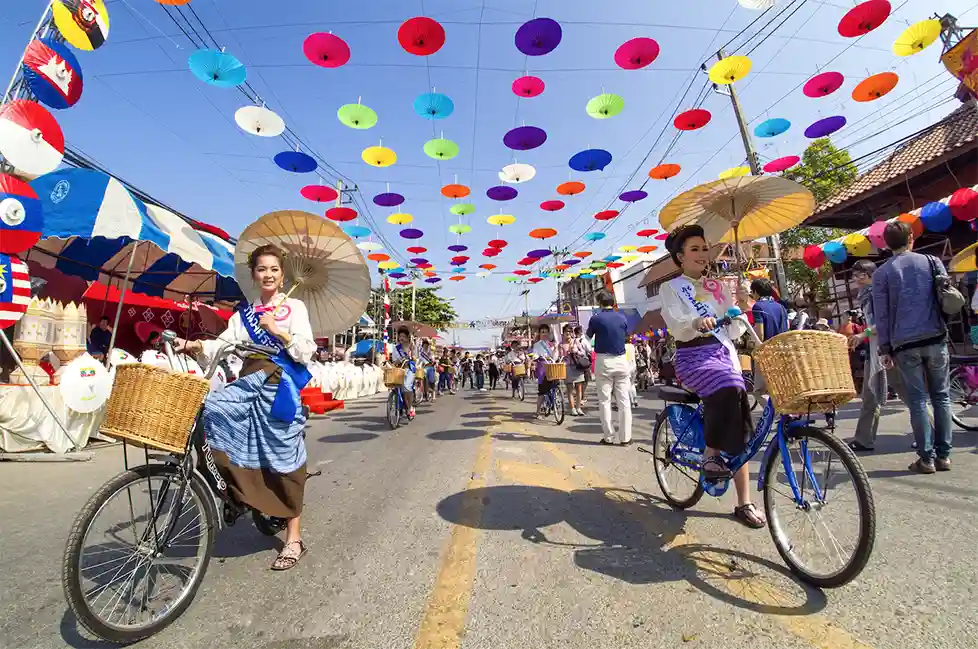
10. Bo Sang Umbrella and San Kamphaeng Handicrafts Festival which will be held every year at Bo Sang Village, Ton Pao Subdistrict, San Kamphaeng District Chiang Mai Province is a festival that has been with Thailand for a long time. It is the most colorful and beautiful festival. which is very difficult to find It is a local handicraft that is interesting and has creative ideas for each piece that is made out. Which gives us an impression when we see it. by bringing an umbrella to decorate the handicraft contest umbrella car culture parade Bringing umbrellas to decorate the storefront or to decorate the front of the house is the identity of this festival. And it gets more and more special every year.
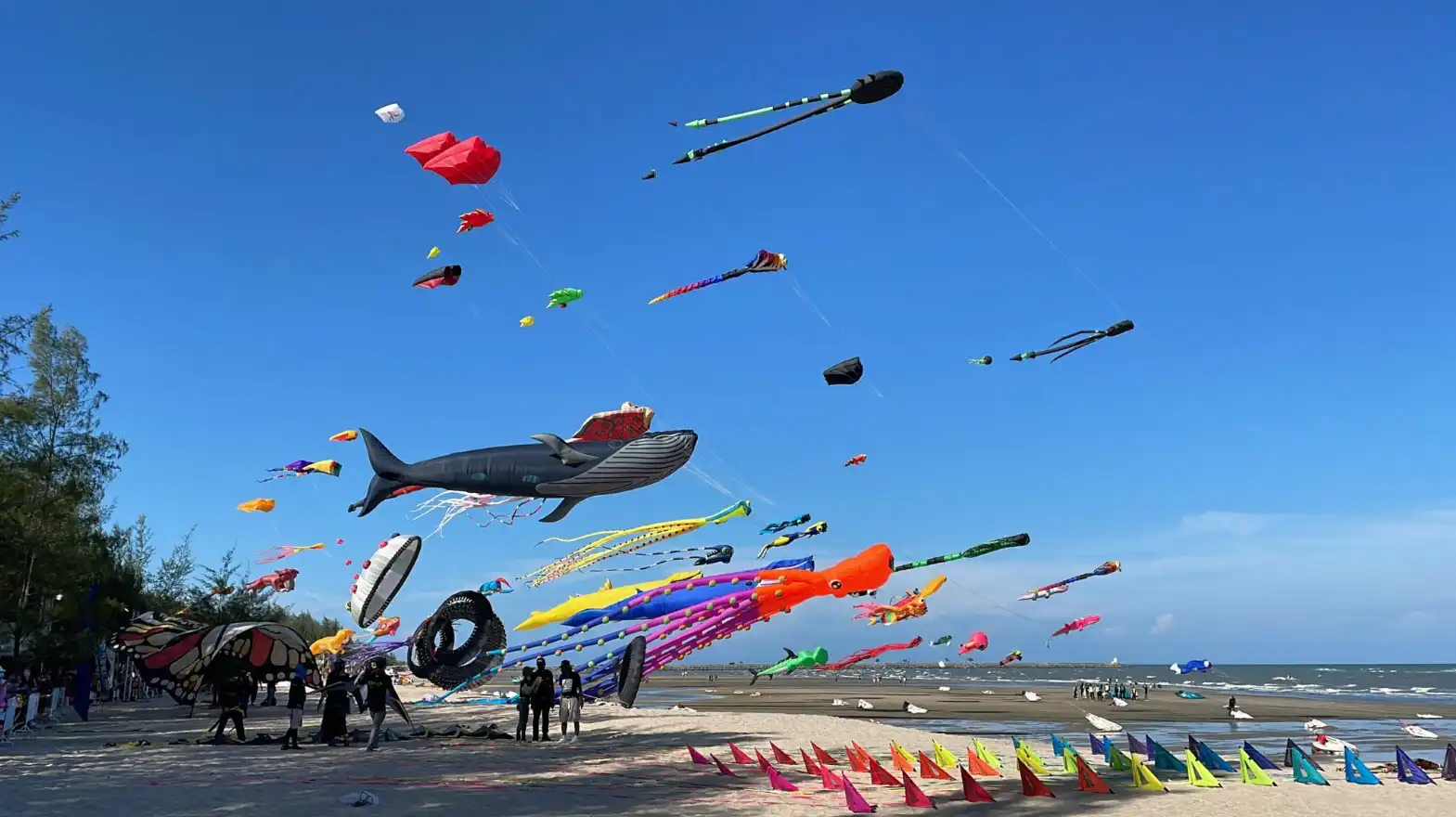
11. International Kite Festival There are many kinds of kite shows from Thailand and abroad. Cha Am Beach, Phetchaburi Province. Kite flying in Thailand has been around for a long time. Since ancient times, in each era, there has been a different mention of kite flying. Reflected in this festival
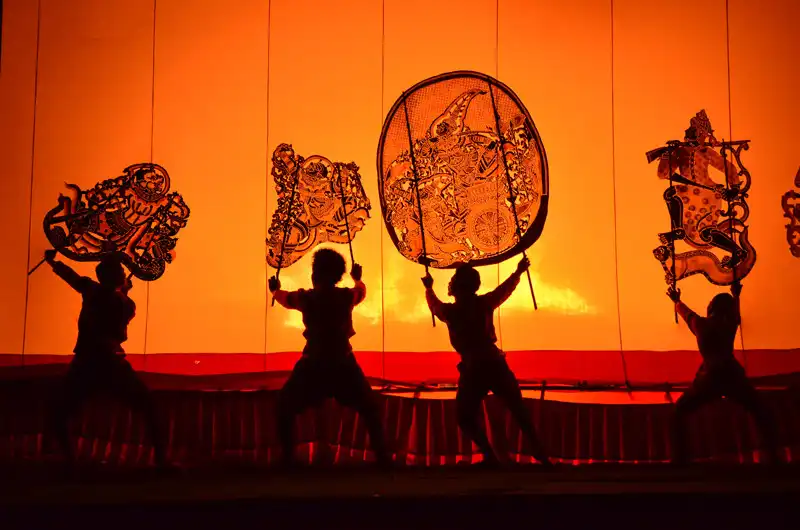
12. Nang Yai Wat Khanon Festival Inheriting high art performances, Nang Yai dances Valuable identity that shows the genius of Thai ancestors in the design of Thai painting patterns. mixed with exquisite carving craftsmanship by showing the theatrical art that moves perfectly and enjoy the activities of organizing retro events issuing various works of art.
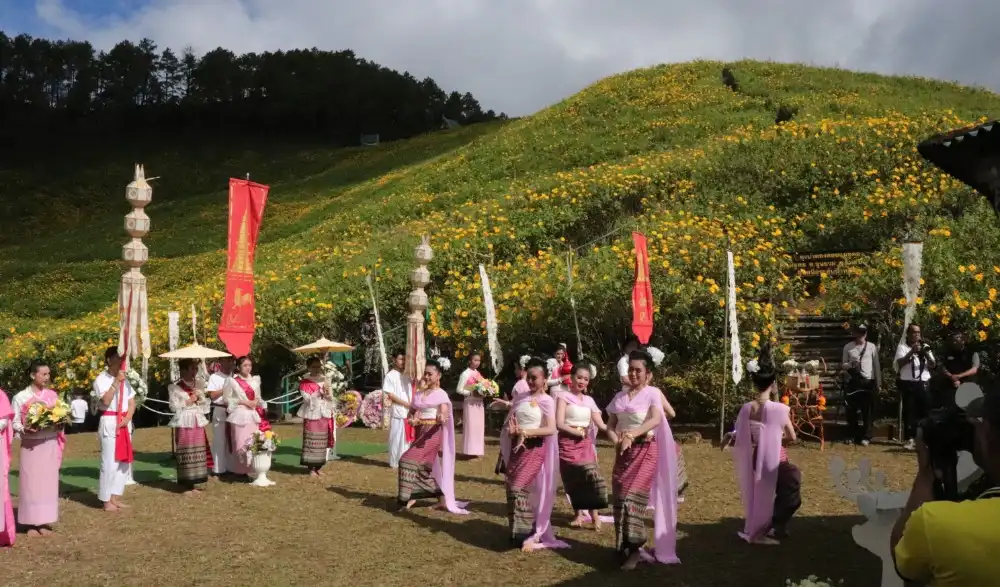
13. Bua Tong Festival A festival indicating the beginning of the tourist season in Mae Hong Son. There is also a festival of folk entertainment, way of life and tribal culture. Including folk performances of local people.
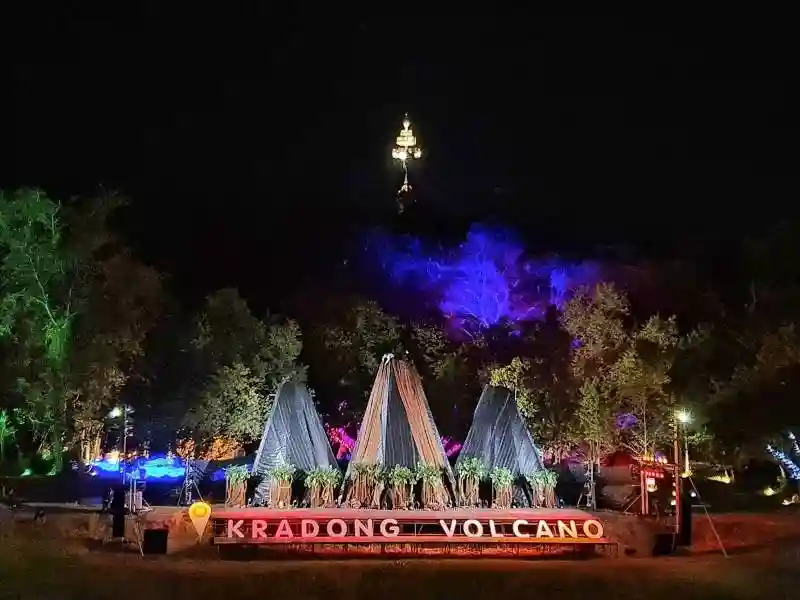
14. Buriram Volcano Festival Meet the spectacular grandeur of faith and faith. with volcanic origin Activities to pray, pay homage to the Buddha, practice Dharma, admire the lights decorated on the magnificent suspension bridge and many other shows.
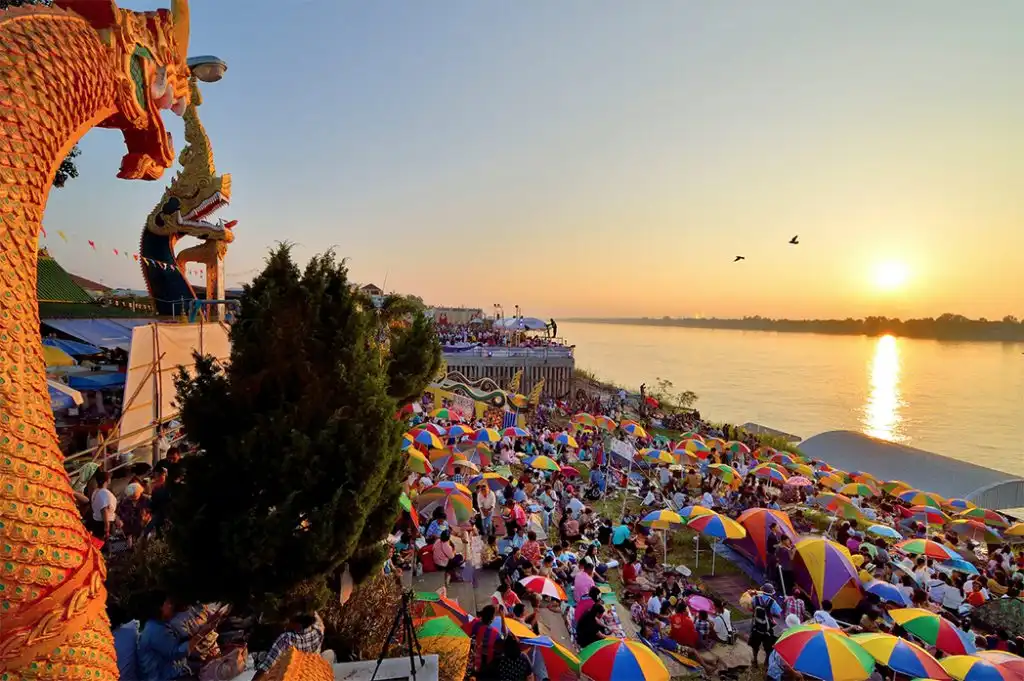
15. Naga Fireball Festival Held during the end of Buddhist Lent every year. in the provinces bordering the Mekong River Especially in Nong Khai province, there will be fireballs rising from the middle of the Mekong River in various areas during the night until the morning. It is amazing for those who see it. The villagers believe that the fire was caused by a serpent living under the Mekong River who sprayed fire to offer as an offering to the Buddha.
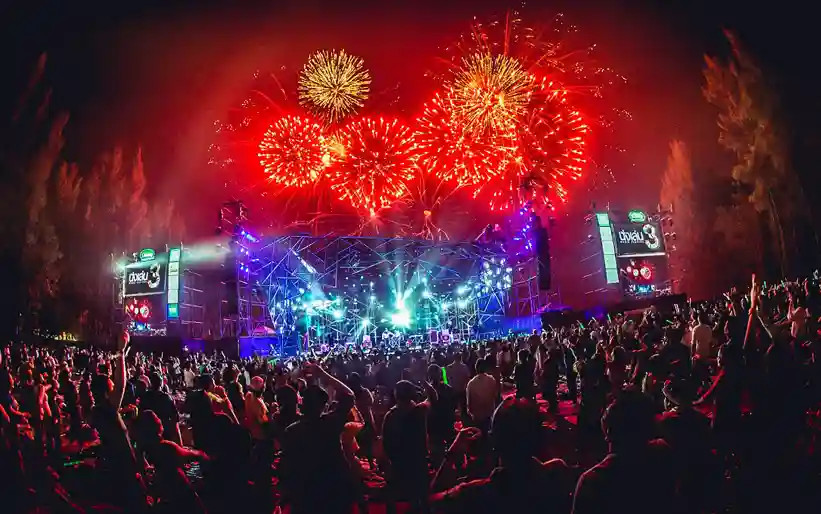
16. เMusic Festival The most popular ones are Creamfields Thailand, Rimpha Music Festival, Chiang Yai Fest, E-san Music Festival Thailand and Big Mountain Music Festival. The fun is not lost in any country in the world.
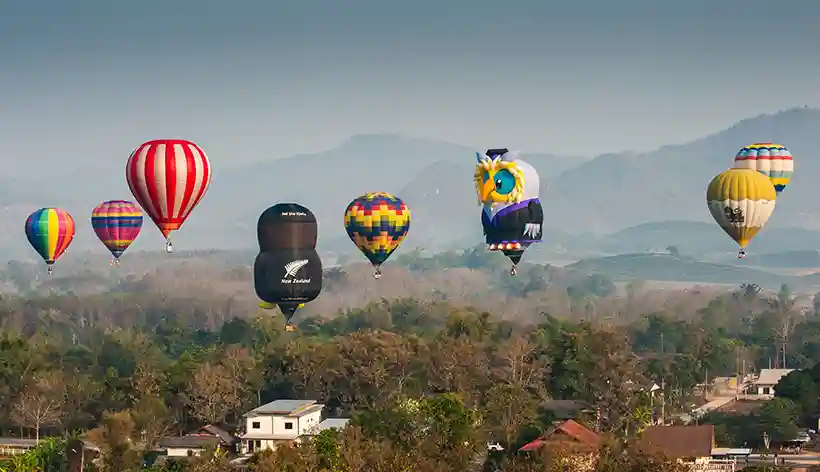
17. International Balloon Festival held in Chiang Rai and Chonburi Province At the event, you will find colorful balloons with strange shapes.
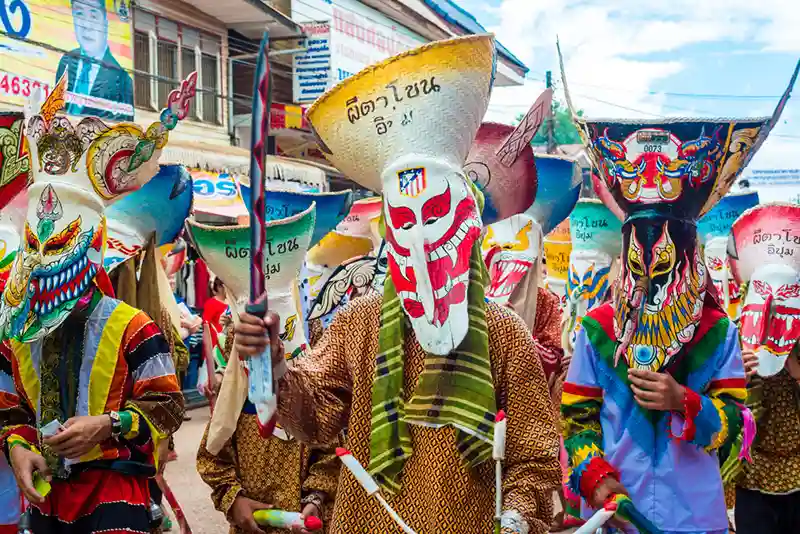
18. Phi Ta Khon Festival Loei Province is a unique and colorful celebration of the International Mask Fair. Phi Ta Khon mask contest Phi Ta Khon Noi Contest performances by various communities, food fairs, art performances, local culture local product display Therefore, it is a big event of Loei Province that many people come to visit the event.
World's top tourist attractions in 4 regions
10 tourist attractions in Thailand that are ranked in the world Thailand is a popular tourist destination. that tourists from around the world want to visit the most Therefore, it is not surprising that rankings of tourist attractions around the world often include famous tourist attractions in Thailand. In addition, many tourist attractions in Thailand are also ranked in the world. The ranking in Thailand is also the best.
According to Visa's latest global travel itinerary survey, It was found that Thailand was ranked as the 4th most worth visiting tourist destination in the world. Thailand is the world's top tourist destination after the United States. United Kingdom and India, while popular tourist destinations in Thailand that tourists around the world search for information through online channels the most are: Bangkok Province, Phuket Province, Chiang Mai Province and Prachuap Khiri Khan Province include:
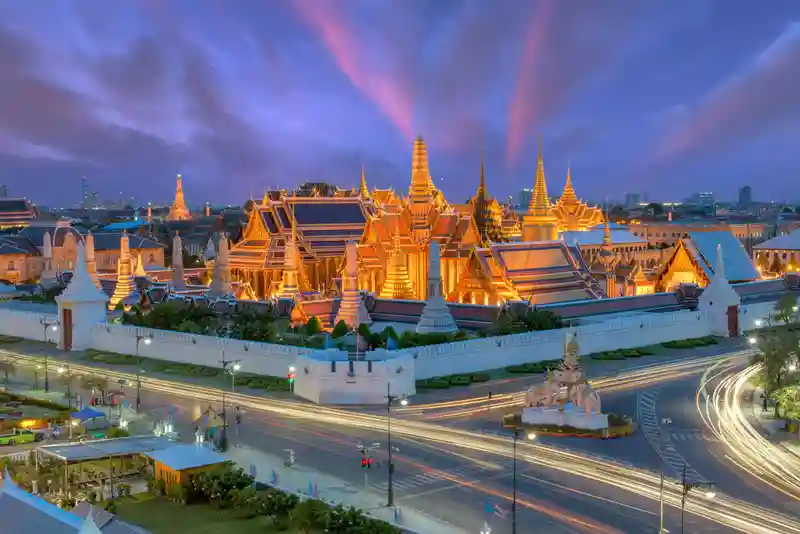
1. Wat Phra Kaew Ranked as one of the 10 sacred areas worth visiting in Asia. Touropia.com, a travel website, has ranked the 10 most famous temples in Asia. which is a sacred place worth visiting India is the country with the highest number of temples worth visiting, while "Wat Phra Kaew", a treasured temple in Thailand, is also on the list this time. Wat Phra Kaew, or its full name, is Wat Phra Sri Rattana Satsadaram It is the most important temple in Bangkok. It can be considered as a priceless temple of the country. It is located in the heart of Bangkok. in the palace area The scenery in that area will be as beautiful as a heavenly city. Surrounded by green grass, looks clean. The highlight points are Emerald Buddha The Buddha statue is made from pure green gemstones of the same texture. Enshrined inside the temple that attracts many Thai and foreign tourists to come see its beauty.
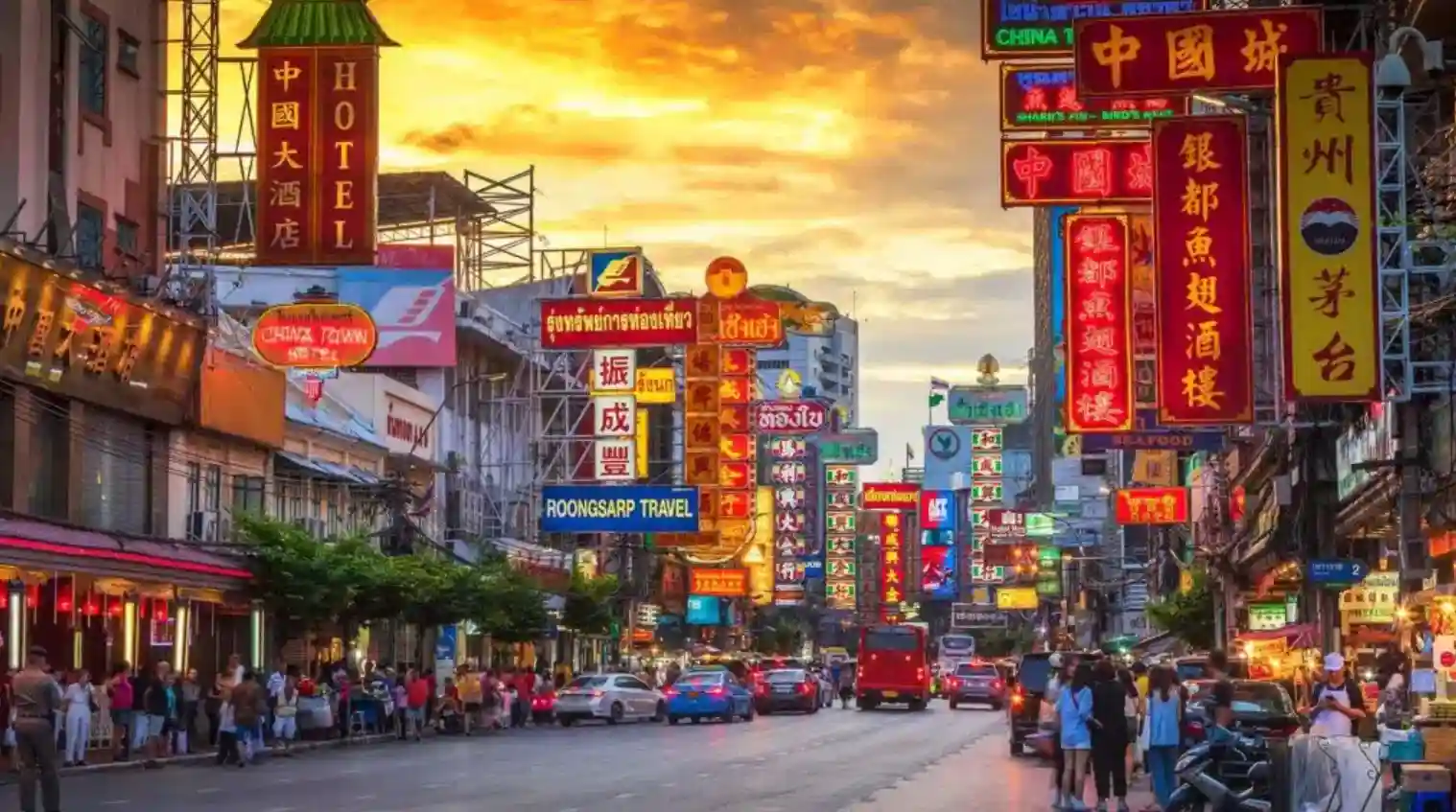
2. Yaowarat Road, Bangkok Province The charm of Yaowarat Famous for its street food, "Yaowaraj Road" has been praised as the 8th coolest street in the world, which came from a survey by Time Out magazine, ranking the 33 coolest streets in the world. It interviewed more than 20,000 people around the world and had experts rank the world's top roads. In terms of food, fun, culture and community, Yaowarat Road is home to many Chinese and Thai-Chinese communities. It is classified as a commercial business area, finance and banking, gold shops, restaurants, shops, etc., as well as one of the main tourist attractions in Bangkok.
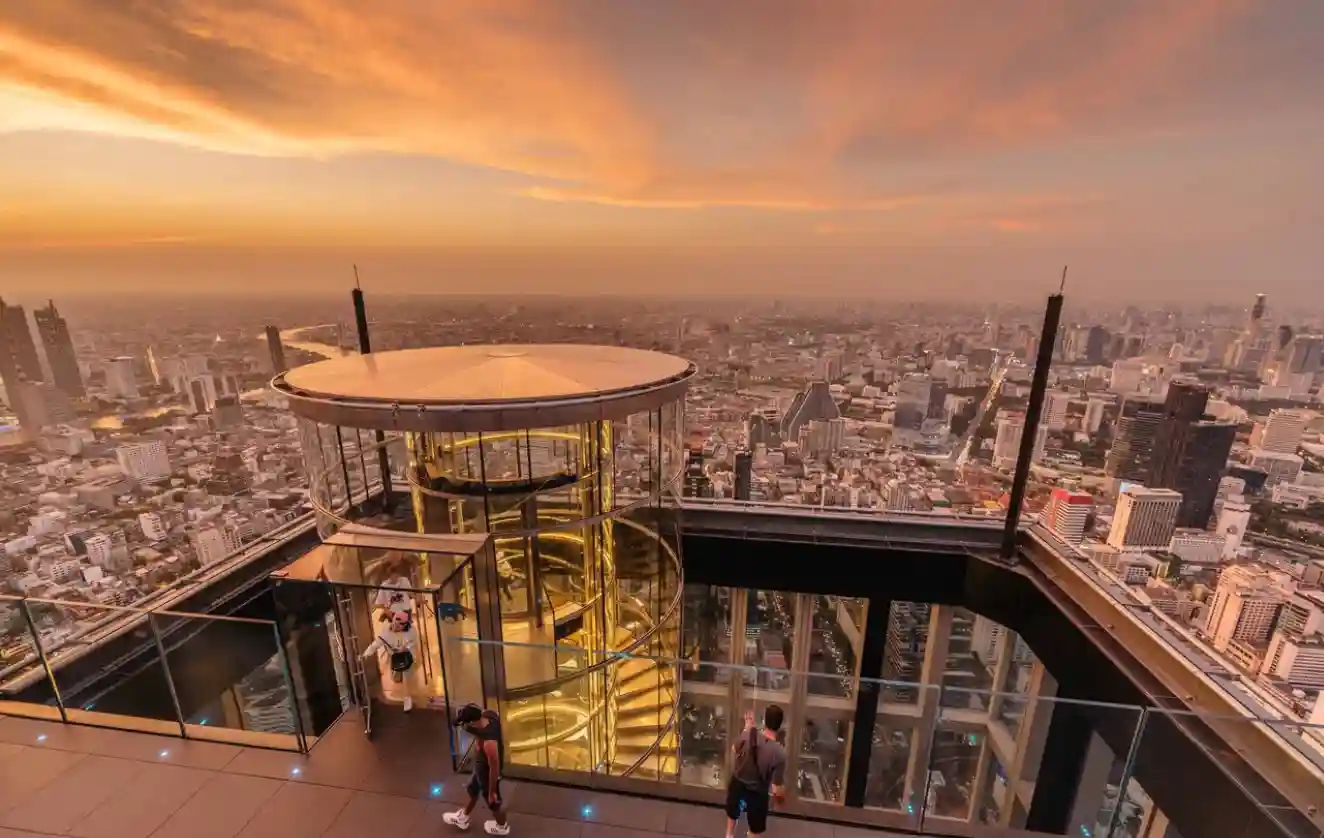
3. Mahanakhon Skywalk, Bangkok Province New landmark on the tallest building in Thailand Thailand's new world-class tourist landmark in the heart of Bangkok. The highest 360-degree rooftop observation deck in Thailand at a height of 314 meters.
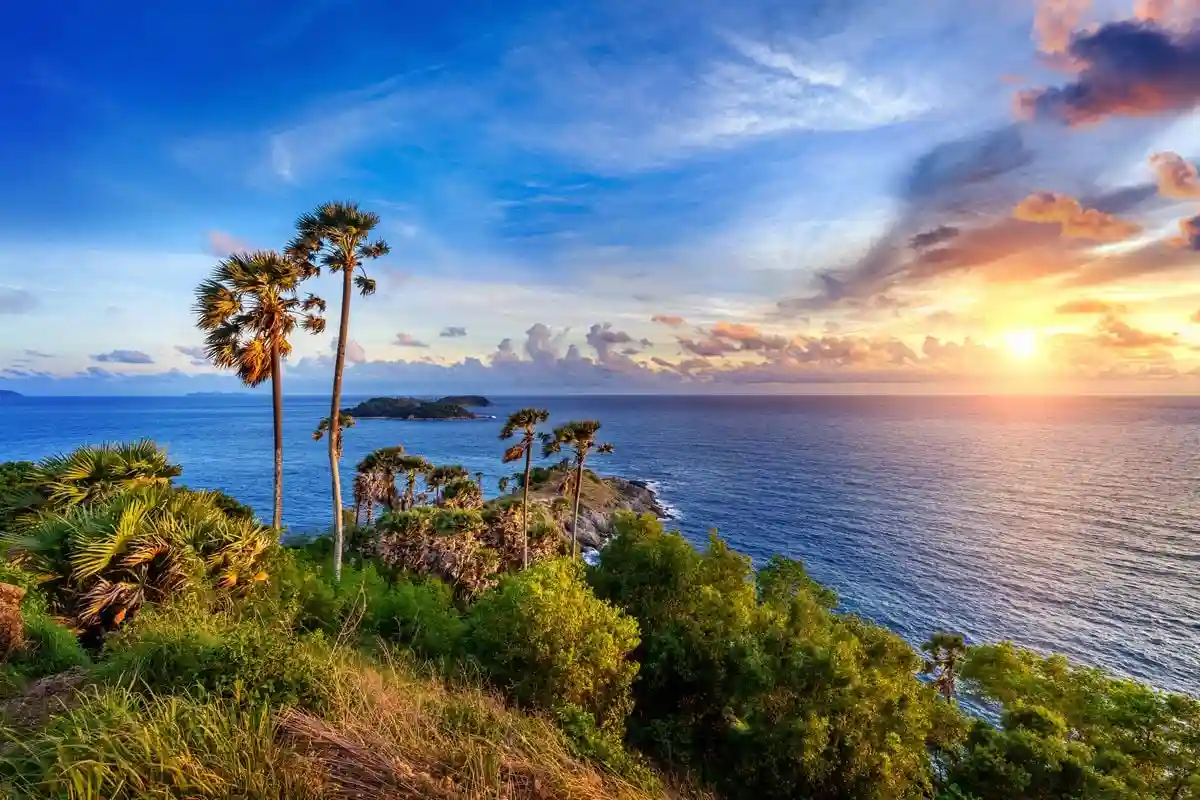
4. Laem Phromthep, Phuket Province Saying this name, no one probably doesn't know it and I believe that many people have had the opportunity to experience this world-ranked tourist attraction located in Phuket province. It is a cape with high cliffs at the southern end of Phuket Island. It is classified as one of the viewpoints. See one of the most beautiful sunsets in the world. The scenery is beautiful and full of charm. You will see Laem Phromthep stretching into the sea. Peculiar Glass Island When you bend down a little, you will find a line of natural black rocks and sea waves splashing on the rocks until they are foamy. Beautiful in another way.
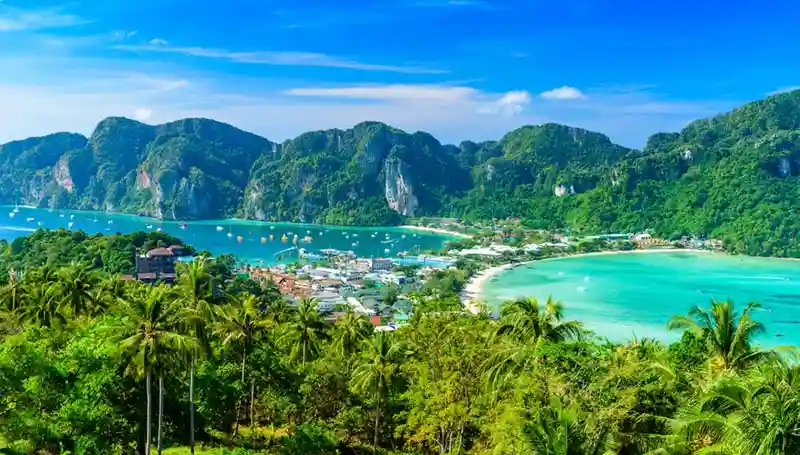
5. Phi Phi Island, Phuket Province A paradise island for sea lovers that is home to many beautiful beaches and diving spots ranked in the world. It can be said to be one of the most famous islands that tourists have dubbed the most beautiful islands. Because this island has a relatively wide area covered by the sea. And there is also a relatively rich underwater ecosystem. As a result, the sea water in this area is full of clarity and cleanness, suitable for traveling to sunbathe. and have fun playing in the water Moreover, within the island there are many activities such as snorkeling and coral viewing. Or even take a walk around the beautiful viewpoints and surrounding islands.
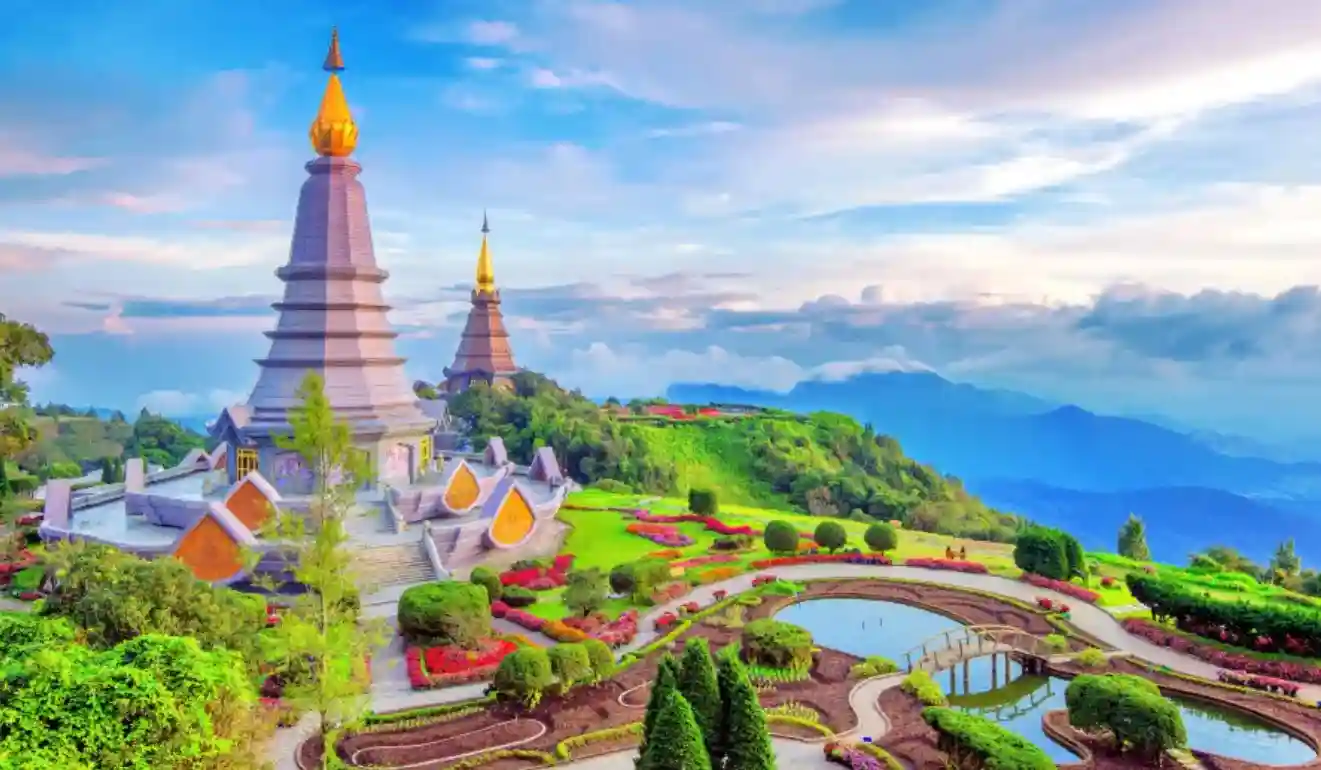
6. Doi Inthanon Which from the famous travel website "Travel Plus Leisure", the most popular travel website has ranked The best tourist attractions of 2017 from the votes of tourists who visited the website ranked Doi Inthanon as number 3 in the world, the highest peak in Thailand. It is considered another important landmark in Chiang Mai Province. It can be said to be one of the most popular tourist attractions in the northern region.
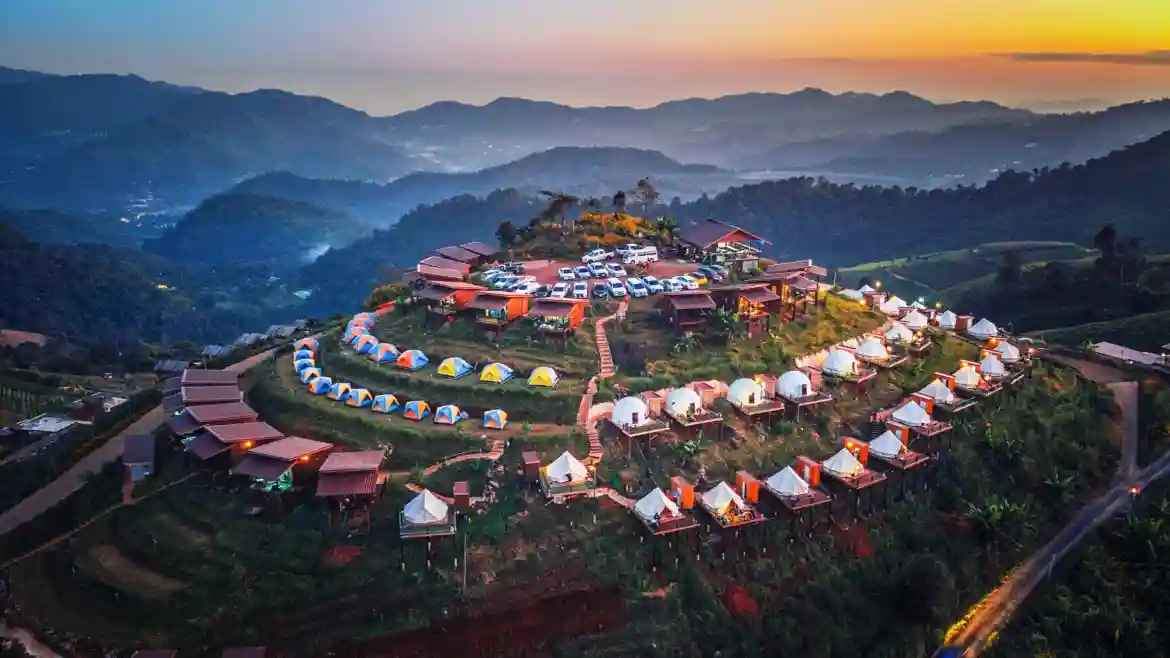
7. Mon Jam Chiang Mai Province, world-ranked view, weather conditions at Mon Jam accommodation, see the most beautiful and magnificent view, cool and comfortable all year round. Therefore, it is suitable for traveling to breathe fresh air. The way of life of the hill people.
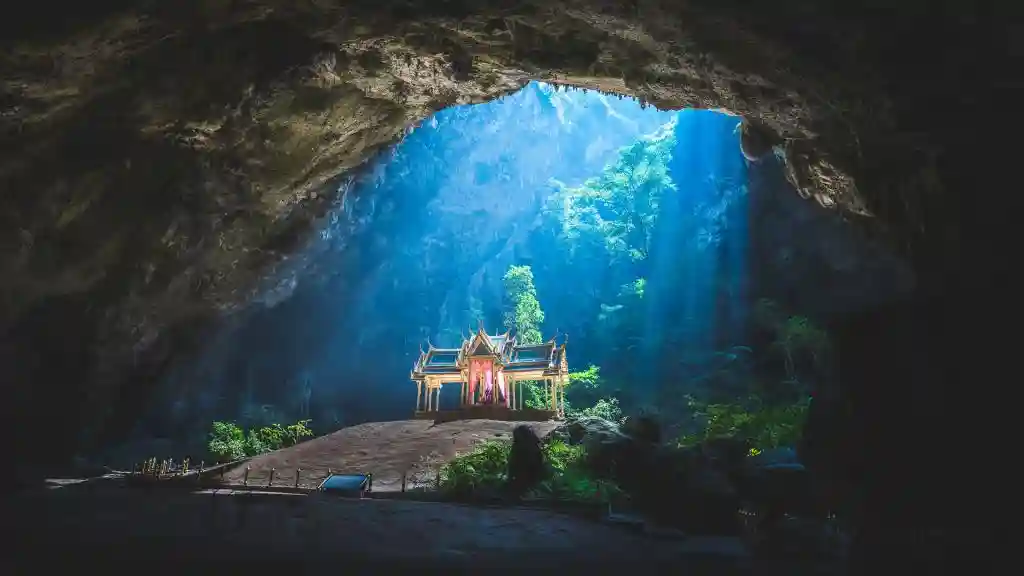
8. Phraya Nakhon Cave Prachuap Khiri Khan Province Located in the area of Khao Sam Roi Yot National Park It has become a hot topic with this Hua Hin tourist attraction from the Wa-Japan page, presenting the trend on Twitter of Japanese netizens that Right now, there is a tourist attraction in Thailand that many Japanese people have retweeted. It is said that This place was very similar to the world of an RPG and an anime world. Make it trend on Twitter Tourists around the world want to come and experience the beauty of Phraya Nakhon Cave.
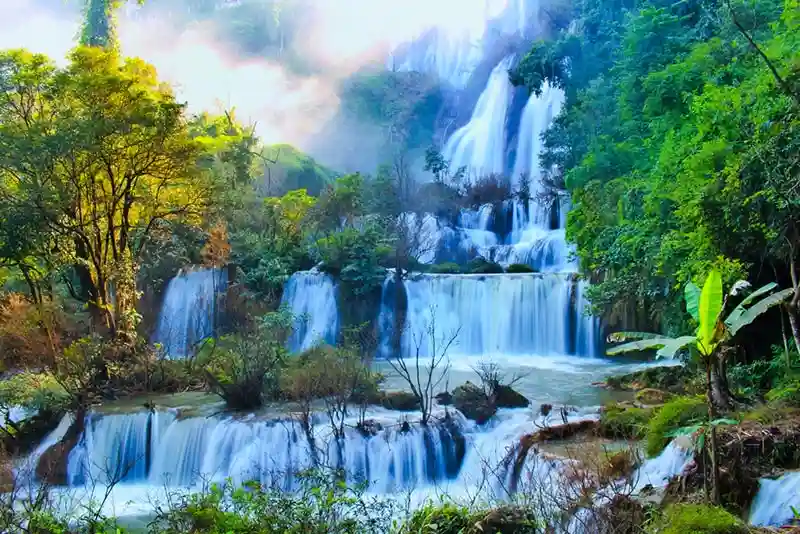
9. Tee Lo Su Waterfall, Tak Province, located in Umphang Wildlife Sanctuary. It is said to be the most beautiful waterfall in Thailand. And is well known to foreigners around the world. Tee Lor Su is a Karen language meaning black waterfall. The waterfall has the appearance of a large limestone mountain waterfall. Located at an altitude of 900 meters above sea level, the width of the waterfall is approximately 500 meters, flowing in cascades with a height of approximately 300 meters, surrounded by a complete rainforest.
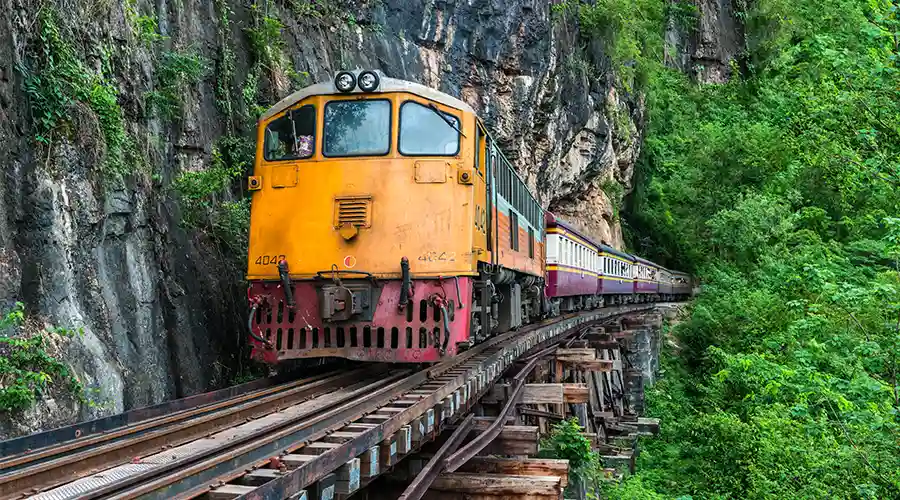
10. Death Railway Built during World War II by the Japanese government. It is now a historical site. and important tourist attractions of the world The scenery along this route is very beautiful. Especially around Tham Krasae. The train route will travel along the cliff base along the Kwai Noi River. At present, this railway has its final destination at Ban Tha Sao or Namtok Station. The distance from Kanchanaburi Station to Namtok Station is approximately 77 kilometers.
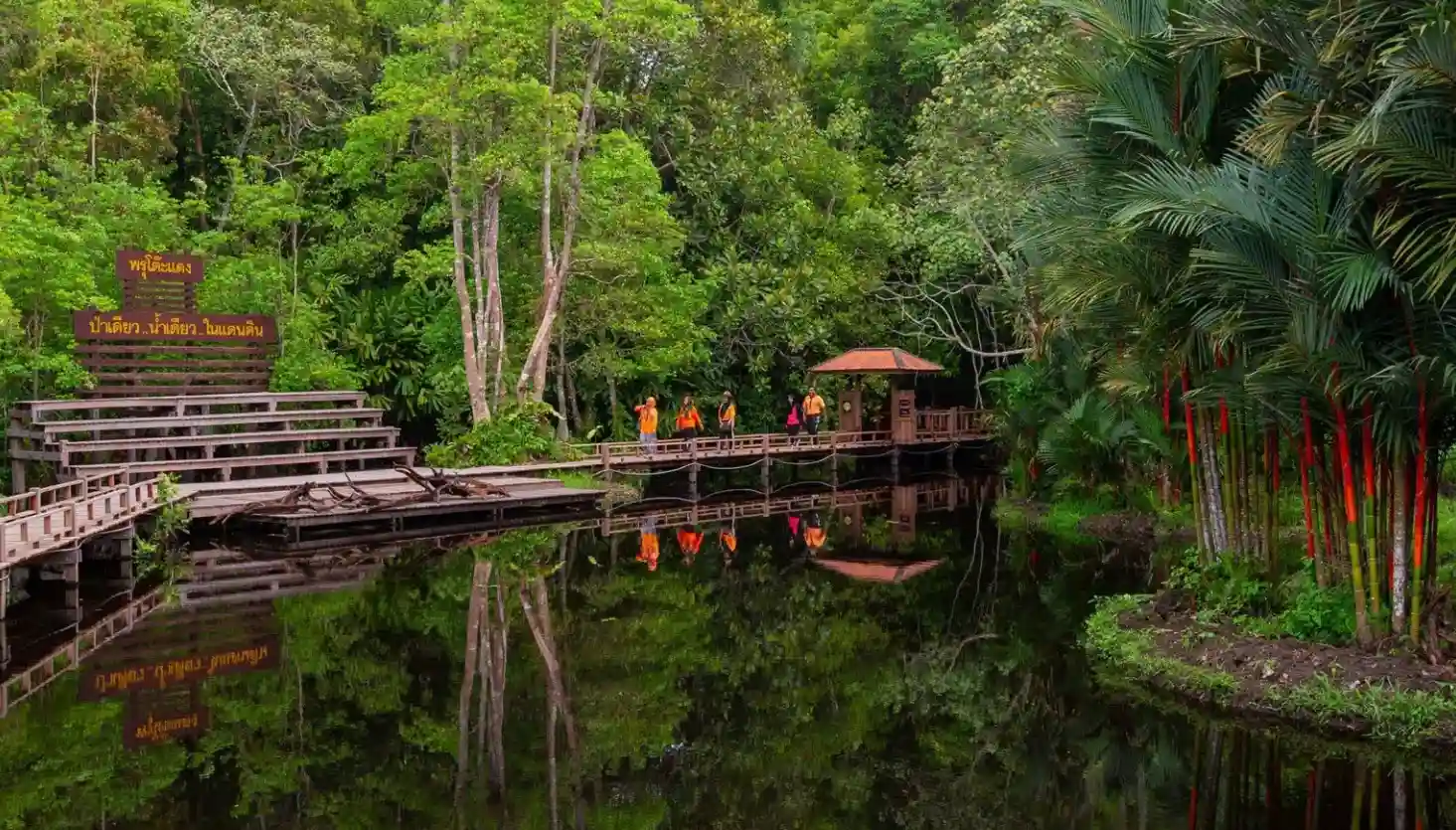
11. Toh Daeng Swamp Forest The last and only intact peat swamp forest in Thailand. It is a forest that is rich in wildlife and plants. The ecosystem of the swamp forest is an amazing feature of nature. that creates all life to be interconnected and interesting to learn from You will find perennial plants with strong root and branch systems that spread out and hang together. It is an attraction for both Thai and foreign tourists. and foreigners because it is a peat swamp forest that is fertile and is very interesting to study and research.
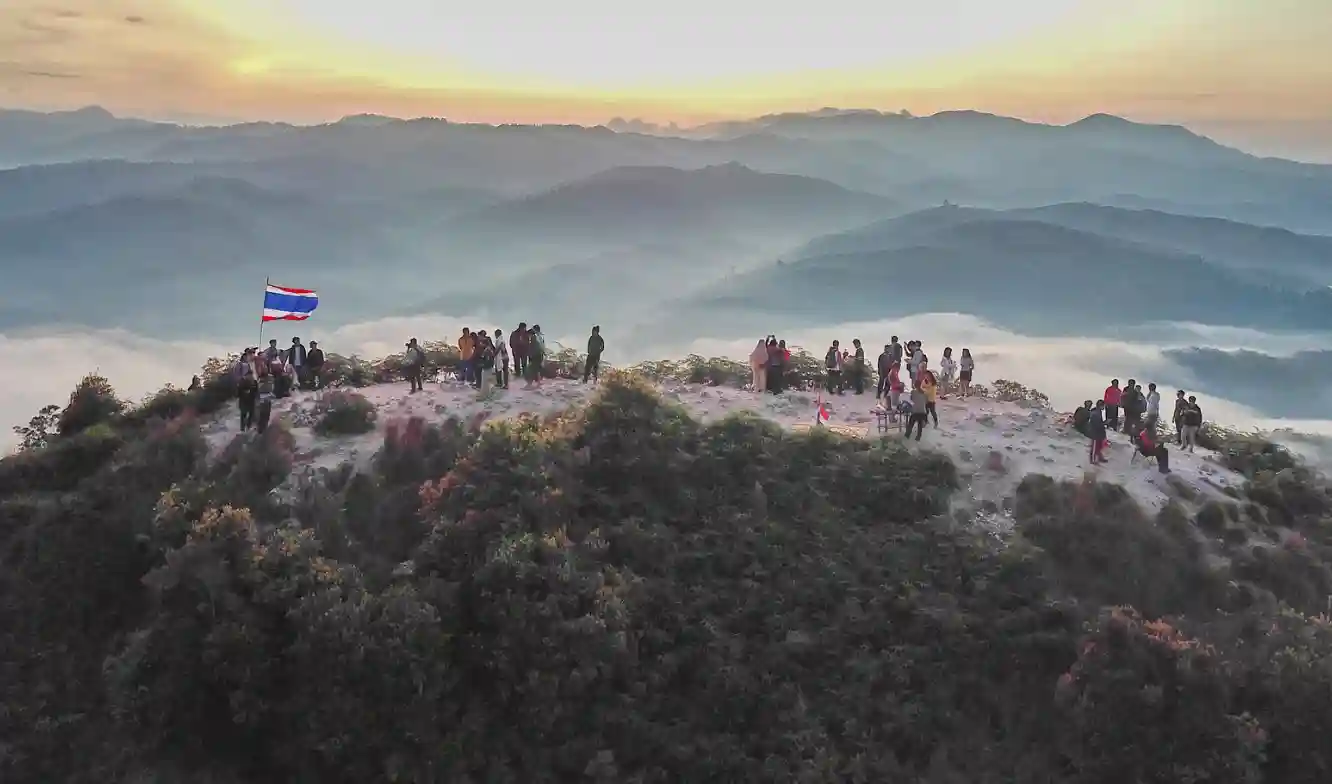
12. Gunung Silipat It is a very beautiful spot to view the sea of mist. You can see a 360 degree view. The most beautiful view period is from February - April. You can take a one-day trip by staying in Betong District in the morning. Which is only 500 meters from the viewpoint.
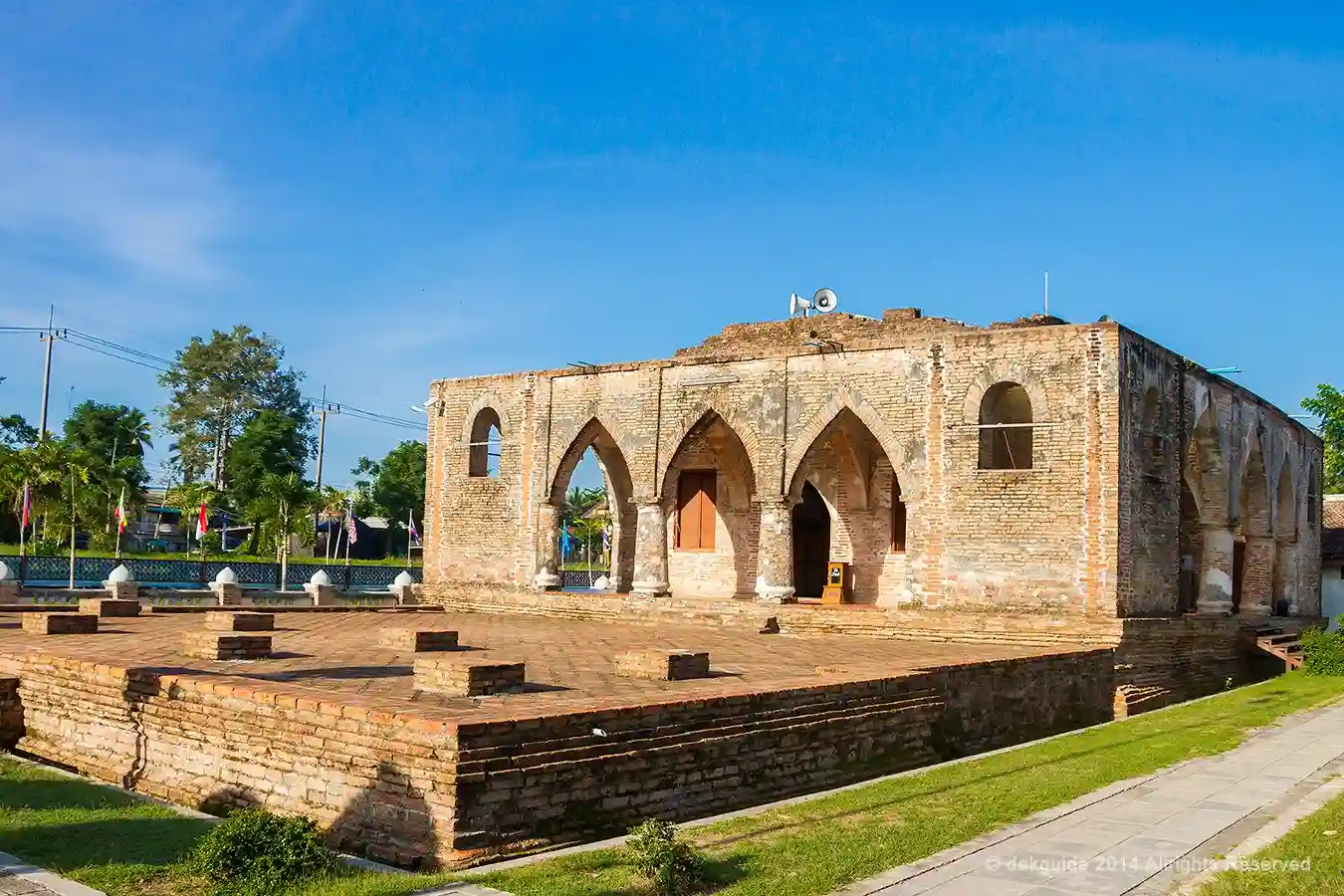
13. Yarang Ancient City It is one of the largest historical communities in the southern part of Thailand. and is believed to be the location of an ancient kingdom named "Langkasuka" or "Lang Ya Siao" as evidenced in Chinese, Javanese, Malay and Arabian documents. By the nature of the ancient city of Yarang, it is assumed that it will have an oval-shaped city plan. Large in an area of approximately 9 square kilometers. and is a city that has been built on top of 3 cities, expanding and connecting together.
